Marketing Promotions and Data Analytics
VerifiedAdded on 2020/11/30
|35
|12072
|290
Report
AI Summary
This assignment delves into the analysis of marketing promotions and their implications for data analytics. It requires students to examine various promotional strategies, understand how they influence consumer behavior, and explore the role of data in optimizing marketing campaigns. The focus is on identifying key trends, evaluating the effectiveness of different promotional approaches, and outlining best practices for data-driven marketing decision-making.
Contribute Materials
Your contribution can guide someone’s learning journey. Share your
documents today.
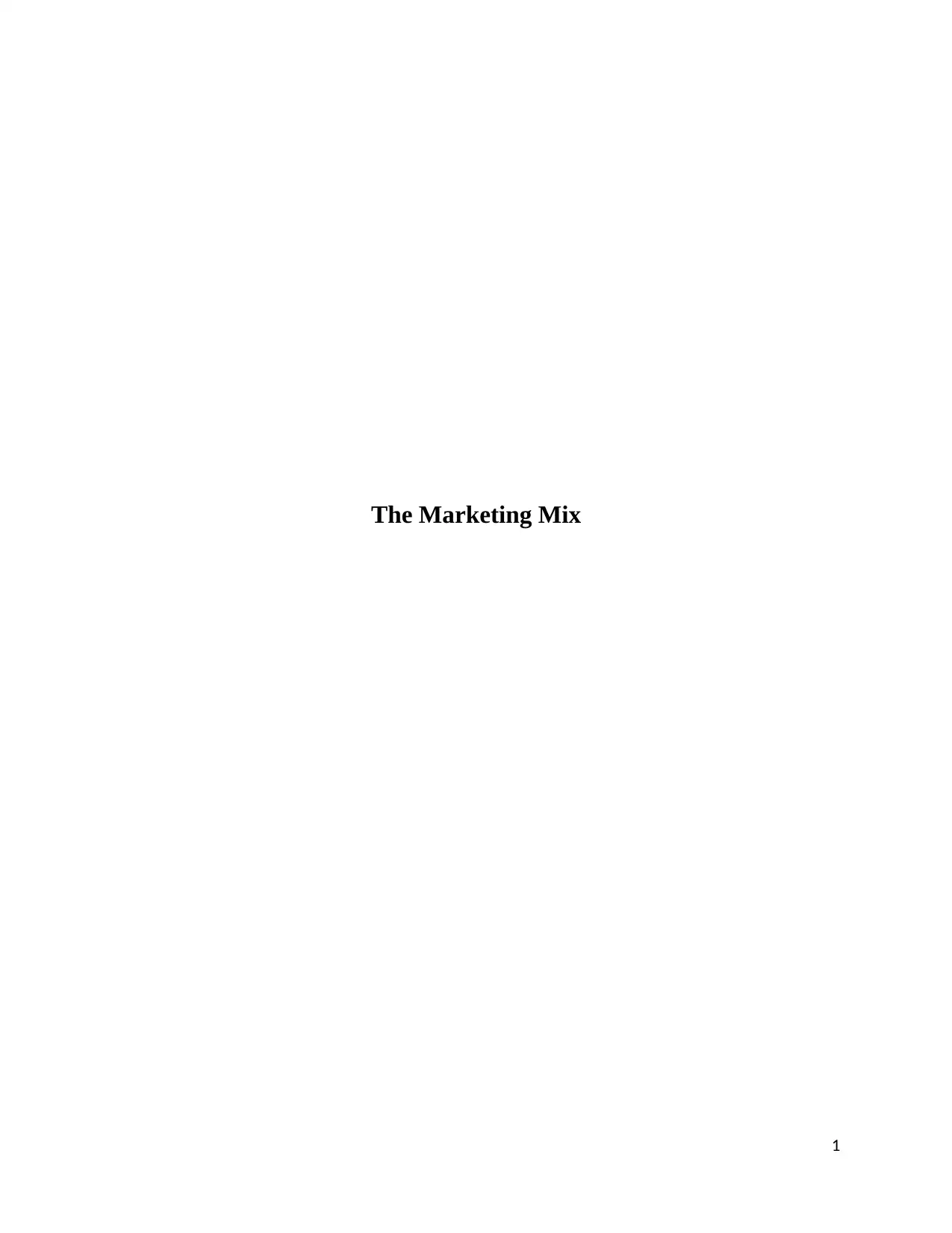
The Marketing Mix
1
1
Secure Best Marks with AI Grader
Need help grading? Try our AI Grader for instant feedback on your assignments.
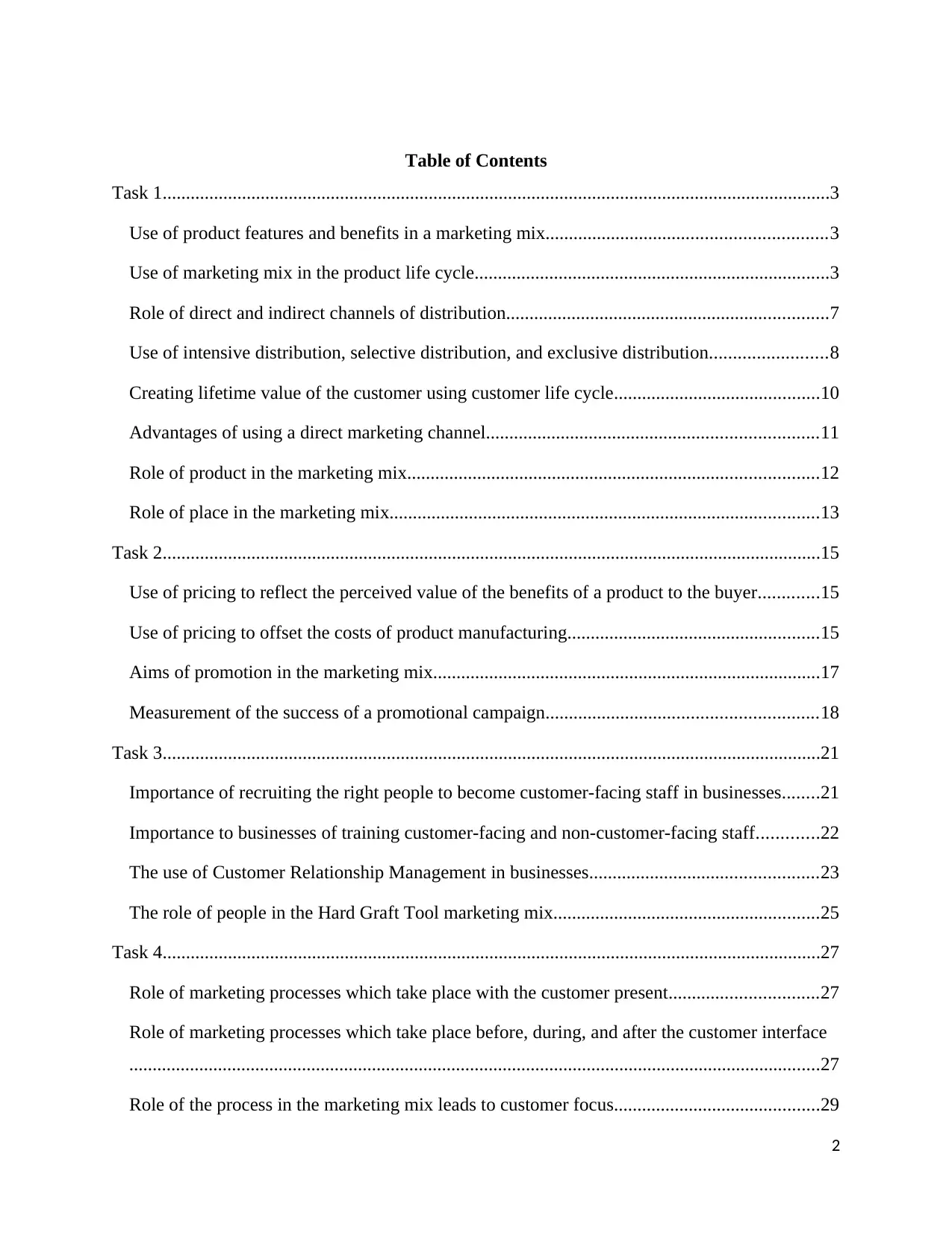
Table of Contents
Task 1...............................................................................................................................................3
Use of product features and benefits in a marketing mix............................................................3
Use of marketing mix in the product life cycle............................................................................3
Role of direct and indirect channels of distribution.....................................................................7
Use of intensive distribution, selective distribution, and exclusive distribution.........................8
Creating lifetime value of the customer using customer life cycle............................................10
Advantages of using a direct marketing channel.......................................................................11
Role of product in the marketing mix........................................................................................12
Role of place in the marketing mix............................................................................................13
Task 2.............................................................................................................................................15
Use of pricing to reflect the perceived value of the benefits of a product to the buyer.............15
Use of pricing to offset the costs of product manufacturing......................................................15
Aims of promotion in the marketing mix...................................................................................17
Measurement of the success of a promotional campaign..........................................................18
Task 3.............................................................................................................................................21
Importance of recruiting the right people to become customer-facing staff in businesses........21
Importance to businesses of training customer-facing and non-customer-facing staff.............22
The use of Customer Relationship Management in businesses.................................................23
The role of people in the Hard Graft Tool marketing mix.........................................................25
Task 4.............................................................................................................................................27
Role of marketing processes which take place with the customer present................................27
Role of marketing processes which take place before, during, and after the customer interface
....................................................................................................................................................27
Role of the process in the marketing mix leads to customer focus............................................29
2
Task 1...............................................................................................................................................3
Use of product features and benefits in a marketing mix............................................................3
Use of marketing mix in the product life cycle............................................................................3
Role of direct and indirect channels of distribution.....................................................................7
Use of intensive distribution, selective distribution, and exclusive distribution.........................8
Creating lifetime value of the customer using customer life cycle............................................10
Advantages of using a direct marketing channel.......................................................................11
Role of product in the marketing mix........................................................................................12
Role of place in the marketing mix............................................................................................13
Task 2.............................................................................................................................................15
Use of pricing to reflect the perceived value of the benefits of a product to the buyer.............15
Use of pricing to offset the costs of product manufacturing......................................................15
Aims of promotion in the marketing mix...................................................................................17
Measurement of the success of a promotional campaign..........................................................18
Task 3.............................................................................................................................................21
Importance of recruiting the right people to become customer-facing staff in businesses........21
Importance to businesses of training customer-facing and non-customer-facing staff.............22
The use of Customer Relationship Management in businesses.................................................23
The role of people in the Hard Graft Tool marketing mix.........................................................25
Task 4.............................................................................................................................................27
Role of marketing processes which take place with the customer present................................27
Role of marketing processes which take place before, during, and after the customer interface
....................................................................................................................................................27
Role of the process in the marketing mix leads to customer focus............................................29
2

Role of the process in the Hard Graft Tool marketing mix.......................................................30
Role of physical evidence in the Hard Graft Tool marketing mix.............................................31
Reference...................................................................................................................................32
3
Role of physical evidence in the Hard Graft Tool marketing mix.............................................31
Reference...................................................................................................................................32
3
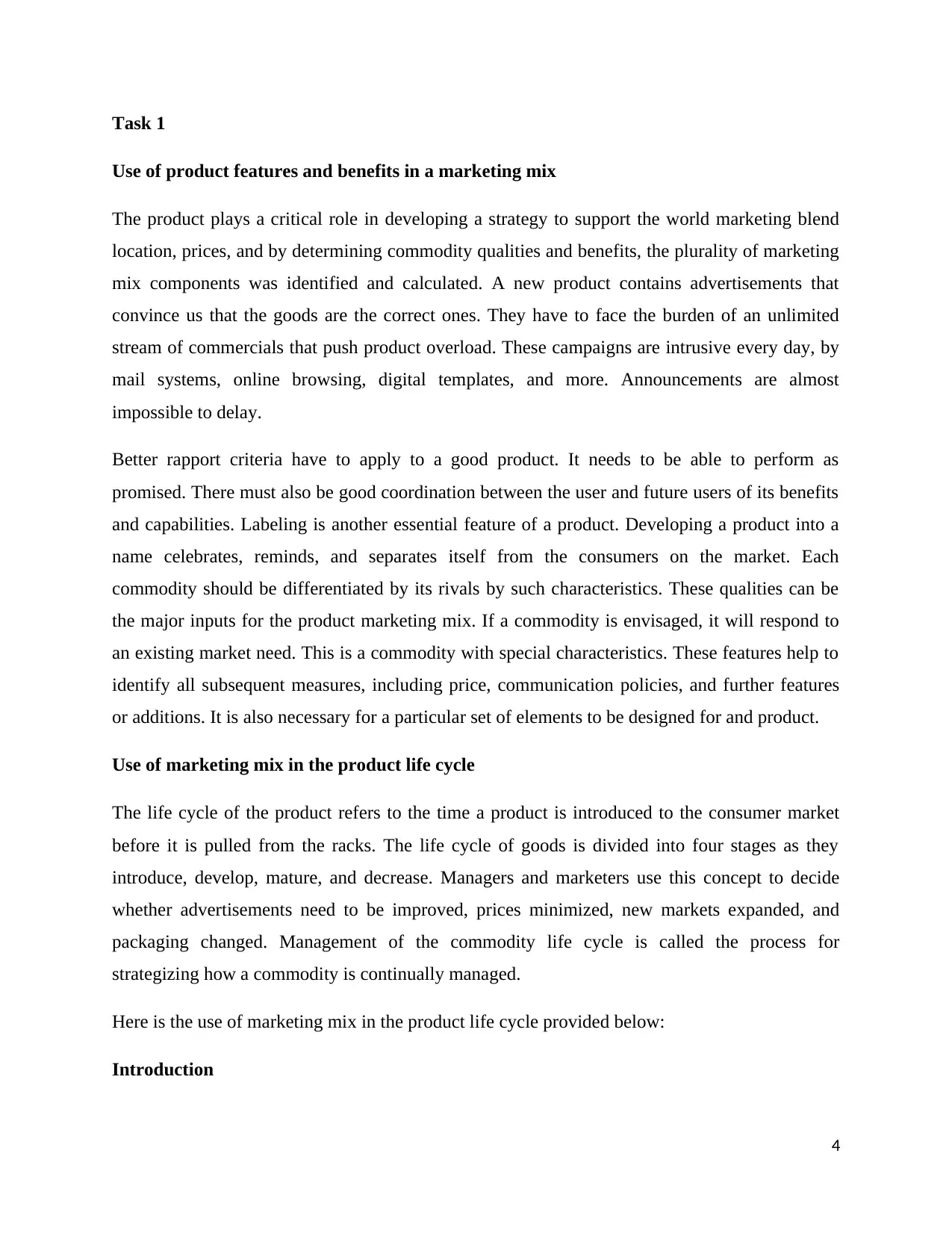
Task 1
Use of product features and benefits in a marketing mix
The product plays a critical role in developing a strategy to support the world marketing blend
location, prices, and by determining commodity qualities and benefits, the plurality of marketing
mix components was identified and calculated. A new product contains advertisements that
convince us that the goods are the correct ones. They have to face the burden of an unlimited
stream of commercials that push product overload. These campaigns are intrusive every day, by
mail systems, online browsing, digital templates, and more. Announcements are almost
impossible to delay.
Better rapport criteria have to apply to a good product. It needs to be able to perform as
promised. There must also be good coordination between the user and future users of its benefits
and capabilities. Labeling is another essential feature of a product. Developing a product into a
name celebrates, reminds, and separates itself from the consumers on the market. Each
commodity should be differentiated by its rivals by such characteristics. These qualities can be
the major inputs for the product marketing mix. If a commodity is envisaged, it will respond to
an existing market need. This is a commodity with special characteristics. These features help to
identify all subsequent measures, including price, communication policies, and further features
or additions. It is also necessary for a particular set of elements to be designed for and product.
Use of marketing mix in the product life cycle
The life cycle of the product refers to the time a product is introduced to the consumer market
before it is pulled from the racks. The life cycle of goods is divided into four stages as they
introduce, develop, mature, and decrease. Managers and marketers use this concept to decide
whether advertisements need to be improved, prices minimized, new markets expanded, and
packaging changed. Management of the commodity life cycle is called the process for
strategizing how a commodity is continually managed.
Here is the use of marketing mix in the product life cycle provided below:
Introduction
4
Use of product features and benefits in a marketing mix
The product plays a critical role in developing a strategy to support the world marketing blend
location, prices, and by determining commodity qualities and benefits, the plurality of marketing
mix components was identified and calculated. A new product contains advertisements that
convince us that the goods are the correct ones. They have to face the burden of an unlimited
stream of commercials that push product overload. These campaigns are intrusive every day, by
mail systems, online browsing, digital templates, and more. Announcements are almost
impossible to delay.
Better rapport criteria have to apply to a good product. It needs to be able to perform as
promised. There must also be good coordination between the user and future users of its benefits
and capabilities. Labeling is another essential feature of a product. Developing a product into a
name celebrates, reminds, and separates itself from the consumers on the market. Each
commodity should be differentiated by its rivals by such characteristics. These qualities can be
the major inputs for the product marketing mix. If a commodity is envisaged, it will respond to
an existing market need. This is a commodity with special characteristics. These features help to
identify all subsequent measures, including price, communication policies, and further features
or additions. It is also necessary for a particular set of elements to be designed for and product.
Use of marketing mix in the product life cycle
The life cycle of the product refers to the time a product is introduced to the consumer market
before it is pulled from the racks. The life cycle of goods is divided into four stages as they
introduce, develop, mature, and decrease. Managers and marketers use this concept to decide
whether advertisements need to be improved, prices minimized, new markets expanded, and
packaging changed. Management of the commodity life cycle is called the process for
strategizing how a commodity is continually managed.
Here is the use of marketing mix in the product life cycle provided below:
Introduction
4
Secure Best Marks with AI Grader
Need help grading? Try our AI Grader for instant feedback on your assignments.
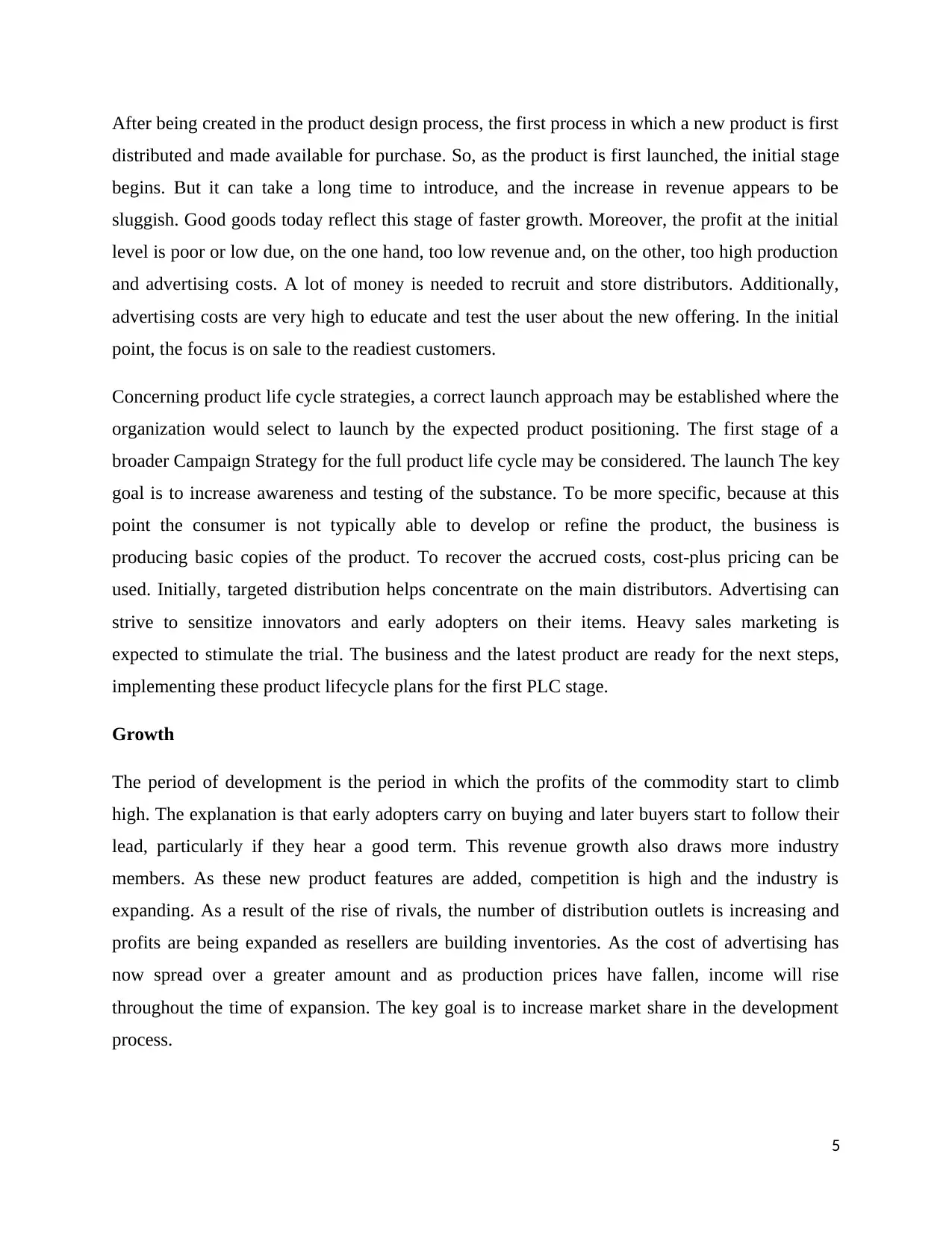
After being created in the product design process, the first process in which a new product is first
distributed and made available for purchase. So, as the product is first launched, the initial stage
begins. But it can take a long time to introduce, and the increase in revenue appears to be
sluggish. Good goods today reflect this stage of faster growth. Moreover, the profit at the initial
level is poor or low due, on the one hand, too low revenue and, on the other, too high production
and advertising costs. A lot of money is needed to recruit and store distributors. Additionally,
advertising costs are very high to educate and test the user about the new offering. In the initial
point, the focus is on sale to the readiest customers.
Concerning product life cycle strategies, a correct launch approach may be established where the
organization would select to launch by the expected product positioning. The first stage of a
broader Campaign Strategy for the full product life cycle may be considered. The launch The key
goal is to increase awareness and testing of the substance. To be more specific, because at this
point the consumer is not typically able to develop or refine the product, the business is
producing basic copies of the product. To recover the accrued costs, cost-plus pricing can be
used. Initially, targeted distribution helps concentrate on the main distributors. Advertising can
strive to sensitize innovators and early adopters on their items. Heavy sales marketing is
expected to stimulate the trial. The business and the latest product are ready for the next steps,
implementing these product lifecycle plans for the first PLC stage.
Growth
The period of development is the period in which the profits of the commodity start to climb
high. The explanation is that early adopters carry on buying and later buyers start to follow their
lead, particularly if they hear a good term. This revenue growth also draws more industry
members. As these new product features are added, competition is high and the industry is
expanding. As a result of the rise of rivals, the number of distribution outlets is increasing and
profits are being expanded as resellers are building inventories. As the cost of advertising has
now spread over a greater amount and as production prices have fallen, income will rise
throughout the time of expansion. The key goal is to increase market share in the development
process.
5
distributed and made available for purchase. So, as the product is first launched, the initial stage
begins. But it can take a long time to introduce, and the increase in revenue appears to be
sluggish. Good goods today reflect this stage of faster growth. Moreover, the profit at the initial
level is poor or low due, on the one hand, too low revenue and, on the other, too high production
and advertising costs. A lot of money is needed to recruit and store distributors. Additionally,
advertising costs are very high to educate and test the user about the new offering. In the initial
point, the focus is on sale to the readiest customers.
Concerning product life cycle strategies, a correct launch approach may be established where the
organization would select to launch by the expected product positioning. The first stage of a
broader Campaign Strategy for the full product life cycle may be considered. The launch The key
goal is to increase awareness and testing of the substance. To be more specific, because at this
point the consumer is not typically able to develop or refine the product, the business is
producing basic copies of the product. To recover the accrued costs, cost-plus pricing can be
used. Initially, targeted distribution helps concentrate on the main distributors. Advertising can
strive to sensitize innovators and early adopters on their items. Heavy sales marketing is
expected to stimulate the trial. The business and the latest product are ready for the next steps,
implementing these product lifecycle plans for the first PLC stage.
Growth
The period of development is the period in which the profits of the commodity start to climb
high. The explanation is that early adopters carry on buying and later buyers start to follow their
lead, particularly if they hear a good term. This revenue growth also draws more industry
members. As these new product features are added, competition is high and the industry is
expanding. As a result of the rise of rivals, the number of distribution outlets is increasing and
profits are being expanded as resellers are building inventories. As the cost of advertising has
now spread over a greater amount and as production prices have fallen, income will rise
throughout the time of expansion. The key goal is to increase market share in the development
process.
5
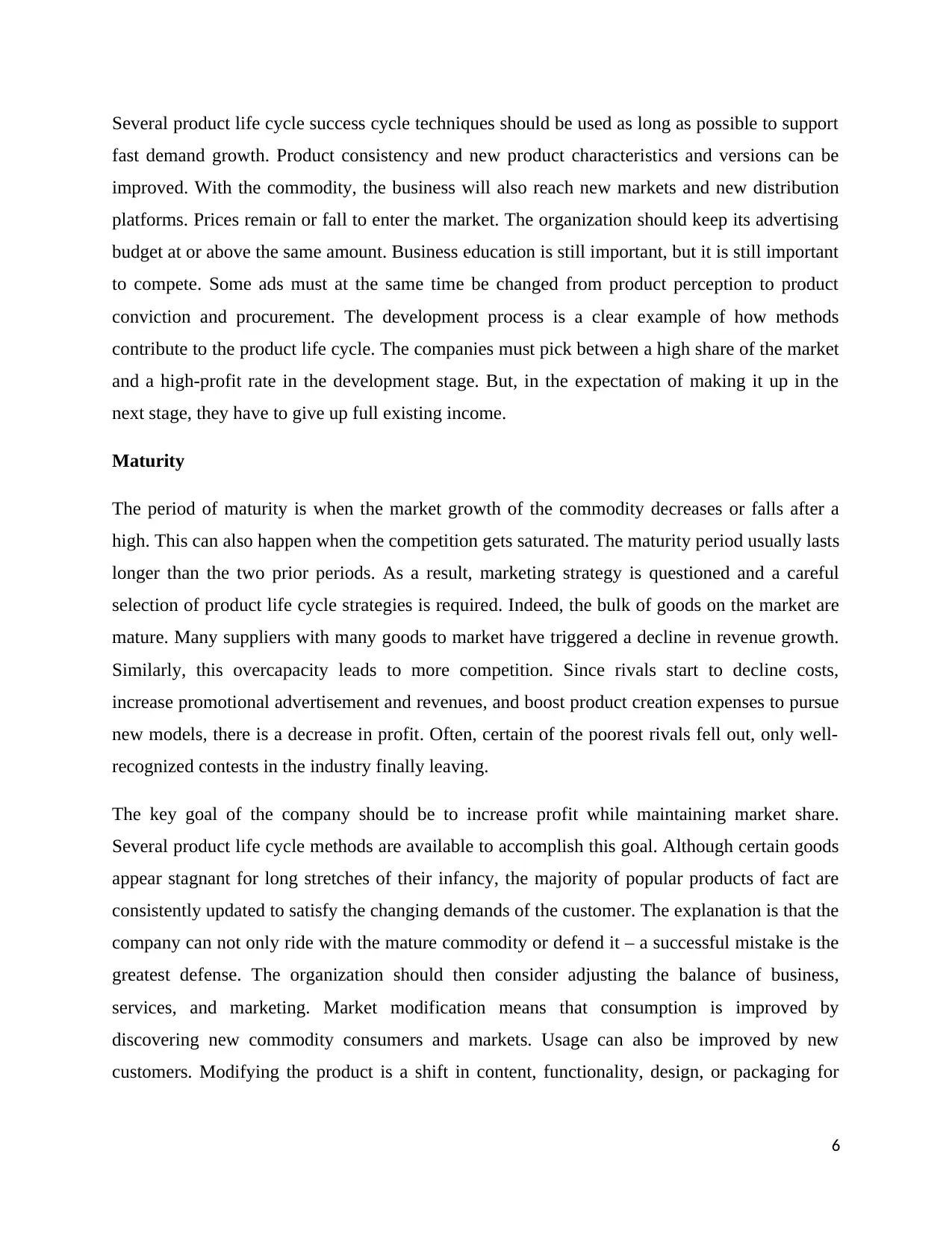
Several product life cycle success cycle techniques should be used as long as possible to support
fast demand growth. Product consistency and new product characteristics and versions can be
improved. With the commodity, the business will also reach new markets and new distribution
platforms. Prices remain or fall to enter the market. The organization should keep its advertising
budget at or above the same amount. Business education is still important, but it is still important
to compete. Some ads must at the same time be changed from product perception to product
conviction and procurement. The development process is a clear example of how methods
contribute to the product life cycle. The companies must pick between a high share of the market
and a high-profit rate in the development stage. But, in the expectation of making it up in the
next stage, they have to give up full existing income.
Maturity
The period of maturity is when the market growth of the commodity decreases or falls after a
high. This can also happen when the competition gets saturated. The maturity period usually lasts
longer than the two prior periods. As a result, marketing strategy is questioned and a careful
selection of product life cycle strategies is required. Indeed, the bulk of goods on the market are
mature. Many suppliers with many goods to market have triggered a decline in revenue growth.
Similarly, this overcapacity leads to more competition. Since rivals start to decline costs,
increase promotional advertisement and revenues, and boost product creation expenses to pursue
new models, there is a decrease in profit. Often, certain of the poorest rivals fell out, only well-
recognized contests in the industry finally leaving.
The key goal of the company should be to increase profit while maintaining market share.
Several product life cycle methods are available to accomplish this goal. Although certain goods
appear stagnant for long stretches of their infancy, the majority of popular products of fact are
consistently updated to satisfy the changing demands of the customer. The explanation is that the
company can not only ride with the mature commodity or defend it – a successful mistake is the
greatest defense. The organization should then consider adjusting the balance of business,
services, and marketing. Market modification means that consumption is improved by
discovering new commodity consumers and markets. Usage can also be improved by new
customers. Modifying the product is a shift in content, functionality, design, or packaging for
6
fast demand growth. Product consistency and new product characteristics and versions can be
improved. With the commodity, the business will also reach new markets and new distribution
platforms. Prices remain or fall to enter the market. The organization should keep its advertising
budget at or above the same amount. Business education is still important, but it is still important
to compete. Some ads must at the same time be changed from product perception to product
conviction and procurement. The development process is a clear example of how methods
contribute to the product life cycle. The companies must pick between a high share of the market
and a high-profit rate in the development stage. But, in the expectation of making it up in the
next stage, they have to give up full existing income.
Maturity
The period of maturity is when the market growth of the commodity decreases or falls after a
high. This can also happen when the competition gets saturated. The maturity period usually lasts
longer than the two prior periods. As a result, marketing strategy is questioned and a careful
selection of product life cycle strategies is required. Indeed, the bulk of goods on the market are
mature. Many suppliers with many goods to market have triggered a decline in revenue growth.
Similarly, this overcapacity leads to more competition. Since rivals start to decline costs,
increase promotional advertisement and revenues, and boost product creation expenses to pursue
new models, there is a decrease in profit. Often, certain of the poorest rivals fell out, only well-
recognized contests in the industry finally leaving.
The key goal of the company should be to increase profit while maintaining market share.
Several product life cycle methods are available to accomplish this goal. Although certain goods
appear stagnant for long stretches of their infancy, the majority of popular products of fact are
consistently updated to satisfy the changing demands of the customer. The explanation is that the
company can not only ride with the mature commodity or defend it – a successful mistake is the
greatest defense. The organization should then consider adjusting the balance of business,
services, and marketing. Market modification means that consumption is improved by
discovering new commodity consumers and markets. Usage can also be improved by new
customers. Modifying the product is a shift in content, functionality, design, or packaging for
6
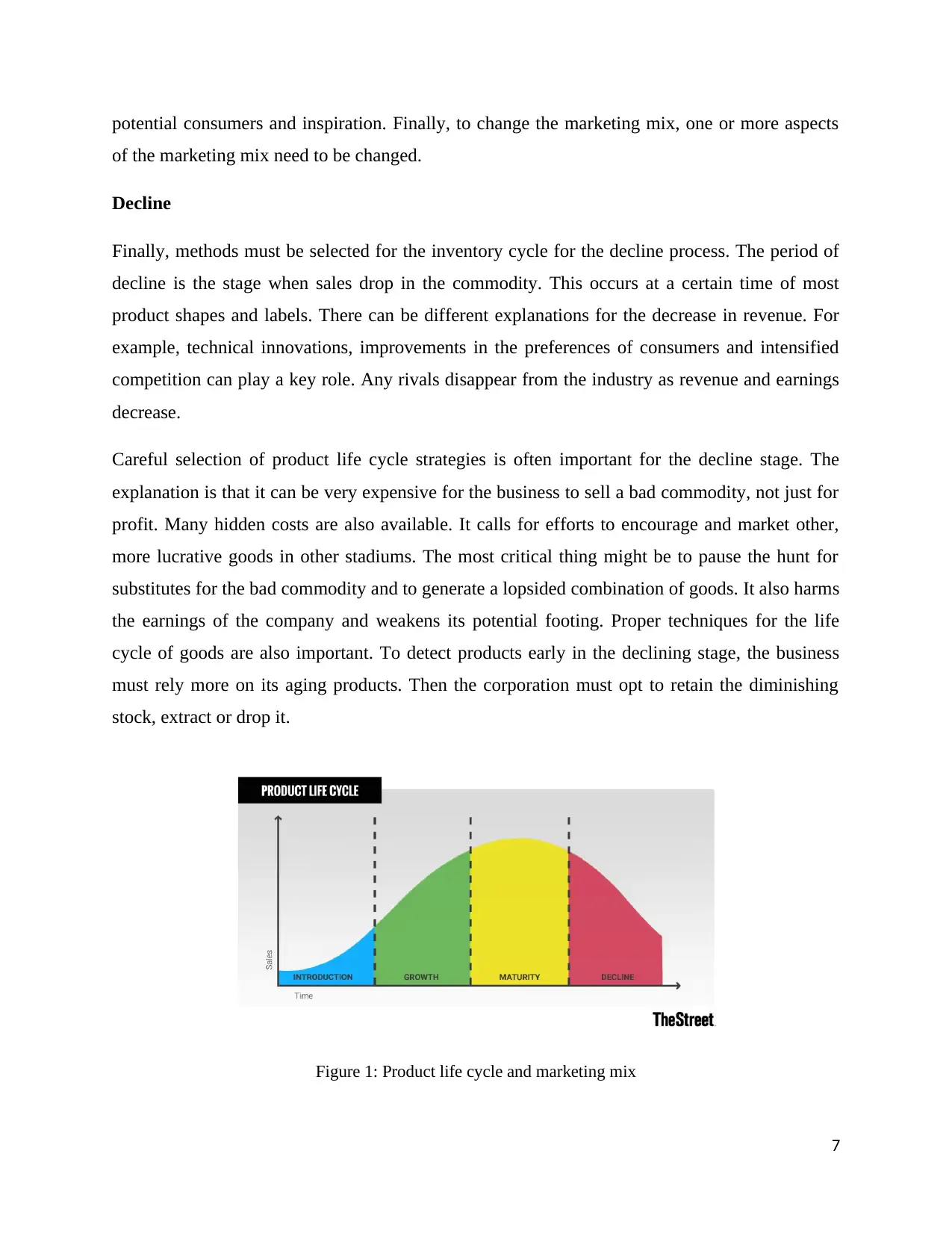
potential consumers and inspiration. Finally, to change the marketing mix, one or more aspects
of the marketing mix need to be changed.
Decline
Finally, methods must be selected for the inventory cycle for the decline process. The period of
decline is the stage when sales drop in the commodity. This occurs at a certain time of most
product shapes and labels. There can be different explanations for the decrease in revenue. For
example, technical innovations, improvements in the preferences of consumers and intensified
competition can play a key role. Any rivals disappear from the industry as revenue and earnings
decrease.
Careful selection of product life cycle strategies is often important for the decline stage. The
explanation is that it can be very expensive for the business to sell a bad commodity, not just for
profit. Many hidden costs are also available. It calls for efforts to encourage and market other,
more lucrative goods in other stadiums. The most critical thing might be to pause the hunt for
substitutes for the bad commodity and to generate a lopsided combination of goods. It also harms
the earnings of the company and weakens its potential footing. Proper techniques for the life
cycle of goods are also important. To detect products early in the declining stage, the business
must rely more on its aging products. Then the corporation must opt to retain the diminishing
stock, extract or drop it.
Figure 1: Product life cycle and marketing mix
7
of the marketing mix need to be changed.
Decline
Finally, methods must be selected for the inventory cycle for the decline process. The period of
decline is the stage when sales drop in the commodity. This occurs at a certain time of most
product shapes and labels. There can be different explanations for the decrease in revenue. For
example, technical innovations, improvements in the preferences of consumers and intensified
competition can play a key role. Any rivals disappear from the industry as revenue and earnings
decrease.
Careful selection of product life cycle strategies is often important for the decline stage. The
explanation is that it can be very expensive for the business to sell a bad commodity, not just for
profit. Many hidden costs are also available. It calls for efforts to encourage and market other,
more lucrative goods in other stadiums. The most critical thing might be to pause the hunt for
substitutes for the bad commodity and to generate a lopsided combination of goods. It also harms
the earnings of the company and weakens its potential footing. Proper techniques for the life
cycle of goods are also important. To detect products early in the declining stage, the business
must rely more on its aging products. Then the corporation must opt to retain the diminishing
stock, extract or drop it.
Figure 1: Product life cycle and marketing mix
7
Paraphrase This Document
Need a fresh take? Get an instant paraphrase of this document with our AI Paraphraser
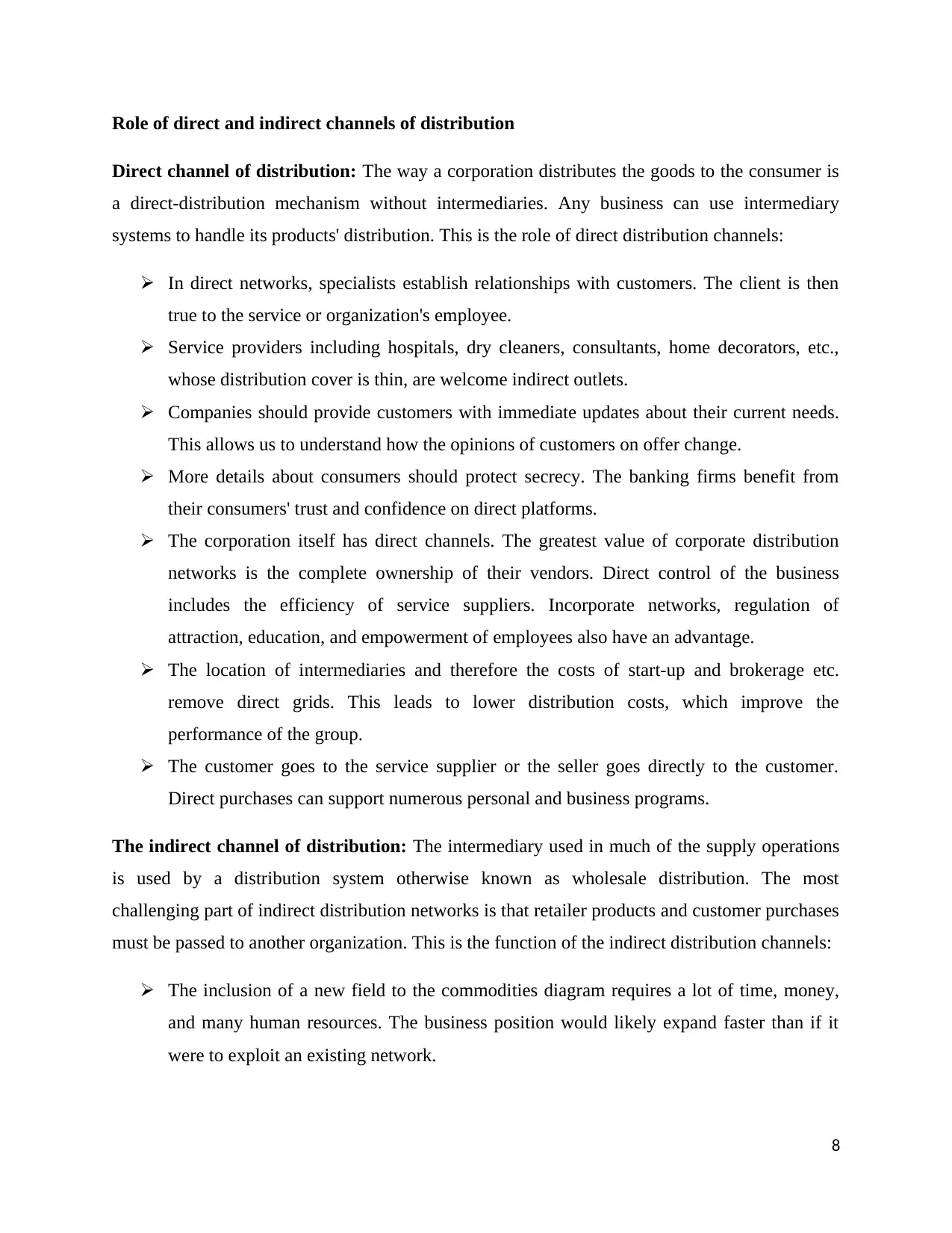
Role of direct and indirect channels of distribution
Direct channel of distribution: The way a corporation distributes the goods to the consumer is
a direct-distribution mechanism without intermediaries. Any business can use intermediary
systems to handle its products' distribution. This is the role of direct distribution channels:
In direct networks, specialists establish relationships with customers. The client is then
true to the service or organization's employee.
Service providers including hospitals, dry cleaners, consultants, home decorators, etc.,
whose distribution cover is thin, are welcome indirect outlets.
Companies should provide customers with immediate updates about their current needs.
This allows us to understand how the opinions of customers on offer change.
More details about consumers should protect secrecy. The banking firms benefit from
their consumers' trust and confidence on direct platforms.
The corporation itself has direct channels. The greatest value of corporate distribution
networks is the complete ownership of their vendors. Direct control of the business
includes the efficiency of service suppliers. Incorporate networks, regulation of
attraction, education, and empowerment of employees also have an advantage.
The location of intermediaries and therefore the costs of start-up and brokerage etc.
remove direct grids. This leads to lower distribution costs, which improve the
performance of the group.
The customer goes to the service supplier or the seller goes directly to the customer.
Direct purchases can support numerous personal and business programs.
The indirect channel of distribution: The intermediary used in much of the supply operations
is used by a distribution system otherwise known as wholesale distribution. The most
challenging part of indirect distribution networks is that retailer products and customer purchases
must be passed to another organization. This is the function of the indirect distribution channels:
The inclusion of a new field to the commodities diagram requires a lot of time, money,
and many human resources. The business position would likely expand faster than if it
were to exploit an existing network.
8
Direct channel of distribution: The way a corporation distributes the goods to the consumer is
a direct-distribution mechanism without intermediaries. Any business can use intermediary
systems to handle its products' distribution. This is the role of direct distribution channels:
In direct networks, specialists establish relationships with customers. The client is then
true to the service or organization's employee.
Service providers including hospitals, dry cleaners, consultants, home decorators, etc.,
whose distribution cover is thin, are welcome indirect outlets.
Companies should provide customers with immediate updates about their current needs.
This allows us to understand how the opinions of customers on offer change.
More details about consumers should protect secrecy. The banking firms benefit from
their consumers' trust and confidence on direct platforms.
The corporation itself has direct channels. The greatest value of corporate distribution
networks is the complete ownership of their vendors. Direct control of the business
includes the efficiency of service suppliers. Incorporate networks, regulation of
attraction, education, and empowerment of employees also have an advantage.
The location of intermediaries and therefore the costs of start-up and brokerage etc.
remove direct grids. This leads to lower distribution costs, which improve the
performance of the group.
The customer goes to the service supplier or the seller goes directly to the customer.
Direct purchases can support numerous personal and business programs.
The indirect channel of distribution: The intermediary used in much of the supply operations
is used by a distribution system otherwise known as wholesale distribution. The most
challenging part of indirect distribution networks is that retailer products and customer purchases
must be passed to another organization. This is the function of the indirect distribution channels:
The inclusion of a new field to the commodities diagram requires a lot of time, money,
and many human resources. The business position would likely expand faster than if it
were to exploit an existing network.
8
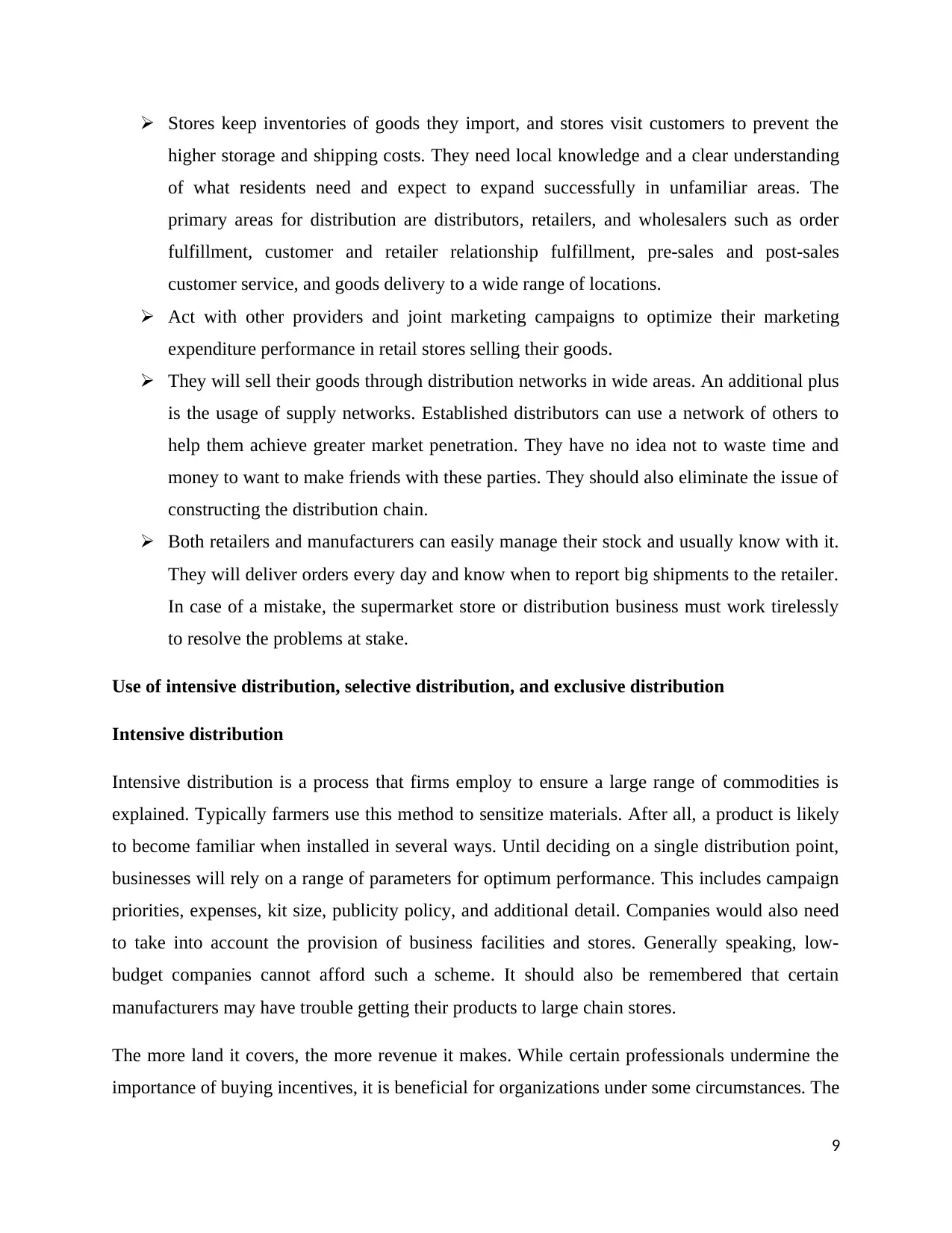
Stores keep inventories of goods they import, and stores visit customers to prevent the
higher storage and shipping costs. They need local knowledge and a clear understanding
of what residents need and expect to expand successfully in unfamiliar areas. The
primary areas for distribution are distributors, retailers, and wholesalers such as order
fulfillment, customer and retailer relationship fulfillment, pre-sales and post-sales
customer service, and goods delivery to a wide range of locations.
Act with other providers and joint marketing campaigns to optimize their marketing
expenditure performance in retail stores selling their goods.
They will sell their goods through distribution networks in wide areas. An additional plus
is the usage of supply networks. Established distributors can use a network of others to
help them achieve greater market penetration. They have no idea not to waste time and
money to want to make friends with these parties. They should also eliminate the issue of
constructing the distribution chain.
Both retailers and manufacturers can easily manage their stock and usually know with it.
They will deliver orders every day and know when to report big shipments to the retailer.
In case of a mistake, the supermarket store or distribution business must work tirelessly
to resolve the problems at stake.
Use of intensive distribution, selective distribution, and exclusive distribution
Intensive distribution
Intensive distribution is a process that firms employ to ensure a large range of commodities is
explained. Typically farmers use this method to sensitize materials. After all, a product is likely
to become familiar when installed in several ways. Until deciding on a single distribution point,
businesses will rely on a range of parameters for optimum performance. This includes campaign
priorities, expenses, kit size, publicity policy, and additional detail. Companies would also need
to take into account the provision of business facilities and stores. Generally speaking, low-
budget companies cannot afford such a scheme. It should also be remembered that certain
manufacturers may have trouble getting their products to large chain stores.
The more land it covers, the more revenue it makes. While certain professionals undermine the
importance of buying incentives, it is beneficial for organizations under some circumstances. The
9
higher storage and shipping costs. They need local knowledge and a clear understanding
of what residents need and expect to expand successfully in unfamiliar areas. The
primary areas for distribution are distributors, retailers, and wholesalers such as order
fulfillment, customer and retailer relationship fulfillment, pre-sales and post-sales
customer service, and goods delivery to a wide range of locations.
Act with other providers and joint marketing campaigns to optimize their marketing
expenditure performance in retail stores selling their goods.
They will sell their goods through distribution networks in wide areas. An additional plus
is the usage of supply networks. Established distributors can use a network of others to
help them achieve greater market penetration. They have no idea not to waste time and
money to want to make friends with these parties. They should also eliminate the issue of
constructing the distribution chain.
Both retailers and manufacturers can easily manage their stock and usually know with it.
They will deliver orders every day and know when to report big shipments to the retailer.
In case of a mistake, the supermarket store or distribution business must work tirelessly
to resolve the problems at stake.
Use of intensive distribution, selective distribution, and exclusive distribution
Intensive distribution
Intensive distribution is a process that firms employ to ensure a large range of commodities is
explained. Typically farmers use this method to sensitize materials. After all, a product is likely
to become familiar when installed in several ways. Until deciding on a single distribution point,
businesses will rely on a range of parameters for optimum performance. This includes campaign
priorities, expenses, kit size, publicity policy, and additional detail. Companies would also need
to take into account the provision of business facilities and stores. Generally speaking, low-
budget companies cannot afford such a scheme. It should also be remembered that certain
manufacturers may have trouble getting their products to large chain stores.
The more land it covers, the more revenue it makes. While certain professionals undermine the
importance of buying incentives, it is beneficial for organizations under some circumstances. The
9
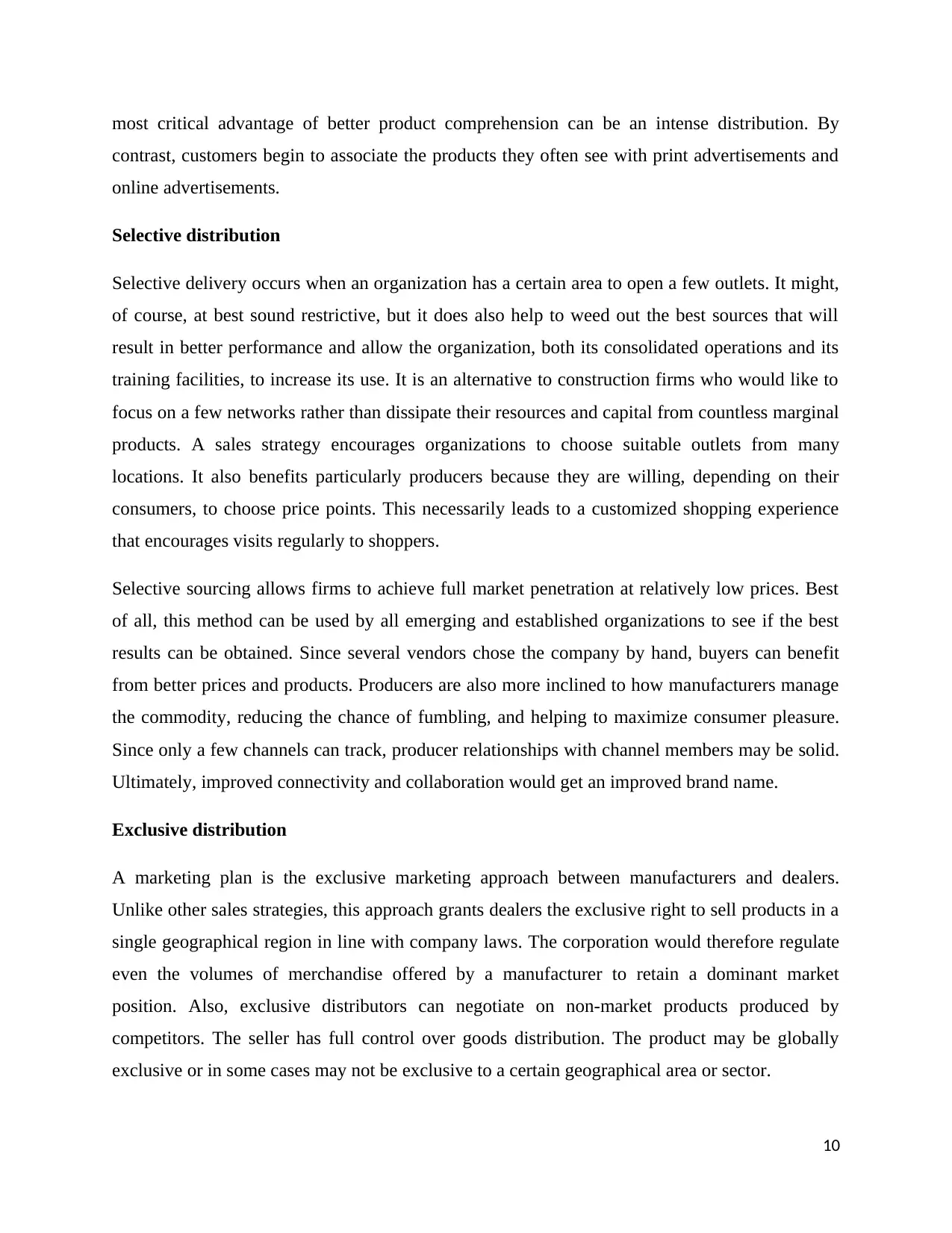
most critical advantage of better product comprehension can be an intense distribution. By
contrast, customers begin to associate the products they often see with print advertisements and
online advertisements.
Selective distribution
Selective delivery occurs when an organization has a certain area to open a few outlets. It might,
of course, at best sound restrictive, but it does also help to weed out the best sources that will
result in better performance and allow the organization, both its consolidated operations and its
training facilities, to increase its use. It is an alternative to construction firms who would like to
focus on a few networks rather than dissipate their resources and capital from countless marginal
products. A sales strategy encourages organizations to choose suitable outlets from many
locations. It also benefits particularly producers because they are willing, depending on their
consumers, to choose price points. This necessarily leads to a customized shopping experience
that encourages visits regularly to shoppers.
Selective sourcing allows firms to achieve full market penetration at relatively low prices. Best
of all, this method can be used by all emerging and established organizations to see if the best
results can be obtained. Since several vendors chose the company by hand, buyers can benefit
from better prices and products. Producers are also more inclined to how manufacturers manage
the commodity, reducing the chance of fumbling, and helping to maximize consumer pleasure.
Since only a few channels can track, producer relationships with channel members may be solid.
Ultimately, improved connectivity and collaboration would get an improved brand name.
Exclusive distribution
A marketing plan is the exclusive marketing approach between manufacturers and dealers.
Unlike other sales strategies, this approach grants dealers the exclusive right to sell products in a
single geographical region in line with company laws. The corporation would therefore regulate
even the volumes of merchandise offered by a manufacturer to retain a dominant market
position. Also, exclusive distributors can negotiate on non-market products produced by
competitors. The seller has full control over goods distribution. The product may be globally
exclusive or in some cases may not be exclusive to a certain geographical area or sector.
10
contrast, customers begin to associate the products they often see with print advertisements and
online advertisements.
Selective distribution
Selective delivery occurs when an organization has a certain area to open a few outlets. It might,
of course, at best sound restrictive, but it does also help to weed out the best sources that will
result in better performance and allow the organization, both its consolidated operations and its
training facilities, to increase its use. It is an alternative to construction firms who would like to
focus on a few networks rather than dissipate their resources and capital from countless marginal
products. A sales strategy encourages organizations to choose suitable outlets from many
locations. It also benefits particularly producers because they are willing, depending on their
consumers, to choose price points. This necessarily leads to a customized shopping experience
that encourages visits regularly to shoppers.
Selective sourcing allows firms to achieve full market penetration at relatively low prices. Best
of all, this method can be used by all emerging and established organizations to see if the best
results can be obtained. Since several vendors chose the company by hand, buyers can benefit
from better prices and products. Producers are also more inclined to how manufacturers manage
the commodity, reducing the chance of fumbling, and helping to maximize consumer pleasure.
Since only a few channels can track, producer relationships with channel members may be solid.
Ultimately, improved connectivity and collaboration would get an improved brand name.
Exclusive distribution
A marketing plan is the exclusive marketing approach between manufacturers and dealers.
Unlike other sales strategies, this approach grants dealers the exclusive right to sell products in a
single geographical region in line with company laws. The corporation would therefore regulate
even the volumes of merchandise offered by a manufacturer to retain a dominant market
position. Also, exclusive distributors can negotiate on non-market products produced by
competitors. The seller has full control over goods distribution. The product may be globally
exclusive or in some cases may not be exclusive to a certain geographical area or sector.
10
Secure Best Marks with AI Grader
Need help grading? Try our AI Grader for instant feedback on your assignments.
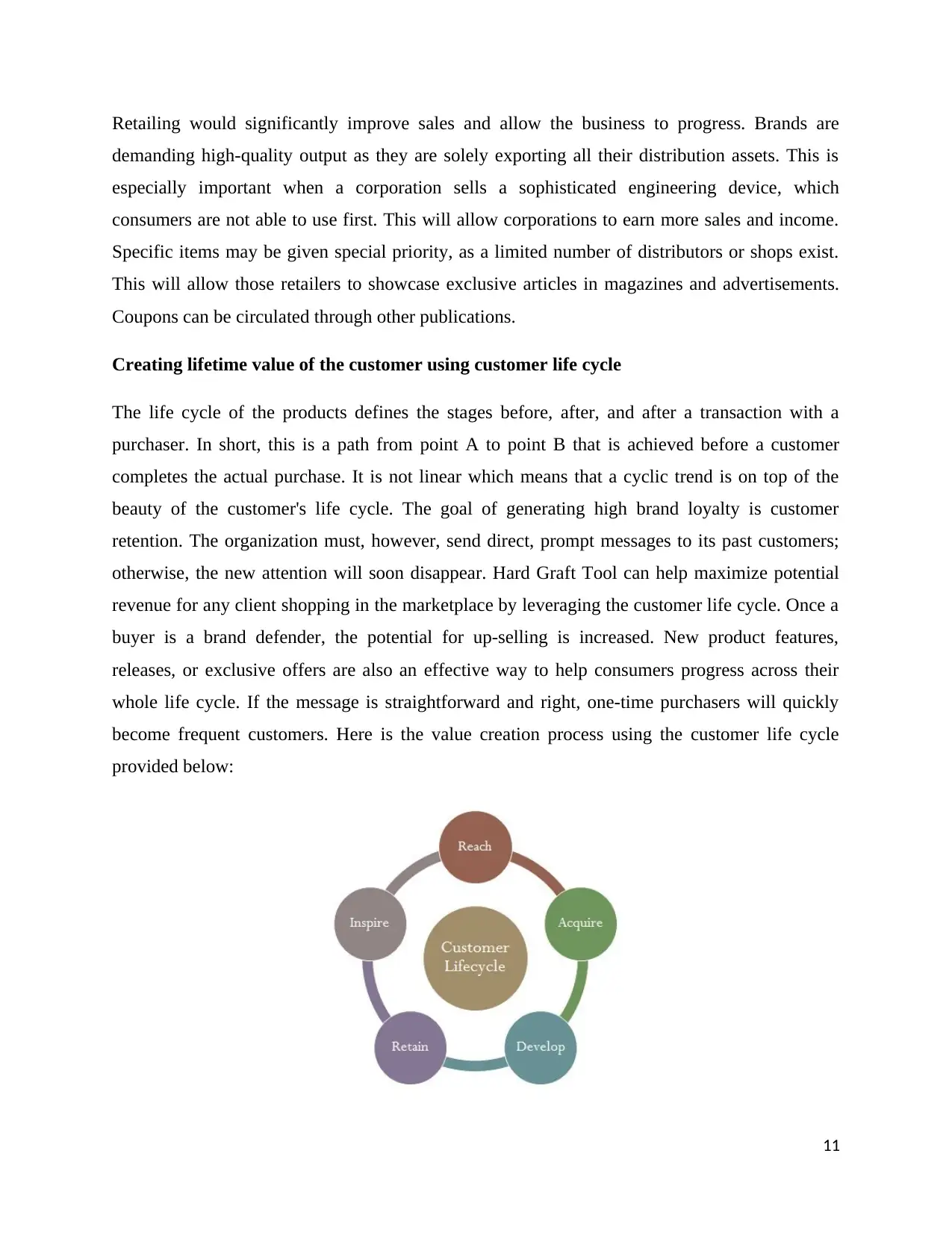
Retailing would significantly improve sales and allow the business to progress. Brands are
demanding high-quality output as they are solely exporting all their distribution assets. This is
especially important when a corporation sells a sophisticated engineering device, which
consumers are not able to use first. This will allow corporations to earn more sales and income.
Specific items may be given special priority, as a limited number of distributors or shops exist.
This will allow those retailers to showcase exclusive articles in magazines and advertisements.
Coupons can be circulated through other publications.
Creating lifetime value of the customer using customer life cycle
The life cycle of the products defines the stages before, after, and after a transaction with a
purchaser. In short, this is a path from point A to point B that is achieved before a customer
completes the actual purchase. It is not linear which means that a cyclic trend is on top of the
beauty of the customer's life cycle. The goal of generating high brand loyalty is customer
retention. The organization must, however, send direct, prompt messages to its past customers;
otherwise, the new attention will soon disappear. Hard Graft Tool can help maximize potential
revenue for any client shopping in the marketplace by leveraging the customer life cycle. Once a
buyer is a brand defender, the potential for up-selling is increased. New product features,
releases, or exclusive offers are also an effective way to help consumers progress across their
whole life cycle. If the message is straightforward and right, one-time purchasers will quickly
become frequent customers. Here is the value creation process using the customer life cycle
provided below:
11
demanding high-quality output as they are solely exporting all their distribution assets. This is
especially important when a corporation sells a sophisticated engineering device, which
consumers are not able to use first. This will allow corporations to earn more sales and income.
Specific items may be given special priority, as a limited number of distributors or shops exist.
This will allow those retailers to showcase exclusive articles in magazines and advertisements.
Coupons can be circulated through other publications.
Creating lifetime value of the customer using customer life cycle
The life cycle of the products defines the stages before, after, and after a transaction with a
purchaser. In short, this is a path from point A to point B that is achieved before a customer
completes the actual purchase. It is not linear which means that a cyclic trend is on top of the
beauty of the customer's life cycle. The goal of generating high brand loyalty is customer
retention. The organization must, however, send direct, prompt messages to its past customers;
otherwise, the new attention will soon disappear. Hard Graft Tool can help maximize potential
revenue for any client shopping in the marketplace by leveraging the customer life cycle. Once a
buyer is a brand defender, the potential for up-selling is increased. New product features,
releases, or exclusive offers are also an effective way to help consumers progress across their
whole life cycle. If the message is straightforward and right, one-time purchasers will quickly
become frequent customers. Here is the value creation process using the customer life cycle
provided below:
11
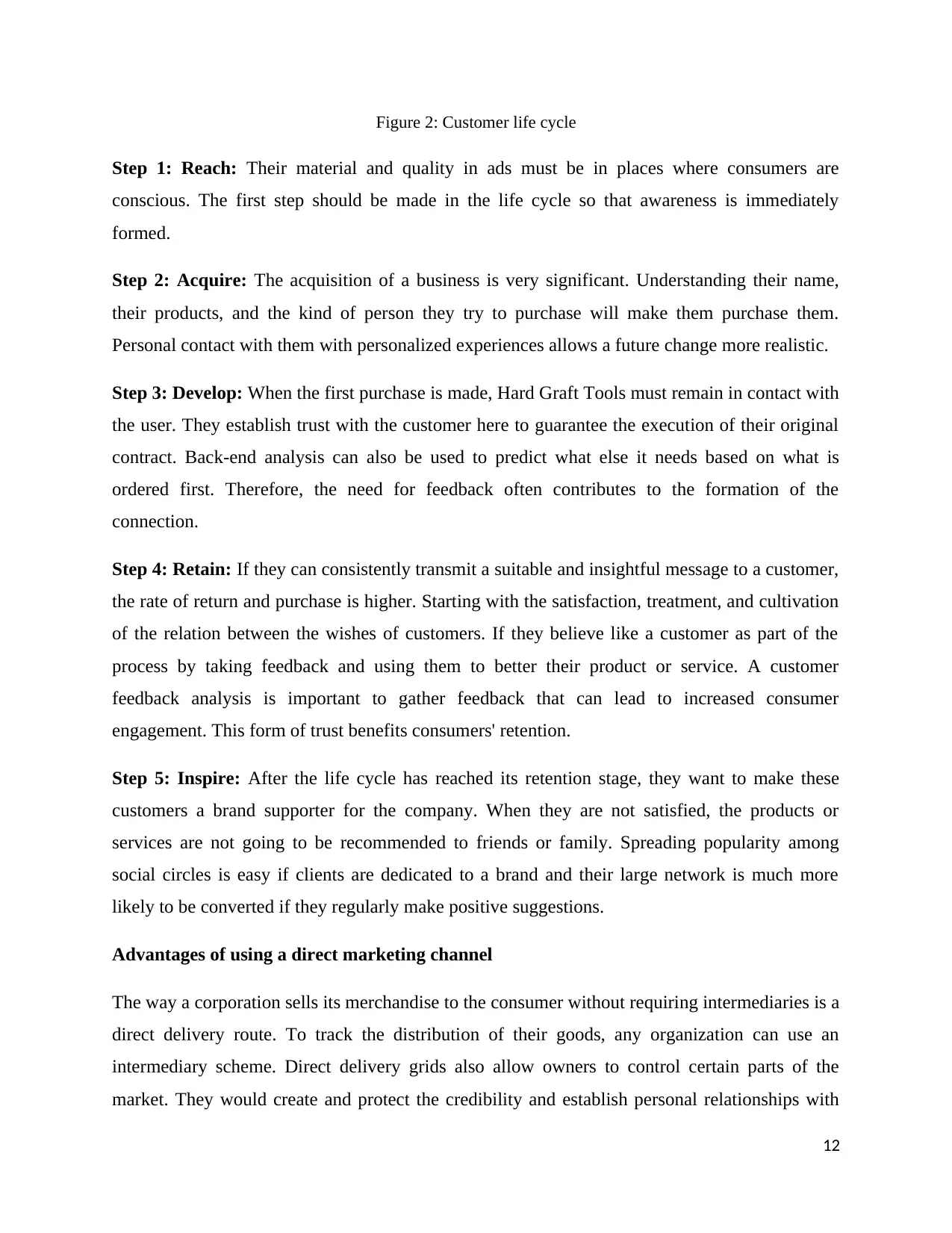
Figure 2: Customer life cycle
Step 1: Reach: Their material and quality in ads must be in places where consumers are
conscious. The first step should be made in the life cycle so that awareness is immediately
formed.
Step 2: Acquire: The acquisition of a business is very significant. Understanding their name,
their products, and the kind of person they try to purchase will make them purchase them.
Personal contact with them with personalized experiences allows a future change more realistic.
Step 3: Develop: When the first purchase is made, Hard Graft Tools must remain in contact with
the user. They establish trust with the customer here to guarantee the execution of their original
contract. Back-end analysis can also be used to predict what else it needs based on what is
ordered first. Therefore, the need for feedback often contributes to the formation of the
connection.
Step 4: Retain: If they can consistently transmit a suitable and insightful message to a customer,
the rate of return and purchase is higher. Starting with the satisfaction, treatment, and cultivation
of the relation between the wishes of customers. If they believe like a customer as part of the
process by taking feedback and using them to better their product or service. A customer
feedback analysis is important to gather feedback that can lead to increased consumer
engagement. This form of trust benefits consumers' retention.
Step 5: Inspire: After the life cycle has reached its retention stage, they want to make these
customers a brand supporter for the company. When they are not satisfied, the products or
services are not going to be recommended to friends or family. Spreading popularity among
social circles is easy if clients are dedicated to a brand and their large network is much more
likely to be converted if they regularly make positive suggestions.
Advantages of using a direct marketing channel
The way a corporation sells its merchandise to the consumer without requiring intermediaries is a
direct delivery route. To track the distribution of their goods, any organization can use an
intermediary scheme. Direct delivery grids also allow owners to control certain parts of the
market. They would create and protect the credibility and establish personal relationships with
12
Step 1: Reach: Their material and quality in ads must be in places where consumers are
conscious. The first step should be made in the life cycle so that awareness is immediately
formed.
Step 2: Acquire: The acquisition of a business is very significant. Understanding their name,
their products, and the kind of person they try to purchase will make them purchase them.
Personal contact with them with personalized experiences allows a future change more realistic.
Step 3: Develop: When the first purchase is made, Hard Graft Tools must remain in contact with
the user. They establish trust with the customer here to guarantee the execution of their original
contract. Back-end analysis can also be used to predict what else it needs based on what is
ordered first. Therefore, the need for feedback often contributes to the formation of the
connection.
Step 4: Retain: If they can consistently transmit a suitable and insightful message to a customer,
the rate of return and purchase is higher. Starting with the satisfaction, treatment, and cultivation
of the relation between the wishes of customers. If they believe like a customer as part of the
process by taking feedback and using them to better their product or service. A customer
feedback analysis is important to gather feedback that can lead to increased consumer
engagement. This form of trust benefits consumers' retention.
Step 5: Inspire: After the life cycle has reached its retention stage, they want to make these
customers a brand supporter for the company. When they are not satisfied, the products or
services are not going to be recommended to friends or family. Spreading popularity among
social circles is easy if clients are dedicated to a brand and their large network is much more
likely to be converted if they regularly make positive suggestions.
Advantages of using a direct marketing channel
The way a corporation sells its merchandise to the consumer without requiring intermediaries is a
direct delivery route. To track the distribution of their goods, any organization can use an
intermediary scheme. Direct delivery grids also allow owners to control certain parts of the
market. They would create and protect the credibility and establish personal relationships with
12
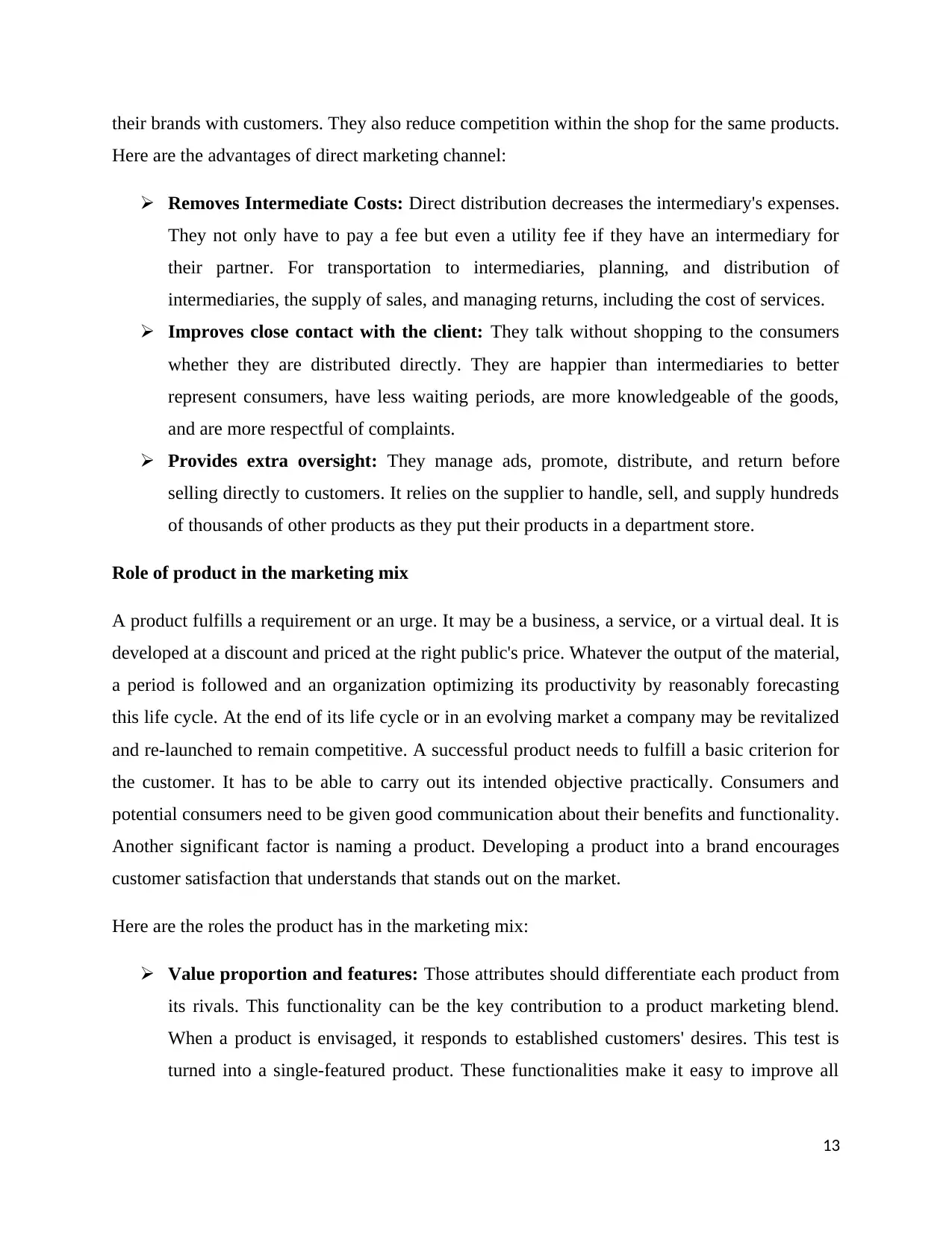
their brands with customers. They also reduce competition within the shop for the same products.
Here are the advantages of direct marketing channel:
Removes Intermediate Costs: Direct distribution decreases the intermediary's expenses.
They not only have to pay a fee but even a utility fee if they have an intermediary for
their partner. For transportation to intermediaries, planning, and distribution of
intermediaries, the supply of sales, and managing returns, including the cost of services.
Improves close contact with the client: They talk without shopping to the consumers
whether they are distributed directly. They are happier than intermediaries to better
represent consumers, have less waiting periods, are more knowledgeable of the goods,
and are more respectful of complaints.
Provides extra oversight: They manage ads, promote, distribute, and return before
selling directly to customers. It relies on the supplier to handle, sell, and supply hundreds
of thousands of other products as they put their products in a department store.
Role of product in the marketing mix
A product fulfills a requirement or an urge. It may be a business, a service, or a virtual deal. It is
developed at a discount and priced at the right public's price. Whatever the output of the material,
a period is followed and an organization optimizing its productivity by reasonably forecasting
this life cycle. At the end of its life cycle or in an evolving market a company may be revitalized
and re-launched to remain competitive. A successful product needs to fulfill a basic criterion for
the customer. It has to be able to carry out its intended objective practically. Consumers and
potential consumers need to be given good communication about their benefits and functionality.
Another significant factor is naming a product. Developing a product into a brand encourages
customer satisfaction that understands that stands out on the market.
Here are the roles the product has in the marketing mix:
Value proportion and features: Those attributes should differentiate each product from
its rivals. This functionality can be the key contribution to a product marketing blend.
When a product is envisaged, it responds to established customers' desires. This test is
turned into a single-featured product. These functionalities make it easy to improve all
13
Here are the advantages of direct marketing channel:
Removes Intermediate Costs: Direct distribution decreases the intermediary's expenses.
They not only have to pay a fee but even a utility fee if they have an intermediary for
their partner. For transportation to intermediaries, planning, and distribution of
intermediaries, the supply of sales, and managing returns, including the cost of services.
Improves close contact with the client: They talk without shopping to the consumers
whether they are distributed directly. They are happier than intermediaries to better
represent consumers, have less waiting periods, are more knowledgeable of the goods,
and are more respectful of complaints.
Provides extra oversight: They manage ads, promote, distribute, and return before
selling directly to customers. It relies on the supplier to handle, sell, and supply hundreds
of thousands of other products as they put their products in a department store.
Role of product in the marketing mix
A product fulfills a requirement or an urge. It may be a business, a service, or a virtual deal. It is
developed at a discount and priced at the right public's price. Whatever the output of the material,
a period is followed and an organization optimizing its productivity by reasonably forecasting
this life cycle. At the end of its life cycle or in an evolving market a company may be revitalized
and re-launched to remain competitive. A successful product needs to fulfill a basic criterion for
the customer. It has to be able to carry out its intended objective practically. Consumers and
potential consumers need to be given good communication about their benefits and functionality.
Another significant factor is naming a product. Developing a product into a brand encourages
customer satisfaction that understands that stands out on the market.
Here are the roles the product has in the marketing mix:
Value proportion and features: Those attributes should differentiate each product from
its rivals. This functionality can be the key contribution to a product marketing blend.
When a product is envisaged, it responds to established customers' desires. This test is
turned into a single-featured product. These functionalities make it easy to improve all
13
Paraphrase This Document
Need a fresh take? Get an instant paraphrase of this document with our AI Paraphraser
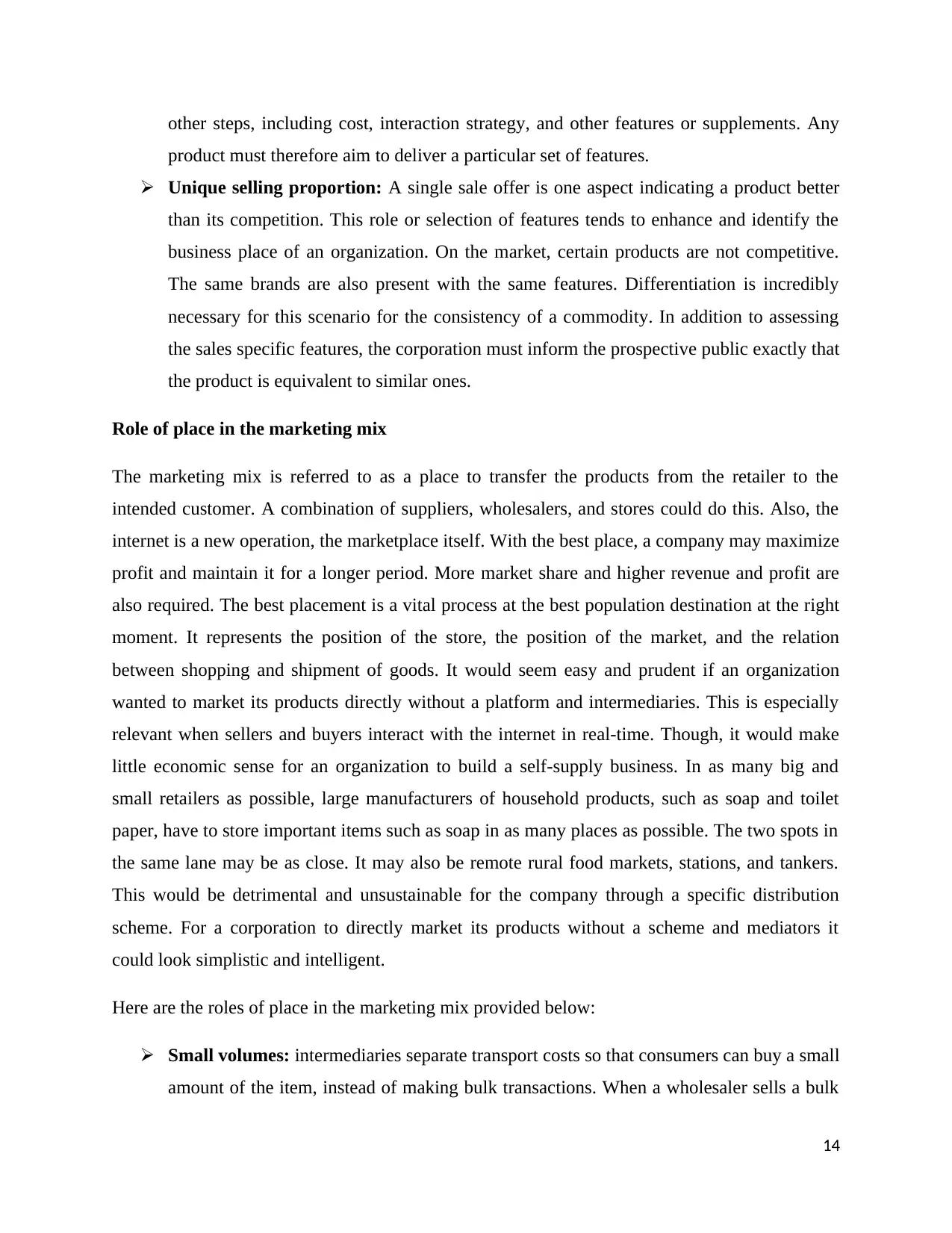
other steps, including cost, interaction strategy, and other features or supplements. Any
product must therefore aim to deliver a particular set of features.
Unique selling proportion: A single sale offer is one aspect indicating a product better
than its competition. This role or selection of features tends to enhance and identify the
business place of an organization. On the market, certain products are not competitive.
The same brands are also present with the same features. Differentiation is incredibly
necessary for this scenario for the consistency of a commodity. In addition to assessing
the sales specific features, the corporation must inform the prospective public exactly that
the product is equivalent to similar ones.
Role of place in the marketing mix
The marketing mix is referred to as a place to transfer the products from the retailer to the
intended customer. A combination of suppliers, wholesalers, and stores could do this. Also, the
internet is a new operation, the marketplace itself. With the best place, a company may maximize
profit and maintain it for a longer period. More market share and higher revenue and profit are
also required. The best placement is a vital process at the best population destination at the right
moment. It represents the position of the store, the position of the market, and the relation
between shopping and shipment of goods. It would seem easy and prudent if an organization
wanted to market its products directly without a platform and intermediaries. This is especially
relevant when sellers and buyers interact with the internet in real-time. Though, it would make
little economic sense for an organization to build a self-supply business. In as many big and
small retailers as possible, large manufacturers of household products, such as soap and toilet
paper, have to store important items such as soap in as many places as possible. The two spots in
the same lane may be as close. It may also be remote rural food markets, stations, and tankers.
This would be detrimental and unsustainable for the company through a specific distribution
scheme. For a corporation to directly market its products without a scheme and mediators it
could look simplistic and intelligent.
Here are the roles of place in the marketing mix provided below:
Small volumes: intermediaries separate transport costs so that consumers can buy a small
amount of the item, instead of making bulk transactions. When a wholesaler sells a bulk
14
product must therefore aim to deliver a particular set of features.
Unique selling proportion: A single sale offer is one aspect indicating a product better
than its competition. This role or selection of features tends to enhance and identify the
business place of an organization. On the market, certain products are not competitive.
The same brands are also present with the same features. Differentiation is incredibly
necessary for this scenario for the consistency of a commodity. In addition to assessing
the sales specific features, the corporation must inform the prospective public exactly that
the product is equivalent to similar ones.
Role of place in the marketing mix
The marketing mix is referred to as a place to transfer the products from the retailer to the
intended customer. A combination of suppliers, wholesalers, and stores could do this. Also, the
internet is a new operation, the marketplace itself. With the best place, a company may maximize
profit and maintain it for a longer period. More market share and higher revenue and profit are
also required. The best placement is a vital process at the best population destination at the right
moment. It represents the position of the store, the position of the market, and the relation
between shopping and shipment of goods. It would seem easy and prudent if an organization
wanted to market its products directly without a platform and intermediaries. This is especially
relevant when sellers and buyers interact with the internet in real-time. Though, it would make
little economic sense for an organization to build a self-supply business. In as many big and
small retailers as possible, large manufacturers of household products, such as soap and toilet
paper, have to store important items such as soap in as many places as possible. The two spots in
the same lane may be as close. It may also be remote rural food markets, stations, and tankers.
This would be detrimental and unsustainable for the company through a specific distribution
scheme. For a corporation to directly market its products without a scheme and mediators it
could look simplistic and intelligent.
Here are the roles of place in the marketing mix provided below:
Small volumes: intermediaries separate transport costs so that consumers can buy a small
amount of the item, instead of making bulk transactions. When a wholesaler sells a bulk
14
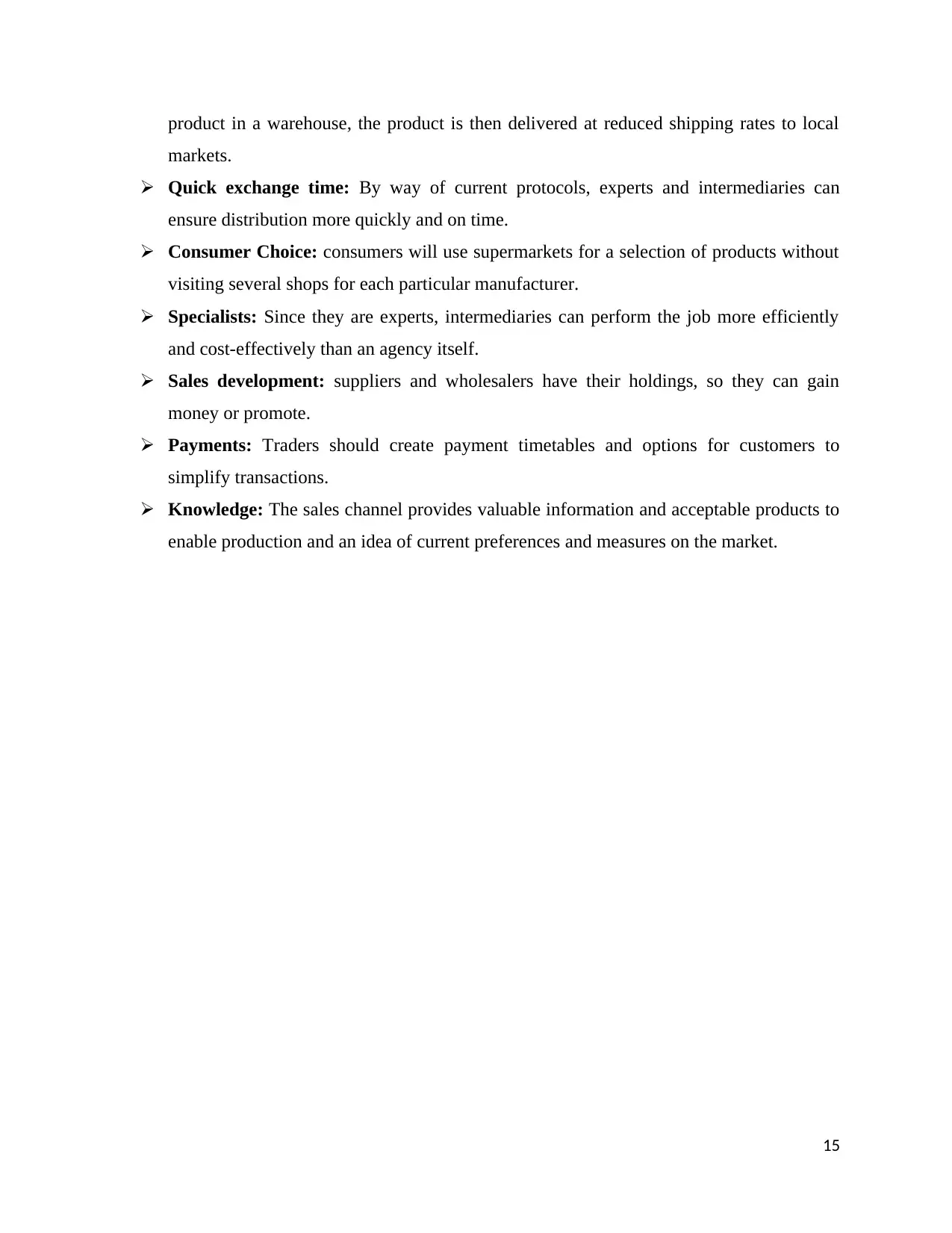
product in a warehouse, the product is then delivered at reduced shipping rates to local
markets.
Quick exchange time: By way of current protocols, experts and intermediaries can
ensure distribution more quickly and on time.
Consumer Choice: consumers will use supermarkets for a selection of products without
visiting several shops for each particular manufacturer.
Specialists: Since they are experts, intermediaries can perform the job more efficiently
and cost-effectively than an agency itself.
Sales development: suppliers and wholesalers have their holdings, so they can gain
money or promote.
Payments: Traders should create payment timetables and options for customers to
simplify transactions.
Knowledge: The sales channel provides valuable information and acceptable products to
enable production and an idea of current preferences and measures on the market.
15
markets.
Quick exchange time: By way of current protocols, experts and intermediaries can
ensure distribution more quickly and on time.
Consumer Choice: consumers will use supermarkets for a selection of products without
visiting several shops for each particular manufacturer.
Specialists: Since they are experts, intermediaries can perform the job more efficiently
and cost-effectively than an agency itself.
Sales development: suppliers and wholesalers have their holdings, so they can gain
money or promote.
Payments: Traders should create payment timetables and options for customers to
simplify transactions.
Knowledge: The sales channel provides valuable information and acceptable products to
enable production and an idea of current preferences and measures on the market.
15
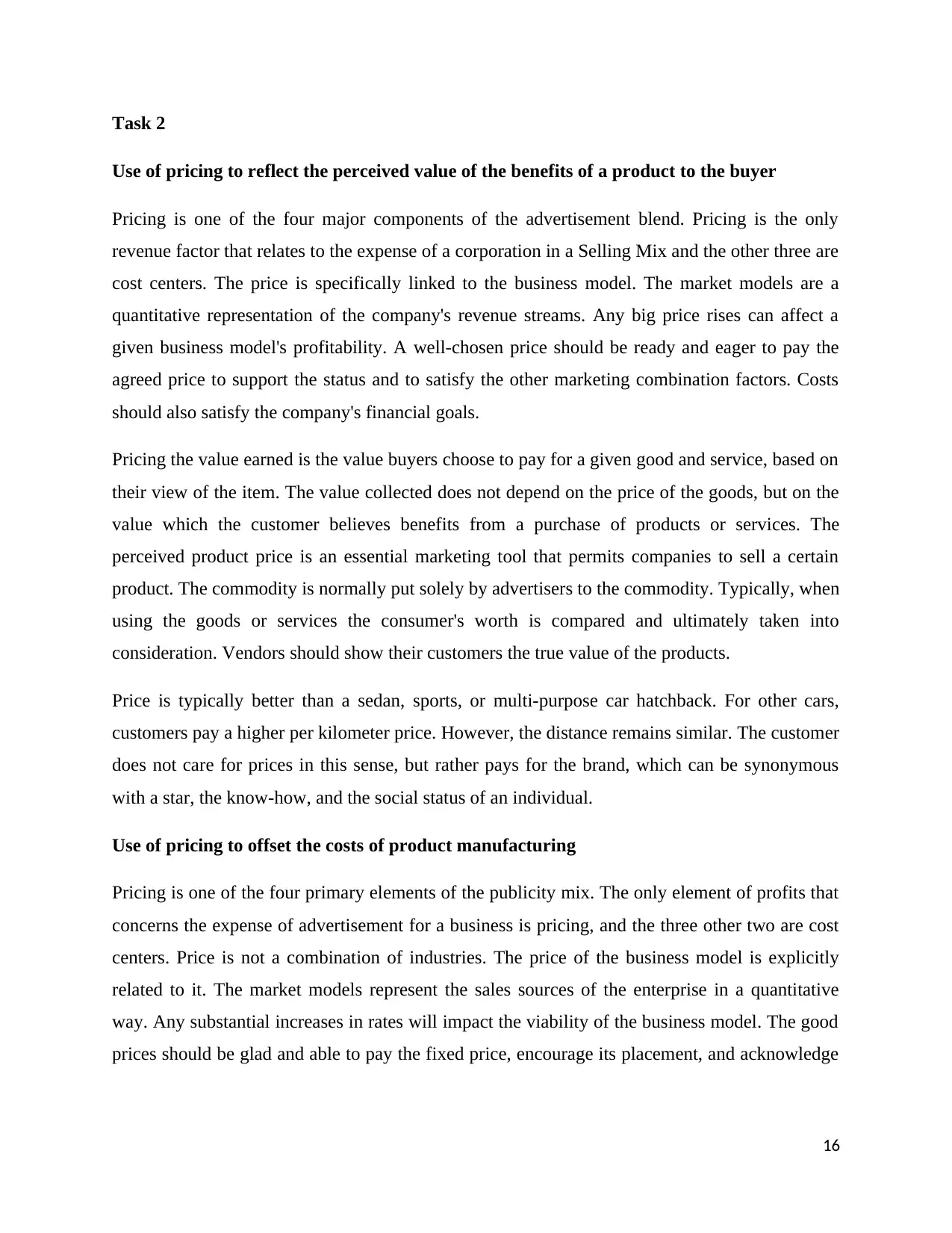
Task 2
Use of pricing to reflect the perceived value of the benefits of a product to the buyer
Pricing is one of the four major components of the advertisement blend. Pricing is the only
revenue factor that relates to the expense of a corporation in a Selling Mix and the other three are
cost centers. The price is specifically linked to the business model. The market models are a
quantitative representation of the company's revenue streams. Any big price rises can affect a
given business model's profitability. A well-chosen price should be ready and eager to pay the
agreed price to support the status and to satisfy the other marketing combination factors. Costs
should also satisfy the company's financial goals.
Pricing the value earned is the value buyers choose to pay for a given good and service, based on
their view of the item. The value collected does not depend on the price of the goods, but on the
value which the customer believes benefits from a purchase of products or services. The
perceived product price is an essential marketing tool that permits companies to sell a certain
product. The commodity is normally put solely by advertisers to the commodity. Typically, when
using the goods or services the consumer's worth is compared and ultimately taken into
consideration. Vendors should show their customers the true value of the products.
Price is typically better than a sedan, sports, or multi-purpose car hatchback. For other cars,
customers pay a higher per kilometer price. However, the distance remains similar. The customer
does not care for prices in this sense, but rather pays for the brand, which can be synonymous
with a star, the know-how, and the social status of an individual.
Use of pricing to offset the costs of product manufacturing
Pricing is one of the four primary elements of the publicity mix. The only element of profits that
concerns the expense of advertisement for a business is pricing, and the three other two are cost
centers. Price is not a combination of industries. The price of the business model is explicitly
related to it. The market models represent the sales sources of the enterprise in a quantitative
way. Any substantial increases in rates will impact the viability of the business model. The good
prices should be glad and able to pay the fixed price, encourage its placement, and acknowledge
16
Use of pricing to reflect the perceived value of the benefits of a product to the buyer
Pricing is one of the four major components of the advertisement blend. Pricing is the only
revenue factor that relates to the expense of a corporation in a Selling Mix and the other three are
cost centers. The price is specifically linked to the business model. The market models are a
quantitative representation of the company's revenue streams. Any big price rises can affect a
given business model's profitability. A well-chosen price should be ready and eager to pay the
agreed price to support the status and to satisfy the other marketing combination factors. Costs
should also satisfy the company's financial goals.
Pricing the value earned is the value buyers choose to pay for a given good and service, based on
their view of the item. The value collected does not depend on the price of the goods, but on the
value which the customer believes benefits from a purchase of products or services. The
perceived product price is an essential marketing tool that permits companies to sell a certain
product. The commodity is normally put solely by advertisers to the commodity. Typically, when
using the goods or services the consumer's worth is compared and ultimately taken into
consideration. Vendors should show their customers the true value of the products.
Price is typically better than a sedan, sports, or multi-purpose car hatchback. For other cars,
customers pay a higher per kilometer price. However, the distance remains similar. The customer
does not care for prices in this sense, but rather pays for the brand, which can be synonymous
with a star, the know-how, and the social status of an individual.
Use of pricing to offset the costs of product manufacturing
Pricing is one of the four primary elements of the publicity mix. The only element of profits that
concerns the expense of advertisement for a business is pricing, and the three other two are cost
centers. Price is not a combination of industries. The price of the business model is explicitly
related to it. The market models represent the sales sources of the enterprise in a quantitative
way. Any substantial increases in rates will impact the viability of the business model. The good
prices should be glad and able to pay the fixed price, encourage its placement, and acknowledge
16
Secure Best Marks with AI Grader
Need help grading? Try our AI Grader for instant feedback on your assignments.
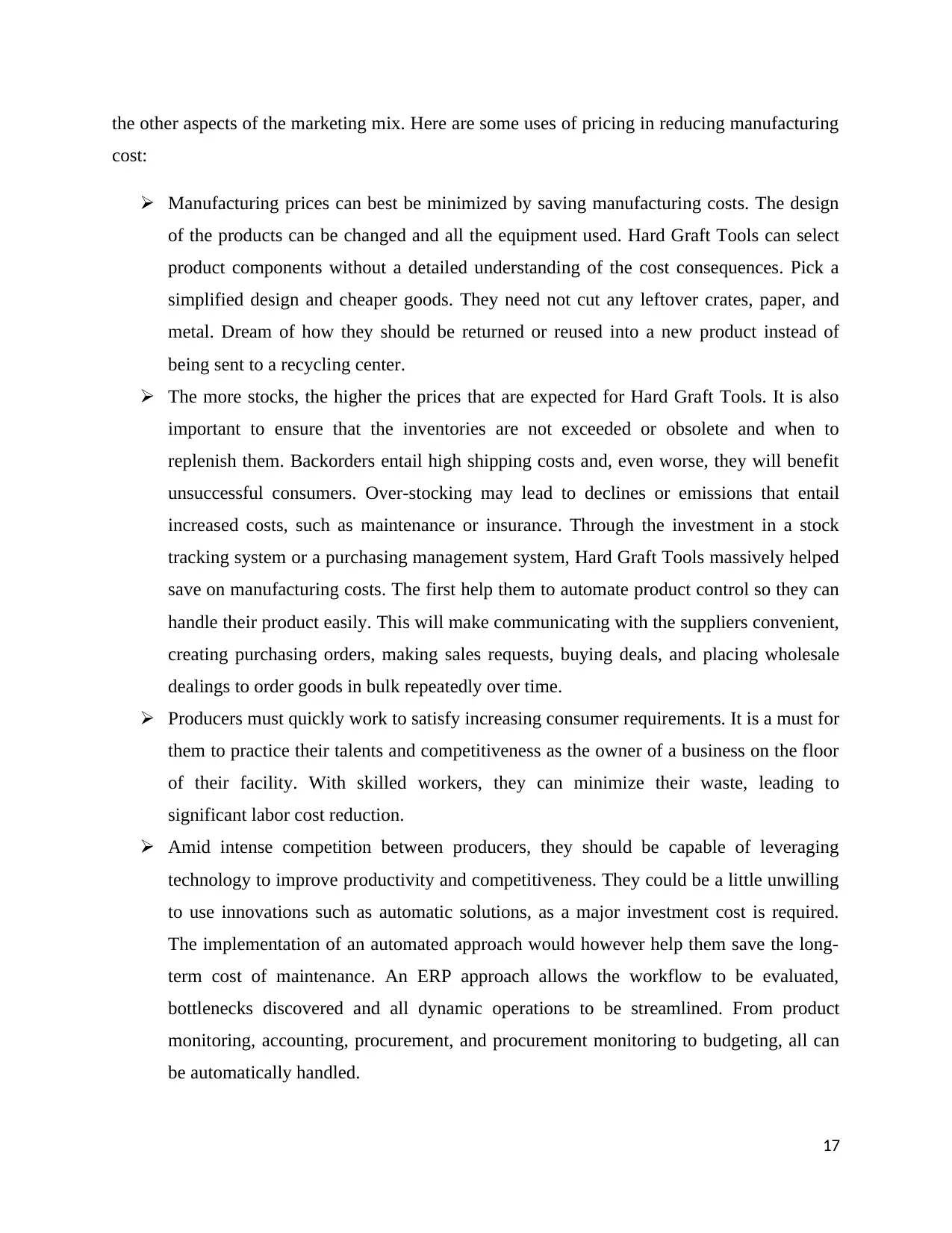
the other aspects of the marketing mix. Here are some uses of pricing in reducing manufacturing
cost:
Manufacturing prices can best be minimized by saving manufacturing costs. The design
of the products can be changed and all the equipment used. Hard Graft Tools can select
product components without a detailed understanding of the cost consequences. Pick a
simplified design and cheaper goods. They need not cut any leftover crates, paper, and
metal. Dream of how they should be returned or reused into a new product instead of
being sent to a recycling center.
The more stocks, the higher the prices that are expected for Hard Graft Tools. It is also
important to ensure that the inventories are not exceeded or obsolete and when to
replenish them. Backorders entail high shipping costs and, even worse, they will benefit
unsuccessful consumers. Over-stocking may lead to declines or emissions that entail
increased costs, such as maintenance or insurance. Through the investment in a stock
tracking system or a purchasing management system, Hard Graft Tools massively helped
save on manufacturing costs. The first help them to automate product control so they can
handle their product easily. This will make communicating with the suppliers convenient,
creating purchasing orders, making sales requests, buying deals, and placing wholesale
dealings to order goods in bulk repeatedly over time.
Producers must quickly work to satisfy increasing consumer requirements. It is a must for
them to practice their talents and competitiveness as the owner of a business on the floor
of their facility. With skilled workers, they can minimize their waste, leading to
significant labor cost reduction.
Amid intense competition between producers, they should be capable of leveraging
technology to improve productivity and competitiveness. They could be a little unwilling
to use innovations such as automatic solutions, as a major investment cost is required.
The implementation of an automated approach would however help them save the long-
term cost of maintenance. An ERP approach allows the workflow to be evaluated,
bottlenecks discovered and all dynamic operations to be streamlined. From product
monitoring, accounting, procurement, and procurement monitoring to budgeting, all can
be automatically handled.
17
cost:
Manufacturing prices can best be minimized by saving manufacturing costs. The design
of the products can be changed and all the equipment used. Hard Graft Tools can select
product components without a detailed understanding of the cost consequences. Pick a
simplified design and cheaper goods. They need not cut any leftover crates, paper, and
metal. Dream of how they should be returned or reused into a new product instead of
being sent to a recycling center.
The more stocks, the higher the prices that are expected for Hard Graft Tools. It is also
important to ensure that the inventories are not exceeded or obsolete and when to
replenish them. Backorders entail high shipping costs and, even worse, they will benefit
unsuccessful consumers. Over-stocking may lead to declines or emissions that entail
increased costs, such as maintenance or insurance. Through the investment in a stock
tracking system or a purchasing management system, Hard Graft Tools massively helped
save on manufacturing costs. The first help them to automate product control so they can
handle their product easily. This will make communicating with the suppliers convenient,
creating purchasing orders, making sales requests, buying deals, and placing wholesale
dealings to order goods in bulk repeatedly over time.
Producers must quickly work to satisfy increasing consumer requirements. It is a must for
them to practice their talents and competitiveness as the owner of a business on the floor
of their facility. With skilled workers, they can minimize their waste, leading to
significant labor cost reduction.
Amid intense competition between producers, they should be capable of leveraging
technology to improve productivity and competitiveness. They could be a little unwilling
to use innovations such as automatic solutions, as a major investment cost is required.
The implementation of an automated approach would however help them save the long-
term cost of maintenance. An ERP approach allows the workflow to be evaluated,
bottlenecks discovered and all dynamic operations to be streamlined. From product
monitoring, accounting, procurement, and procurement monitoring to budgeting, all can
be automatically handled.
17
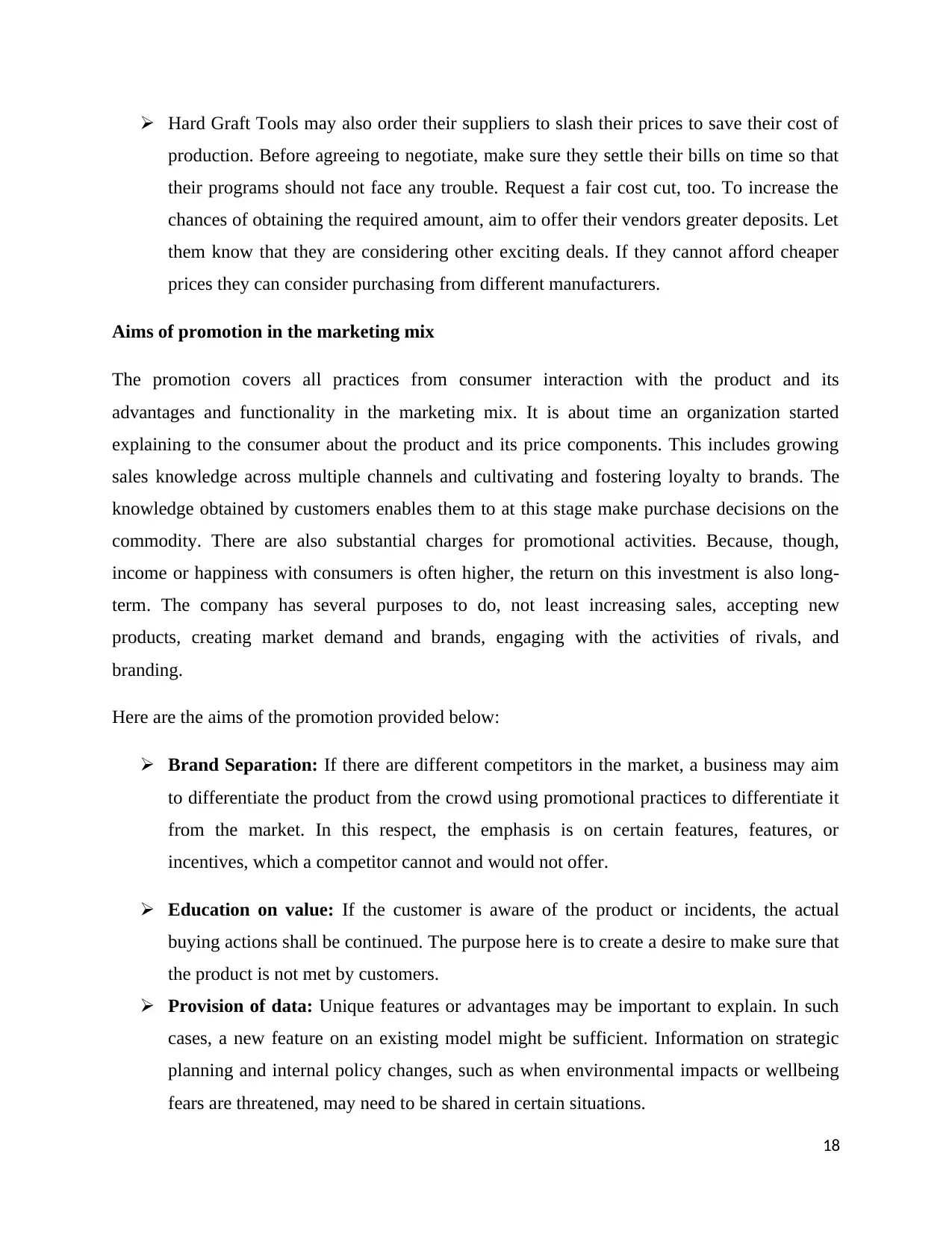
Hard Graft Tools may also order their suppliers to slash their prices to save their cost of
production. Before agreeing to negotiate, make sure they settle their bills on time so that
their programs should not face any trouble. Request a fair cost cut, too. To increase the
chances of obtaining the required amount, aim to offer their vendors greater deposits. Let
them know that they are considering other exciting deals. If they cannot afford cheaper
prices they can consider purchasing from different manufacturers.
Aims of promotion in the marketing mix
The promotion covers all practices from consumer interaction with the product and its
advantages and functionality in the marketing mix. It is about time an organization started
explaining to the consumer about the product and its price components. This includes growing
sales knowledge across multiple channels and cultivating and fostering loyalty to brands. The
knowledge obtained by customers enables them to at this stage make purchase decisions on the
commodity. There are also substantial charges for promotional activities. Because, though,
income or happiness with consumers is often higher, the return on this investment is also long-
term. The company has several purposes to do, not least increasing sales, accepting new
products, creating market demand and brands, engaging with the activities of rivals, and
branding.
Here are the aims of the promotion provided below:
Brand Separation: If there are different competitors in the market, a business may aim
to differentiate the product from the crowd using promotional practices to differentiate it
from the market. In this respect, the emphasis is on certain features, features, or
incentives, which a competitor cannot and would not offer.
Education on value: If the customer is aware of the product or incidents, the actual
buying actions shall be continued. The purpose here is to create a desire to make sure that
the product is not met by customers.
Provision of data: Unique features or advantages may be important to explain. In such
cases, a new feature on an existing model might be sufficient. Information on strategic
planning and internal policy changes, such as when environmental impacts or wellbeing
fears are threatened, may need to be shared in certain situations.
18
production. Before agreeing to negotiate, make sure they settle their bills on time so that
their programs should not face any trouble. Request a fair cost cut, too. To increase the
chances of obtaining the required amount, aim to offer their vendors greater deposits. Let
them know that they are considering other exciting deals. If they cannot afford cheaper
prices they can consider purchasing from different manufacturers.
Aims of promotion in the marketing mix
The promotion covers all practices from consumer interaction with the product and its
advantages and functionality in the marketing mix. It is about time an organization started
explaining to the consumer about the product and its price components. This includes growing
sales knowledge across multiple channels and cultivating and fostering loyalty to brands. The
knowledge obtained by customers enables them to at this stage make purchase decisions on the
commodity. There are also substantial charges for promotional activities. Because, though,
income or happiness with consumers is often higher, the return on this investment is also long-
term. The company has several purposes to do, not least increasing sales, accepting new
products, creating market demand and brands, engaging with the activities of rivals, and
branding.
Here are the aims of the promotion provided below:
Brand Separation: If there are different competitors in the market, a business may aim
to differentiate the product from the crowd using promotional practices to differentiate it
from the market. In this respect, the emphasis is on certain features, features, or
incentives, which a competitor cannot and would not offer.
Education on value: If the customer is aware of the product or incidents, the actual
buying actions shall be continued. The purpose here is to create a desire to make sure that
the product is not met by customers.
Provision of data: Unique features or advantages may be important to explain. In such
cases, a new feature on an existing model might be sufficient. Information on strategic
planning and internal policy changes, such as when environmental impacts or wellbeing
fears are threatened, may need to be shared in certain situations.
18
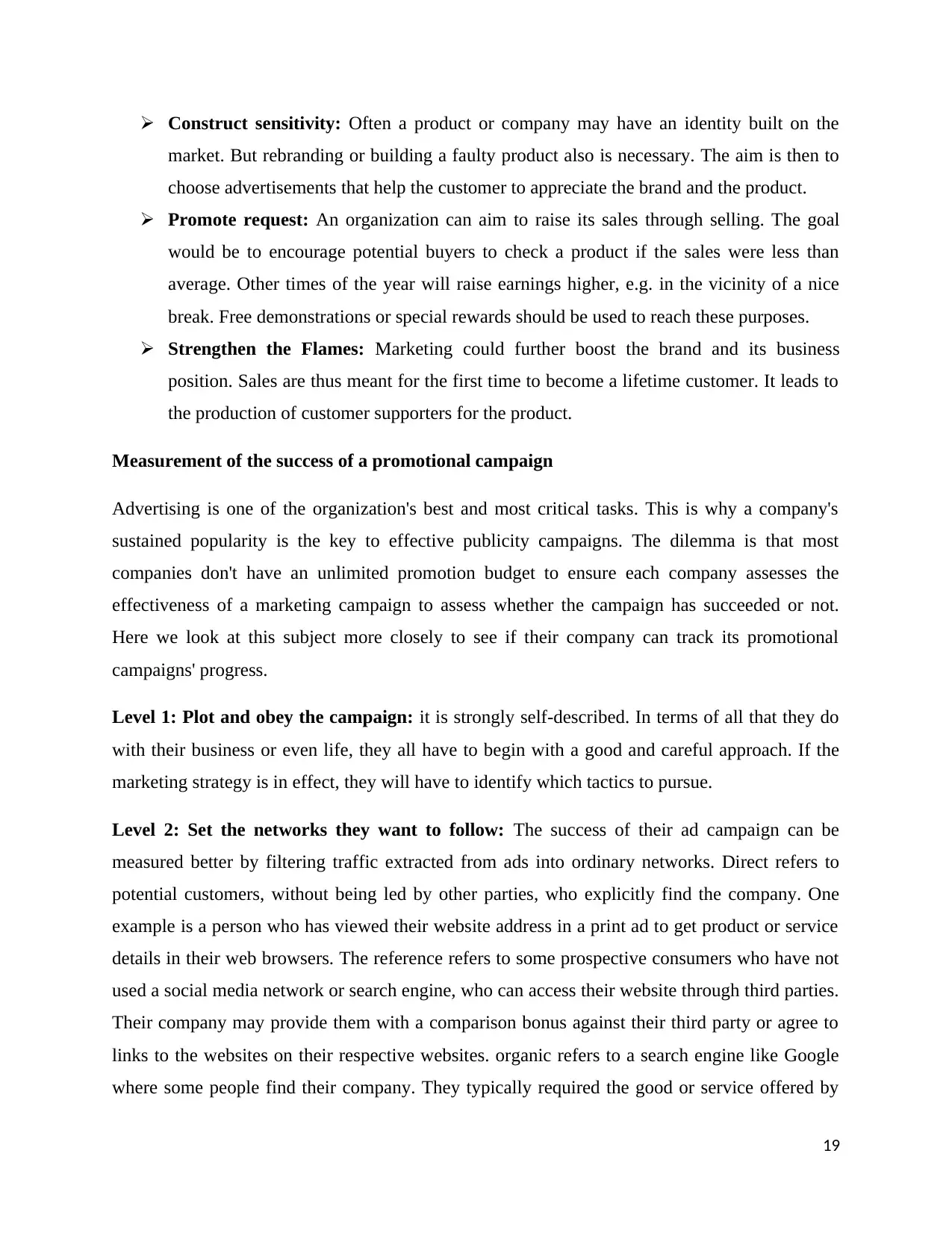
Construct sensitivity: Often a product or company may have an identity built on the
market. But rebranding or building a faulty product also is necessary. The aim is then to
choose advertisements that help the customer to appreciate the brand and the product.
Promote request: An organization can aim to raise its sales through selling. The goal
would be to encourage potential buyers to check a product if the sales were less than
average. Other times of the year will raise earnings higher, e.g. in the vicinity of a nice
break. Free demonstrations or special rewards should be used to reach these purposes.
Strengthen the Flames: Marketing could further boost the brand and its business
position. Sales are thus meant for the first time to become a lifetime customer. It leads to
the production of customer supporters for the product.
Measurement of the success of a promotional campaign
Advertising is one of the organization's best and most critical tasks. This is why a company's
sustained popularity is the key to effective publicity campaigns. The dilemma is that most
companies don't have an unlimited promotion budget to ensure each company assesses the
effectiveness of a marketing campaign to assess whether the campaign has succeeded or not.
Here we look at this subject more closely to see if their company can track its promotional
campaigns' progress.
Level 1: Plot and obey the campaign: it is strongly self-described. In terms of all that they do
with their business or even life, they all have to begin with a good and careful approach. If the
marketing strategy is in effect, they will have to identify which tactics to pursue.
Level 2: Set the networks they want to follow: The success of their ad campaign can be
measured better by filtering traffic extracted from ads into ordinary networks. Direct refers to
potential customers, without being led by other parties, who explicitly find the company. One
example is a person who has viewed their website address in a print ad to get product or service
details in their web browsers. The reference refers to some prospective consumers who have not
used a social media network or search engine, who can access their website through third parties.
Their company may provide them with a comparison bonus against their third party or agree to
links to the websites on their respective websites. organic refers to a search engine like Google
where some people find their company. They typically required the good or service offered by
19
market. But rebranding or building a faulty product also is necessary. The aim is then to
choose advertisements that help the customer to appreciate the brand and the product.
Promote request: An organization can aim to raise its sales through selling. The goal
would be to encourage potential buyers to check a product if the sales were less than
average. Other times of the year will raise earnings higher, e.g. in the vicinity of a nice
break. Free demonstrations or special rewards should be used to reach these purposes.
Strengthen the Flames: Marketing could further boost the brand and its business
position. Sales are thus meant for the first time to become a lifetime customer. It leads to
the production of customer supporters for the product.
Measurement of the success of a promotional campaign
Advertising is one of the organization's best and most critical tasks. This is why a company's
sustained popularity is the key to effective publicity campaigns. The dilemma is that most
companies don't have an unlimited promotion budget to ensure each company assesses the
effectiveness of a marketing campaign to assess whether the campaign has succeeded or not.
Here we look at this subject more closely to see if their company can track its promotional
campaigns' progress.
Level 1: Plot and obey the campaign: it is strongly self-described. In terms of all that they do
with their business or even life, they all have to begin with a good and careful approach. If the
marketing strategy is in effect, they will have to identify which tactics to pursue.
Level 2: Set the networks they want to follow: The success of their ad campaign can be
measured better by filtering traffic extracted from ads into ordinary networks. Direct refers to
potential customers, without being led by other parties, who explicitly find the company. One
example is a person who has viewed their website address in a print ad to get product or service
details in their web browsers. The reference refers to some prospective consumers who have not
used a social media network or search engine, who can access their website through third parties.
Their company may provide them with a comparison bonus against their third party or agree to
links to the websites on their respective websites. organic refers to a search engine like Google
where some people find their company. They typically required the good or service offered by
19
Paraphrase This Document
Need a fresh take? Get an instant paraphrase of this document with our AI Paraphraser
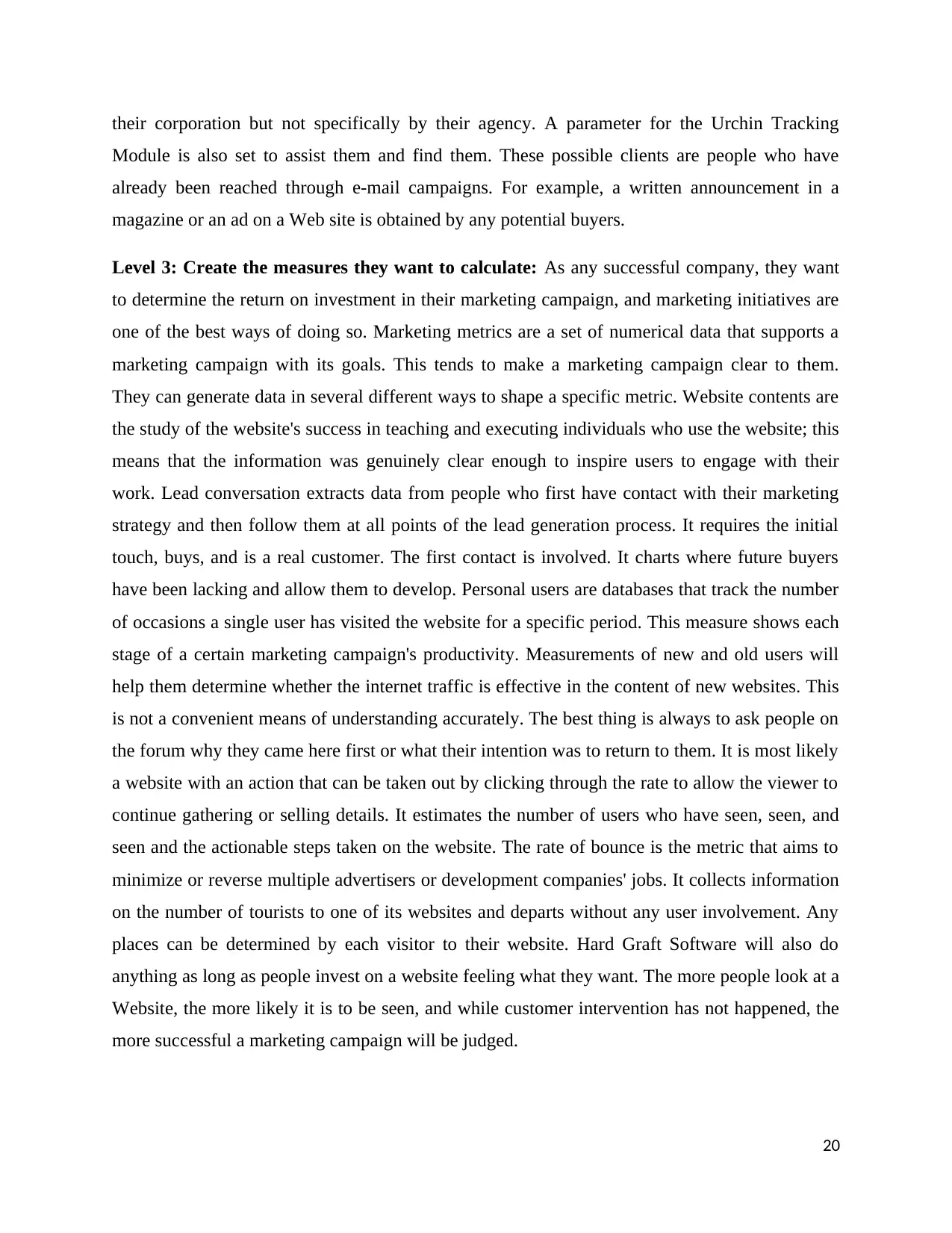
their corporation but not specifically by their agency. A parameter for the Urchin Tracking
Module is also set to assist them and find them. These possible clients are people who have
already been reached through e-mail campaigns. For example, a written announcement in a
magazine or an ad on a Web site is obtained by any potential buyers.
Level 3: Create the measures they want to calculate: As any successful company, they want
to determine the return on investment in their marketing campaign, and marketing initiatives are
one of the best ways of doing so. Marketing metrics are a set of numerical data that supports a
marketing campaign with its goals. This tends to make a marketing campaign clear to them.
They can generate data in several different ways to shape a specific metric. Website contents are
the study of the website's success in teaching and executing individuals who use the website; this
means that the information was genuinely clear enough to inspire users to engage with their
work. Lead conversation extracts data from people who first have contact with their marketing
strategy and then follow them at all points of the lead generation process. It requires the initial
touch, buys, and is a real customer. The first contact is involved. It charts where future buyers
have been lacking and allow them to develop. Personal users are databases that track the number
of occasions a single user has visited the website for a specific period. This measure shows each
stage of a certain marketing campaign's productivity. Measurements of new and old users will
help them determine whether the internet traffic is effective in the content of new websites. This
is not a convenient means of understanding accurately. The best thing is always to ask people on
the forum why they came here first or what their intention was to return to them. It is most likely
a website with an action that can be taken out by clicking through the rate to allow the viewer to
continue gathering or selling details. It estimates the number of users who have seen, seen, and
seen and the actionable steps taken on the website. The rate of bounce is the metric that aims to
minimize or reverse multiple advertisers or development companies' jobs. It collects information
on the number of tourists to one of its websites and departs without any user involvement. Any
places can be determined by each visitor to their website. Hard Graft Software will also do
anything as long as people invest on a website feeling what they want. The more people look at a
Website, the more likely it is to be seen, and while customer intervention has not happened, the
more successful a marketing campaign will be judged.
20
Module is also set to assist them and find them. These possible clients are people who have
already been reached through e-mail campaigns. For example, a written announcement in a
magazine or an ad on a Web site is obtained by any potential buyers.
Level 3: Create the measures they want to calculate: As any successful company, they want
to determine the return on investment in their marketing campaign, and marketing initiatives are
one of the best ways of doing so. Marketing metrics are a set of numerical data that supports a
marketing campaign with its goals. This tends to make a marketing campaign clear to them.
They can generate data in several different ways to shape a specific metric. Website contents are
the study of the website's success in teaching and executing individuals who use the website; this
means that the information was genuinely clear enough to inspire users to engage with their
work. Lead conversation extracts data from people who first have contact with their marketing
strategy and then follow them at all points of the lead generation process. It requires the initial
touch, buys, and is a real customer. The first contact is involved. It charts where future buyers
have been lacking and allow them to develop. Personal users are databases that track the number
of occasions a single user has visited the website for a specific period. This measure shows each
stage of a certain marketing campaign's productivity. Measurements of new and old users will
help them determine whether the internet traffic is effective in the content of new websites. This
is not a convenient means of understanding accurately. The best thing is always to ask people on
the forum why they came here first or what their intention was to return to them. It is most likely
a website with an action that can be taken out by clicking through the rate to allow the viewer to
continue gathering or selling details. It estimates the number of users who have seen, seen, and
seen and the actionable steps taken on the website. The rate of bounce is the metric that aims to
minimize or reverse multiple advertisers or development companies' jobs. It collects information
on the number of tourists to one of its websites and departs without any user involvement. Any
places can be determined by each visitor to their website. Hard Graft Software will also do
anything as long as people invest on a website feeling what they want. The more people look at a
Website, the more likely it is to be seen, and while customer intervention has not happened, the
more successful a marketing campaign will be judged.
20
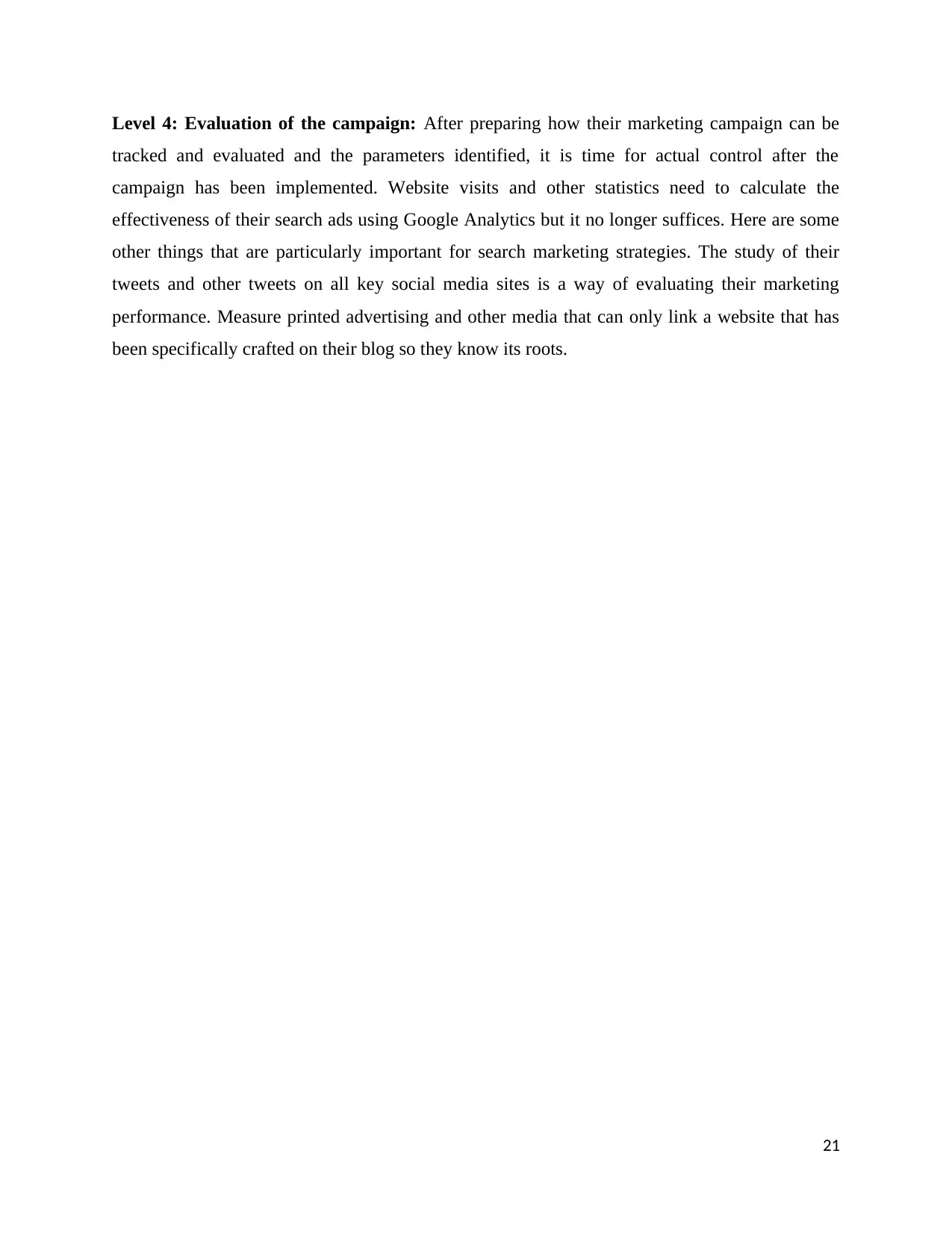
Level 4: Evaluation of the campaign: After preparing how their marketing campaign can be
tracked and evaluated and the parameters identified, it is time for actual control after the
campaign has been implemented. Website visits and other statistics need to calculate the
effectiveness of their search ads using Google Analytics but it no longer suffices. Here are some
other things that are particularly important for search marketing strategies. The study of their
tweets and other tweets on all key social media sites is a way of evaluating their marketing
performance. Measure printed advertising and other media that can only link a website that has
been specifically crafted on their blog so they know its roots.
21
tracked and evaluated and the parameters identified, it is time for actual control after the
campaign has been implemented. Website visits and other statistics need to calculate the
effectiveness of their search ads using Google Analytics but it no longer suffices. Here are some
other things that are particularly important for search marketing strategies. The study of their
tweets and other tweets on all key social media sites is a way of evaluating their marketing
performance. Measure printed advertising and other media that can only link a website that has
been specifically crafted on their blog so they know its roots.
21
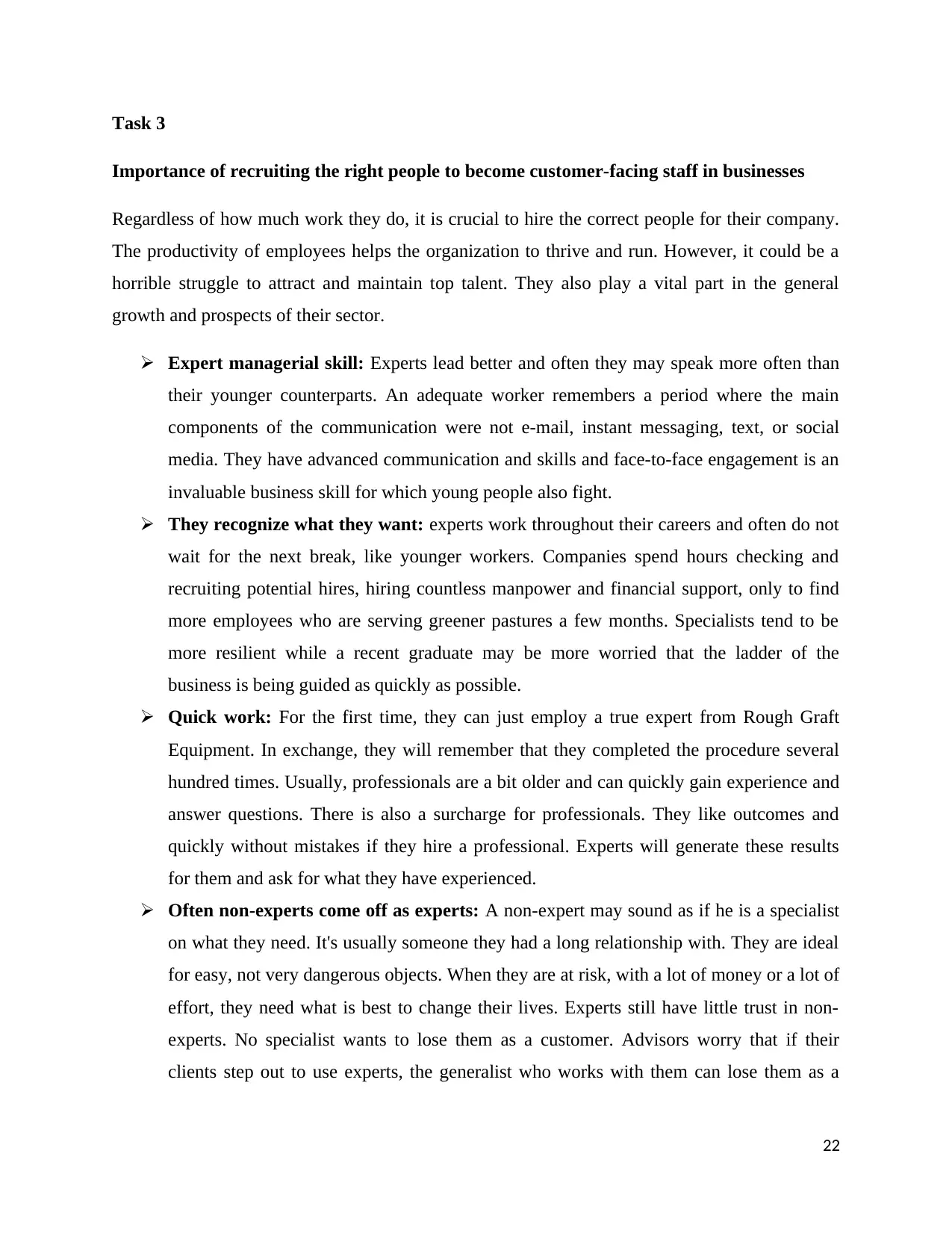
Task 3
Importance of recruiting the right people to become customer-facing staff in businesses
Regardless of how much work they do, it is crucial to hire the correct people for their company.
The productivity of employees helps the organization to thrive and run. However, it could be a
horrible struggle to attract and maintain top talent. They also play a vital part in the general
growth and prospects of their sector.
Expert managerial skill: Experts lead better and often they may speak more often than
their younger counterparts. An adequate worker remembers a period where the main
components of the communication were not e-mail, instant messaging, text, or social
media. They have advanced communication and skills and face-to-face engagement is an
invaluable business skill for which young people also fight.
They recognize what they want: experts work throughout their careers and often do not
wait for the next break, like younger workers. Companies spend hours checking and
recruiting potential hires, hiring countless manpower and financial support, only to find
more employees who are serving greener pastures a few months. Specialists tend to be
more resilient while a recent graduate may be more worried that the ladder of the
business is being guided as quickly as possible.
Quick work: For the first time, they can just employ a true expert from Rough Graft
Equipment. In exchange, they will remember that they completed the procedure several
hundred times. Usually, professionals are a bit older and can quickly gain experience and
answer questions. There is also a surcharge for professionals. They like outcomes and
quickly without mistakes if they hire a professional. Experts will generate these results
for them and ask for what they have experienced.
Often non-experts come off as experts: A non-expert may sound as if he is a specialist
on what they need. It's usually someone they had a long relationship with. They are ideal
for easy, not very dangerous objects. When they are at risk, with a lot of money or a lot of
effort, they need what is best to change their lives. Experts still have little trust in non-
experts. No specialist wants to lose them as a customer. Advisors worry that if their
clients step out to use experts, the generalist who works with them can lose them as a
22
Importance of recruiting the right people to become customer-facing staff in businesses
Regardless of how much work they do, it is crucial to hire the correct people for their company.
The productivity of employees helps the organization to thrive and run. However, it could be a
horrible struggle to attract and maintain top talent. They also play a vital part in the general
growth and prospects of their sector.
Expert managerial skill: Experts lead better and often they may speak more often than
their younger counterparts. An adequate worker remembers a period where the main
components of the communication were not e-mail, instant messaging, text, or social
media. They have advanced communication and skills and face-to-face engagement is an
invaluable business skill for which young people also fight.
They recognize what they want: experts work throughout their careers and often do not
wait for the next break, like younger workers. Companies spend hours checking and
recruiting potential hires, hiring countless manpower and financial support, only to find
more employees who are serving greener pastures a few months. Specialists tend to be
more resilient while a recent graduate may be more worried that the ladder of the
business is being guided as quickly as possible.
Quick work: For the first time, they can just employ a true expert from Rough Graft
Equipment. In exchange, they will remember that they completed the procedure several
hundred times. Usually, professionals are a bit older and can quickly gain experience and
answer questions. There is also a surcharge for professionals. They like outcomes and
quickly without mistakes if they hire a professional. Experts will generate these results
for them and ask for what they have experienced.
Often non-experts come off as experts: A non-expert may sound as if he is a specialist
on what they need. It's usually someone they had a long relationship with. They are ideal
for easy, not very dangerous objects. When they are at risk, with a lot of money or a lot of
effort, they need what is best to change their lives. Experts still have little trust in non-
experts. No specialist wants to lose them as a customer. Advisors worry that if their
clients step out to use experts, the generalist who works with them can lose them as a
22
Secure Best Marks with AI Grader
Need help grading? Try our AI Grader for instant feedback on your assignments.
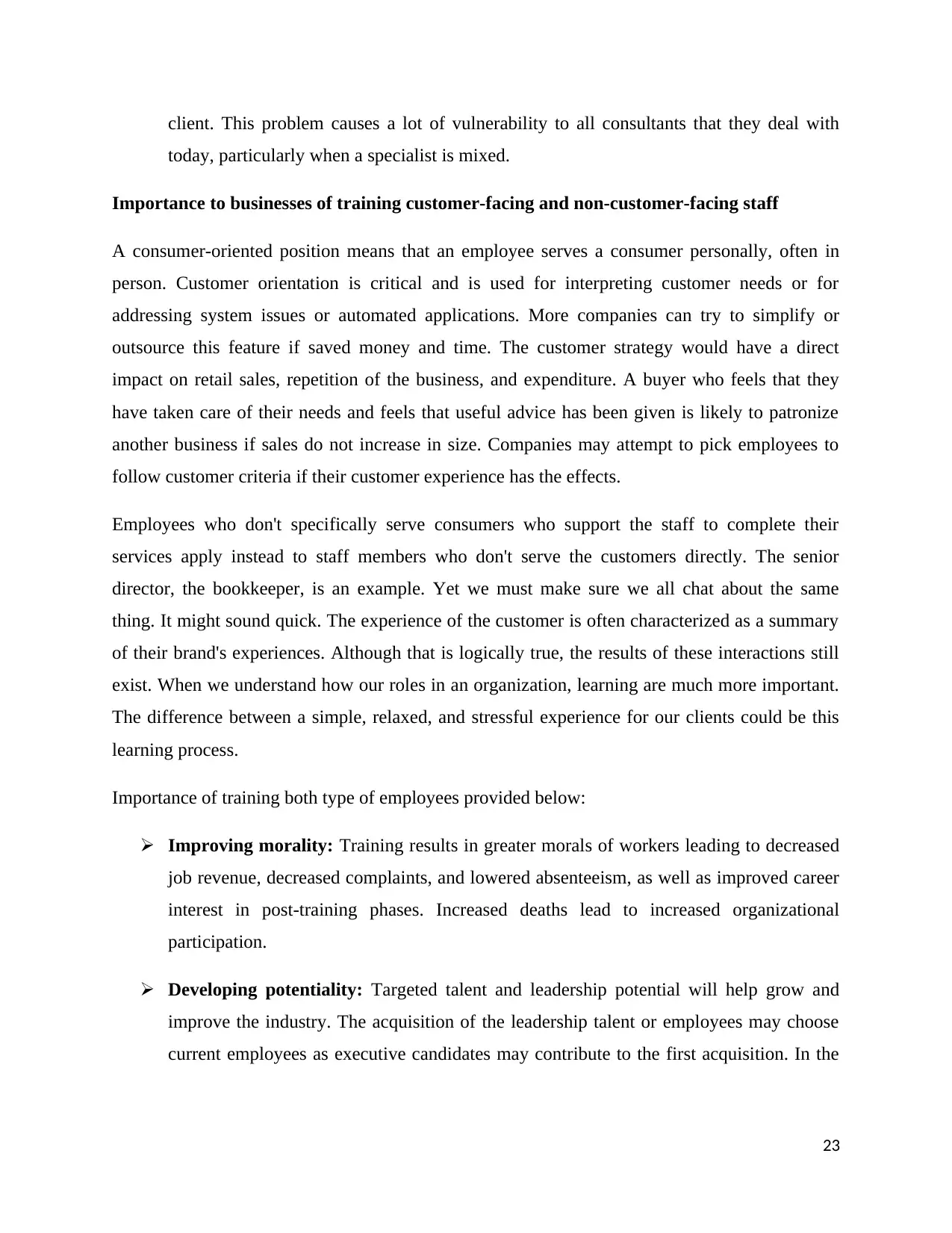
client. This problem causes a lot of vulnerability to all consultants that they deal with
today, particularly when a specialist is mixed.
Importance to businesses of training customer-facing and non-customer-facing staff
A consumer-oriented position means that an employee serves a consumer personally, often in
person. Customer orientation is critical and is used for interpreting customer needs or for
addressing system issues or automated applications. More companies can try to simplify or
outsource this feature if saved money and time. The customer strategy would have a direct
impact on retail sales, repetition of the business, and expenditure. A buyer who feels that they
have taken care of their needs and feels that useful advice has been given is likely to patronize
another business if sales do not increase in size. Companies may attempt to pick employees to
follow customer criteria if their customer experience has the effects.
Employees who don't specifically serve consumers who support the staff to complete their
services apply instead to staff members who don't serve the customers directly. The senior
director, the bookkeeper, is an example. Yet we must make sure we all chat about the same
thing. It might sound quick. The experience of the customer is often characterized as a summary
of their brand's experiences. Although that is logically true, the results of these interactions still
exist. When we understand how our roles in an organization, learning are much more important.
The difference between a simple, relaxed, and stressful experience for our clients could be this
learning process.
Importance of training both type of employees provided below:
Improving morality: Training results in greater morals of workers leading to decreased
job revenue, decreased complaints, and lowered absenteeism, as well as improved career
interest in post-training phases. Increased deaths lead to increased organizational
participation.
Developing potentiality: Targeted talent and leadership potential will help grow and
improve the industry. The acquisition of the leadership talent or employees may choose
current employees as executive candidates may contribute to the first acquisition. In the
23
today, particularly when a specialist is mixed.
Importance to businesses of training customer-facing and non-customer-facing staff
A consumer-oriented position means that an employee serves a consumer personally, often in
person. Customer orientation is critical and is used for interpreting customer needs or for
addressing system issues or automated applications. More companies can try to simplify or
outsource this feature if saved money and time. The customer strategy would have a direct
impact on retail sales, repetition of the business, and expenditure. A buyer who feels that they
have taken care of their needs and feels that useful advice has been given is likely to patronize
another business if sales do not increase in size. Companies may attempt to pick employees to
follow customer criteria if their customer experience has the effects.
Employees who don't specifically serve consumers who support the staff to complete their
services apply instead to staff members who don't serve the customers directly. The senior
director, the bookkeeper, is an example. Yet we must make sure we all chat about the same
thing. It might sound quick. The experience of the customer is often characterized as a summary
of their brand's experiences. Although that is logically true, the results of these interactions still
exist. When we understand how our roles in an organization, learning are much more important.
The difference between a simple, relaxed, and stressful experience for our clients could be this
learning process.
Importance of training both type of employees provided below:
Improving morality: Training results in greater morals of workers leading to decreased
job revenue, decreased complaints, and lowered absenteeism, as well as improved career
interest in post-training phases. Increased deaths lead to increased organizational
participation.
Developing potentiality: Targeted talent and leadership potential will help grow and
improve the industry. The acquisition of the leadership talent or employees may choose
current employees as executive candidates may contribute to the first acquisition. In the
23
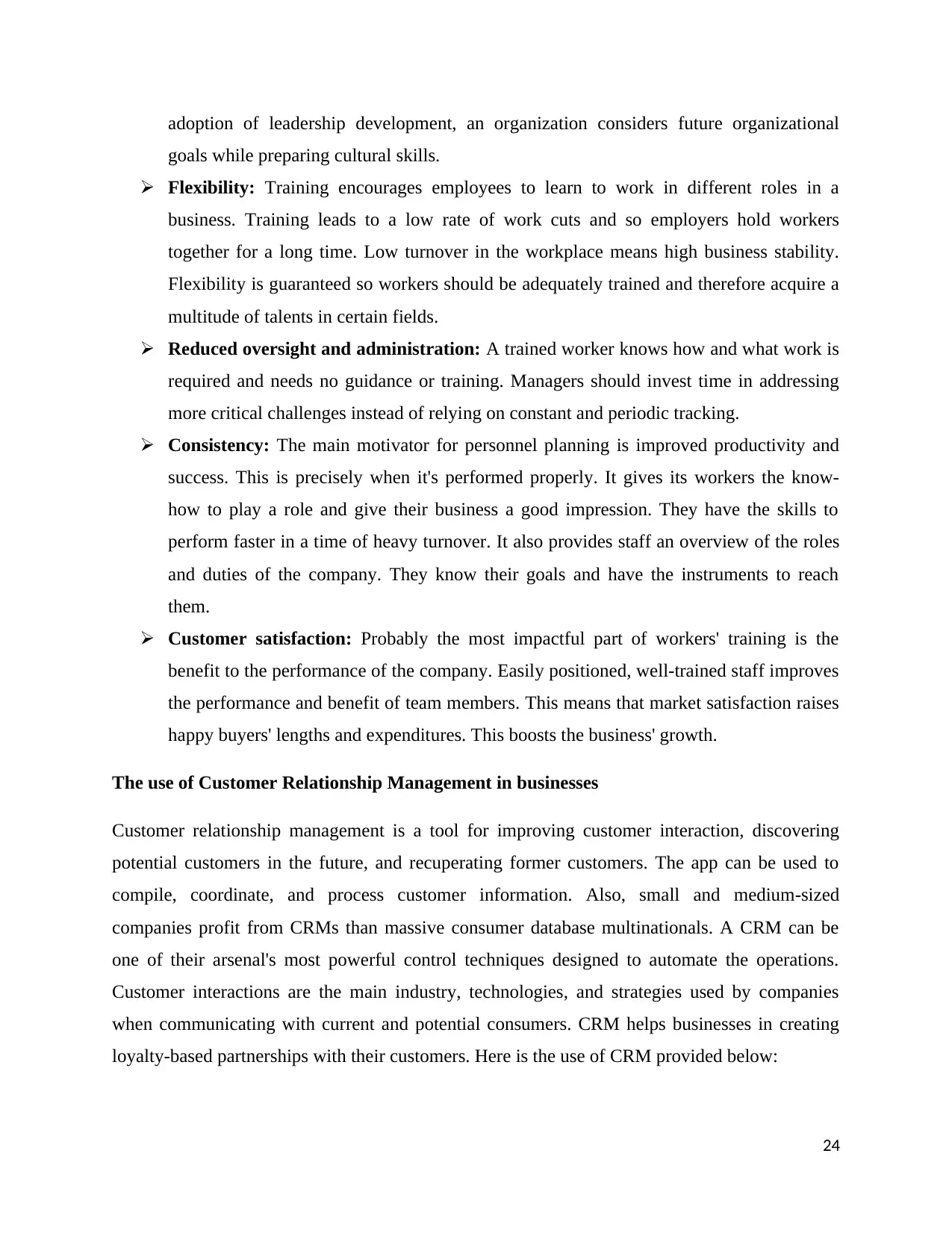
adoption of leadership development, an organization considers future organizational
goals while preparing cultural skills.
Flexibility: Training encourages employees to learn to work in different roles in a
business. Training leads to a low rate of work cuts and so employers hold workers
together for a long time. Low turnover in the workplace means high business stability.
Flexibility is guaranteed so workers should be adequately trained and therefore acquire a
multitude of talents in certain fields.
Reduced oversight and administration: A trained worker knows how and what work is
required and needs no guidance or training. Managers should invest time in addressing
more critical challenges instead of relying on constant and periodic tracking.
Consistency: The main motivator for personnel planning is improved productivity and
success. This is precisely when it's performed properly. It gives its workers the know-
how to play a role and give their business a good impression. They have the skills to
perform faster in a time of heavy turnover. It also provides staff an overview of the roles
and duties of the company. They know their goals and have the instruments to reach
them.
Customer satisfaction: Probably the most impactful part of workers' training is the
benefit to the performance of the company. Easily positioned, well-trained staff improves
the performance and benefit of team members. This means that market satisfaction raises
happy buyers' lengths and expenditures. This boosts the business' growth.
The use of Customer Relationship Management in businesses
Customer relationship management is a tool for improving customer interaction, discovering
potential customers in the future, and recuperating former customers. The app can be used to
compile, coordinate, and process customer information. Also, small and medium-sized
companies profit from CRMs than massive consumer database multinationals. A CRM can be
one of their arsenal's most powerful control techniques designed to automate the operations.
Customer interactions are the main industry, technologies, and strategies used by companies
when communicating with current and potential consumers. CRM helps businesses in creating
loyalty-based partnerships with their customers. Here is the use of CRM provided below:
24
goals while preparing cultural skills.
Flexibility: Training encourages employees to learn to work in different roles in a
business. Training leads to a low rate of work cuts and so employers hold workers
together for a long time. Low turnover in the workplace means high business stability.
Flexibility is guaranteed so workers should be adequately trained and therefore acquire a
multitude of talents in certain fields.
Reduced oversight and administration: A trained worker knows how and what work is
required and needs no guidance or training. Managers should invest time in addressing
more critical challenges instead of relying on constant and periodic tracking.
Consistency: The main motivator for personnel planning is improved productivity and
success. This is precisely when it's performed properly. It gives its workers the know-
how to play a role and give their business a good impression. They have the skills to
perform faster in a time of heavy turnover. It also provides staff an overview of the roles
and duties of the company. They know their goals and have the instruments to reach
them.
Customer satisfaction: Probably the most impactful part of workers' training is the
benefit to the performance of the company. Easily positioned, well-trained staff improves
the performance and benefit of team members. This means that market satisfaction raises
happy buyers' lengths and expenditures. This boosts the business' growth.
The use of Customer Relationship Management in businesses
Customer relationship management is a tool for improving customer interaction, discovering
potential customers in the future, and recuperating former customers. The app can be used to
compile, coordinate, and process customer information. Also, small and medium-sized
companies profit from CRMs than massive consumer database multinationals. A CRM can be
one of their arsenal's most powerful control techniques designed to automate the operations.
Customer interactions are the main industry, technologies, and strategies used by companies
when communicating with current and potential consumers. CRM helps businesses in creating
loyalty-based partnerships with their customers. Here is the use of CRM provided below:
24
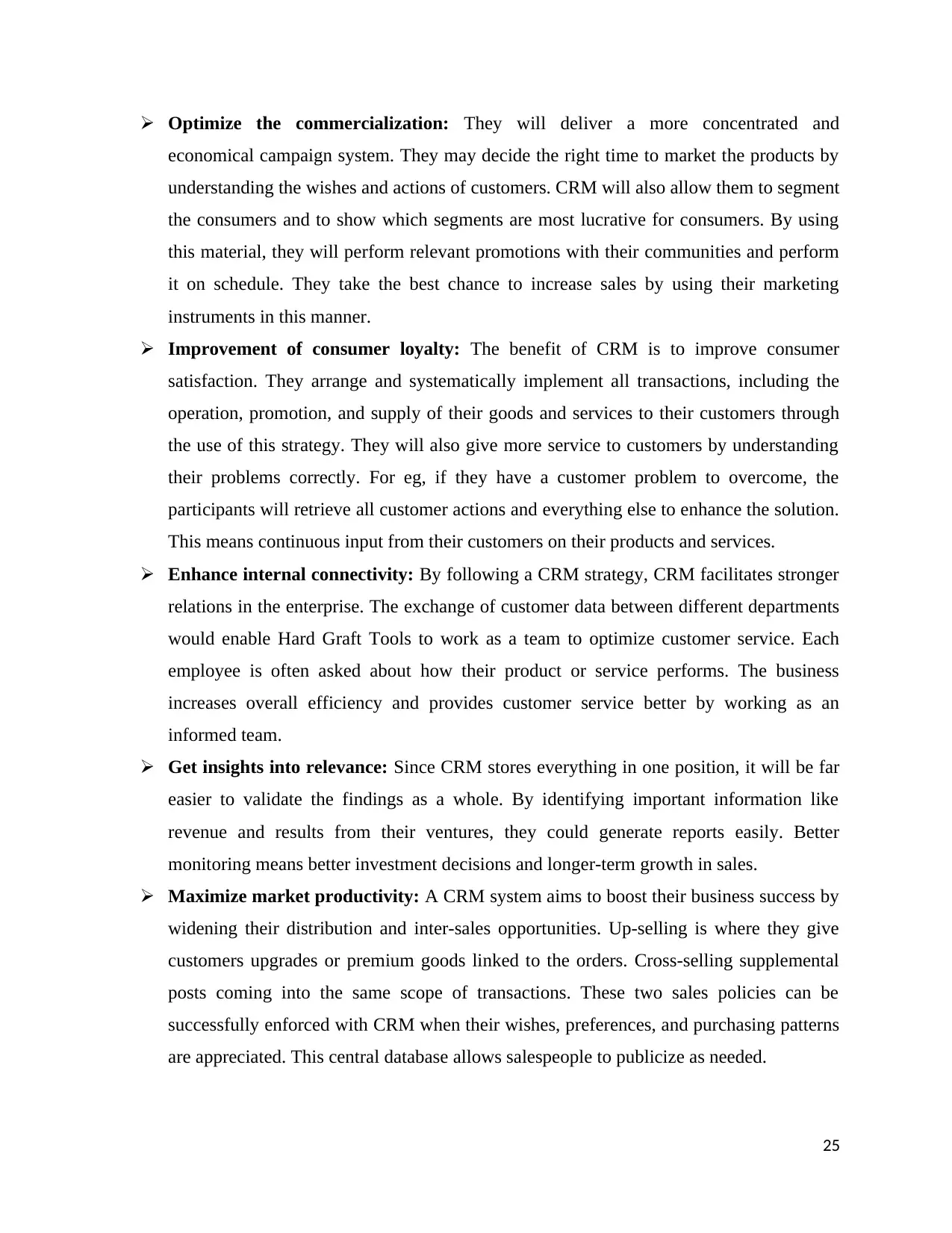
Optimize the commercialization: They will deliver a more concentrated and
economical campaign system. They may decide the right time to market the products by
understanding the wishes and actions of customers. CRM will also allow them to segment
the consumers and to show which segments are most lucrative for consumers. By using
this material, they will perform relevant promotions with their communities and perform
it on schedule. They take the best chance to increase sales by using their marketing
instruments in this manner.
Improvement of consumer loyalty: The benefit of CRM is to improve consumer
satisfaction. They arrange and systematically implement all transactions, including the
operation, promotion, and supply of their goods and services to their customers through
the use of this strategy. They will also give more service to customers by understanding
their problems correctly. For eg, if they have a customer problem to overcome, the
participants will retrieve all customer actions and everything else to enhance the solution.
This means continuous input from their customers on their products and services.
Enhance internal connectivity: By following a CRM strategy, CRM facilitates stronger
relations in the enterprise. The exchange of customer data between different departments
would enable Hard Graft Tools to work as a team to optimize customer service. Each
employee is often asked about how their product or service performs. The business
increases overall efficiency and provides customer service better by working as an
informed team.
Get insights into relevance: Since CRM stores everything in one position, it will be far
easier to validate the findings as a whole. By identifying important information like
revenue and results from their ventures, they could generate reports easily. Better
monitoring means better investment decisions and longer-term growth in sales.
Maximize market productivity: A CRM system aims to boost their business success by
widening their distribution and inter-sales opportunities. Up-selling is where they give
customers upgrades or premium goods linked to the orders. Cross-selling supplemental
posts coming into the same scope of transactions. These two sales policies can be
successfully enforced with CRM when their wishes, preferences, and purchasing patterns
are appreciated. This central database allows salespeople to publicize as needed.
25
economical campaign system. They may decide the right time to market the products by
understanding the wishes and actions of customers. CRM will also allow them to segment
the consumers and to show which segments are most lucrative for consumers. By using
this material, they will perform relevant promotions with their communities and perform
it on schedule. They take the best chance to increase sales by using their marketing
instruments in this manner.
Improvement of consumer loyalty: The benefit of CRM is to improve consumer
satisfaction. They arrange and systematically implement all transactions, including the
operation, promotion, and supply of their goods and services to their customers through
the use of this strategy. They will also give more service to customers by understanding
their problems correctly. For eg, if they have a customer problem to overcome, the
participants will retrieve all customer actions and everything else to enhance the solution.
This means continuous input from their customers on their products and services.
Enhance internal connectivity: By following a CRM strategy, CRM facilitates stronger
relations in the enterprise. The exchange of customer data between different departments
would enable Hard Graft Tools to work as a team to optimize customer service. Each
employee is often asked about how their product or service performs. The business
increases overall efficiency and provides customer service better by working as an
informed team.
Get insights into relevance: Since CRM stores everything in one position, it will be far
easier to validate the findings as a whole. By identifying important information like
revenue and results from their ventures, they could generate reports easily. Better
monitoring means better investment decisions and longer-term growth in sales.
Maximize market productivity: A CRM system aims to boost their business success by
widening their distribution and inter-sales opportunities. Up-selling is where they give
customers upgrades or premium goods linked to the orders. Cross-selling supplemental
posts coming into the same scope of transactions. These two sales policies can be
successfully enforced with CRM when their wishes, preferences, and purchasing patterns
are appreciated. This central database allows salespeople to publicize as needed.
25
Paraphrase This Document
Need a fresh take? Get an instant paraphrase of this document with our AI Paraphraser
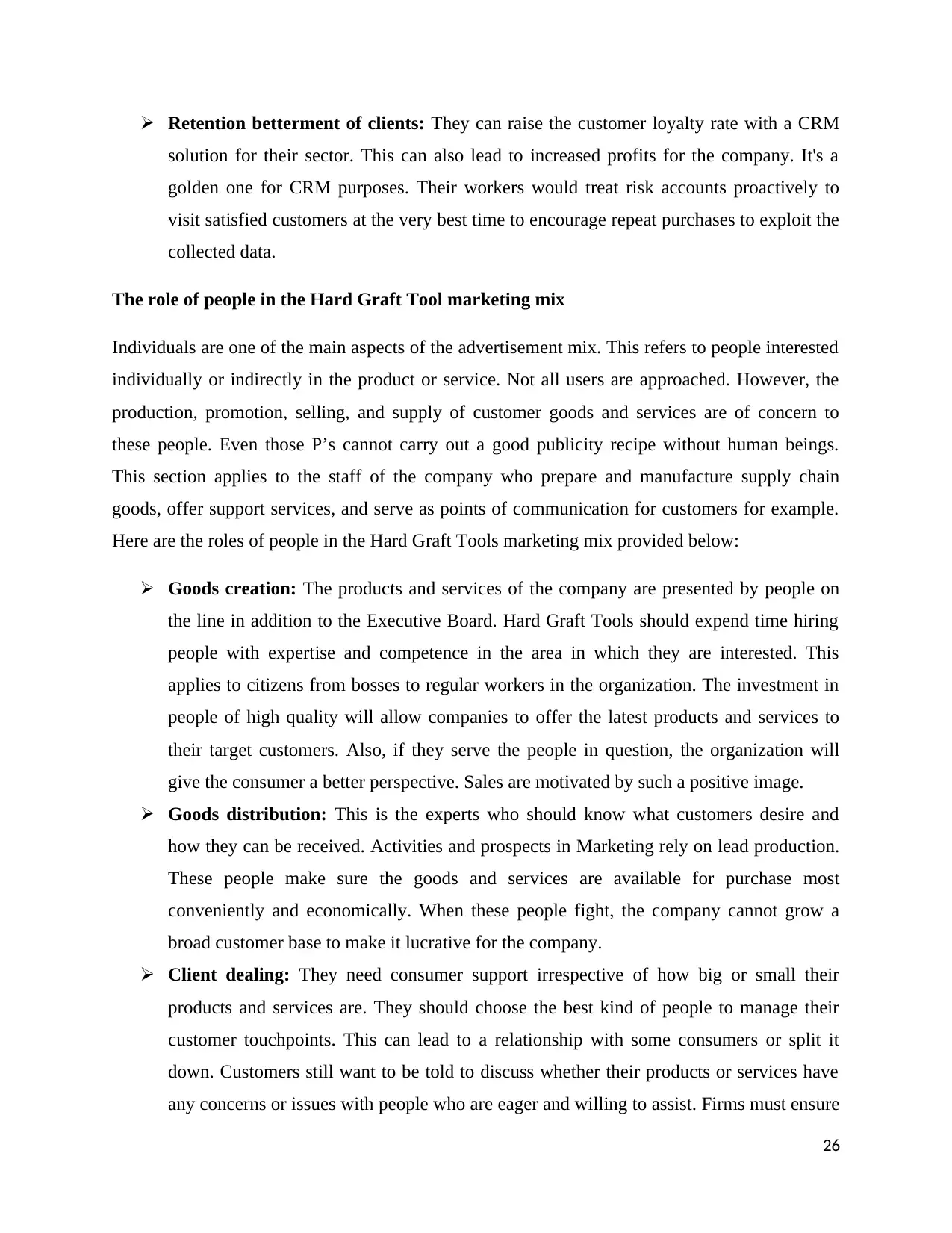
Retention betterment of clients: They can raise the customer loyalty rate with a CRM
solution for their sector. This can also lead to increased profits for the company. It's a
golden one for CRM purposes. Their workers would treat risk accounts proactively to
visit satisfied customers at the very best time to encourage repeat purchases to exploit the
collected data.
The role of people in the Hard Graft Tool marketing mix
Individuals are one of the main aspects of the advertisement mix. This refers to people interested
individually or indirectly in the product or service. Not all users are approached. However, the
production, promotion, selling, and supply of customer goods and services are of concern to
these people. Even those P’s cannot carry out a good publicity recipe without human beings.
This section applies to the staff of the company who prepare and manufacture supply chain
goods, offer support services, and serve as points of communication for customers for example.
Here are the roles of people in the Hard Graft Tools marketing mix provided below:
Goods creation: The products and services of the company are presented by people on
the line in addition to the Executive Board. Hard Graft Tools should expend time hiring
people with expertise and competence in the area in which they are interested. This
applies to citizens from bosses to regular workers in the organization. The investment in
people of high quality will allow companies to offer the latest products and services to
their target customers. Also, if they serve the people in question, the organization will
give the consumer a better perspective. Sales are motivated by such a positive image.
Goods distribution: This is the experts who should know what customers desire and
how they can be received. Activities and prospects in Marketing rely on lead production.
These people make sure the goods and services are available for purchase most
conveniently and economically. When these people fight, the company cannot grow a
broad customer base to make it lucrative for the company.
Client dealing: They need consumer support irrespective of how big or small their
products and services are. They should choose the best kind of people to manage their
customer touchpoints. This can lead to a relationship with some consumers or split it
down. Customers still want to be told to discuss whether their products or services have
any concerns or issues with people who are eager and willing to assist. Firms must ensure
26
solution for their sector. This can also lead to increased profits for the company. It's a
golden one for CRM purposes. Their workers would treat risk accounts proactively to
visit satisfied customers at the very best time to encourage repeat purchases to exploit the
collected data.
The role of people in the Hard Graft Tool marketing mix
Individuals are one of the main aspects of the advertisement mix. This refers to people interested
individually or indirectly in the product or service. Not all users are approached. However, the
production, promotion, selling, and supply of customer goods and services are of concern to
these people. Even those P’s cannot carry out a good publicity recipe without human beings.
This section applies to the staff of the company who prepare and manufacture supply chain
goods, offer support services, and serve as points of communication for customers for example.
Here are the roles of people in the Hard Graft Tools marketing mix provided below:
Goods creation: The products and services of the company are presented by people on
the line in addition to the Executive Board. Hard Graft Tools should expend time hiring
people with expertise and competence in the area in which they are interested. This
applies to citizens from bosses to regular workers in the organization. The investment in
people of high quality will allow companies to offer the latest products and services to
their target customers. Also, if they serve the people in question, the organization will
give the consumer a better perspective. Sales are motivated by such a positive image.
Goods distribution: This is the experts who should know what customers desire and
how they can be received. Activities and prospects in Marketing rely on lead production.
These people make sure the goods and services are available for purchase most
conveniently and economically. When these people fight, the company cannot grow a
broad customer base to make it lucrative for the company.
Client dealing: They need consumer support irrespective of how big or small their
products and services are. They should choose the best kind of people to manage their
customer touchpoints. This can lead to a relationship with some consumers or split it
down. Customers still want to be told to discuss whether their products or services have
any concerns or issues with people who are eager and willing to assist. Firms must ensure
26
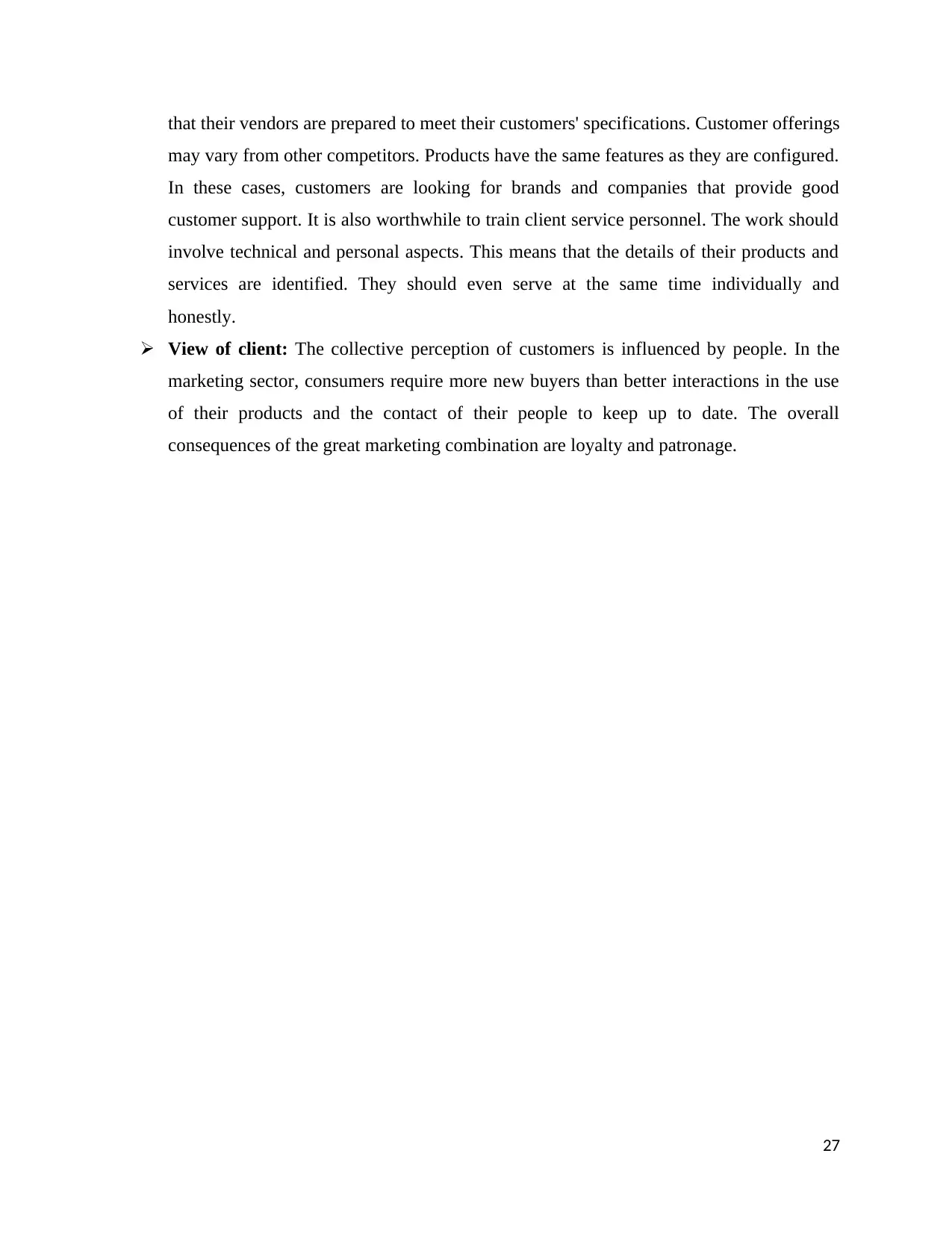
that their vendors are prepared to meet their customers' specifications. Customer offerings
may vary from other competitors. Products have the same features as they are configured.
In these cases, customers are looking for brands and companies that provide good
customer support. It is also worthwhile to train client service personnel. The work should
involve technical and personal aspects. This means that the details of their products and
services are identified. They should even serve at the same time individually and
honestly.
View of client: The collective perception of customers is influenced by people. In the
marketing sector, consumers require more new buyers than better interactions in the use
of their products and the contact of their people to keep up to date. The overall
consequences of the great marketing combination are loyalty and patronage.
27
may vary from other competitors. Products have the same features as they are configured.
In these cases, customers are looking for brands and companies that provide good
customer support. It is also worthwhile to train client service personnel. The work should
involve technical and personal aspects. This means that the details of their products and
services are identified. They should even serve at the same time individually and
honestly.
View of client: The collective perception of customers is influenced by people. In the
marketing sector, consumers require more new buyers than better interactions in the use
of their products and the contact of their people to keep up to date. The overall
consequences of the great marketing combination are loyalty and patronage.
27
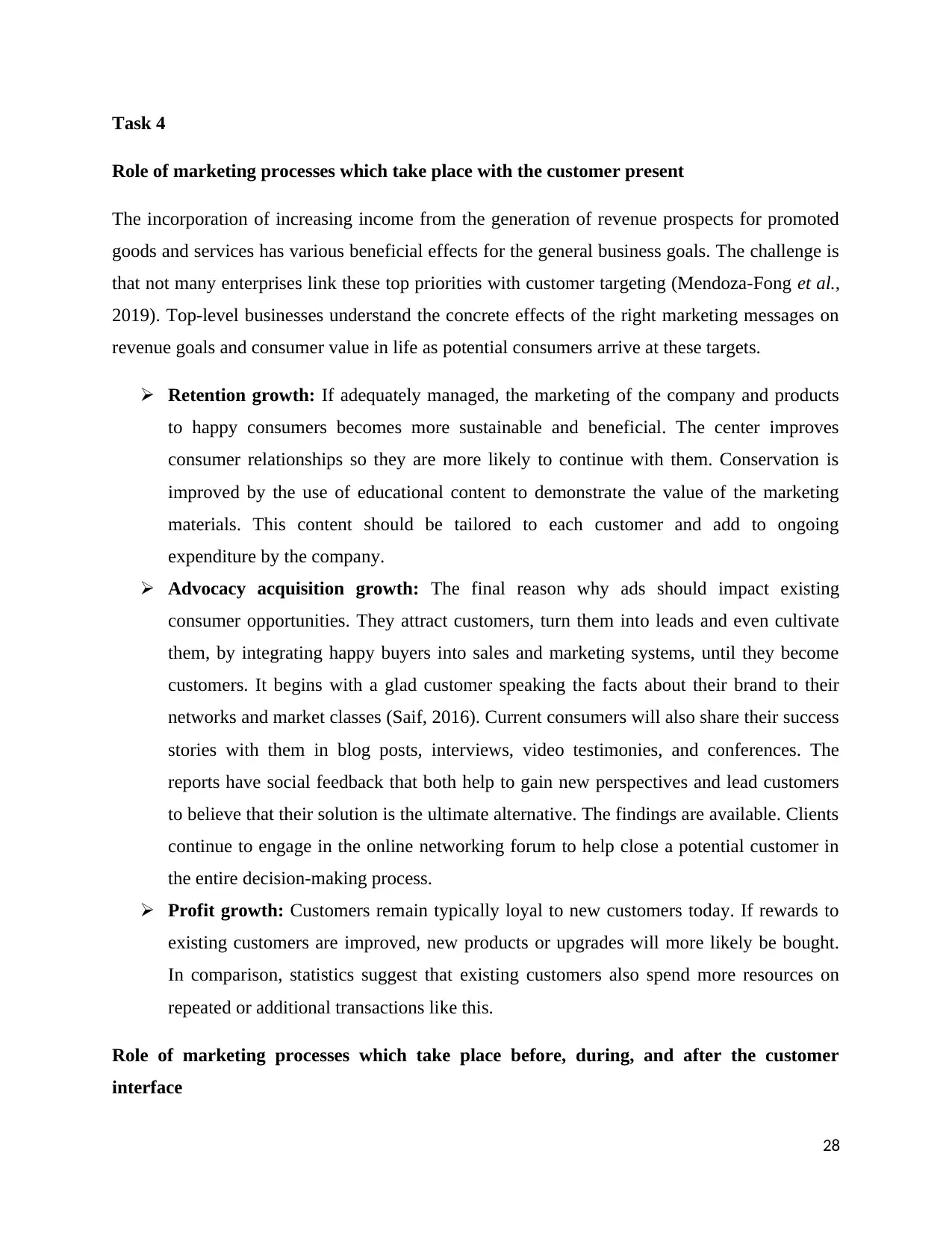
Task 4
Role of marketing processes which take place with the customer present
The incorporation of increasing income from the generation of revenue prospects for promoted
goods and services has various beneficial effects for the general business goals. The challenge is
that not many enterprises link these top priorities with customer targeting (Mendoza-Fong et al.,
2019). Top-level businesses understand the concrete effects of the right marketing messages on
revenue goals and consumer value in life as potential consumers arrive at these targets.
Retention growth: If adequately managed, the marketing of the company and products
to happy consumers becomes more sustainable and beneficial. The center improves
consumer relationships so they are more likely to continue with them. Conservation is
improved by the use of educational content to demonstrate the value of the marketing
materials. This content should be tailored to each customer and add to ongoing
expenditure by the company.
Advocacy acquisition growth: The final reason why ads should impact existing
consumer opportunities. They attract customers, turn them into leads and even cultivate
them, by integrating happy buyers into sales and marketing systems, until they become
customers. It begins with a glad customer speaking the facts about their brand to their
networks and market classes (Saif, 2016). Current consumers will also share their success
stories with them in blog posts, interviews, video testimonies, and conferences. The
reports have social feedback that both help to gain new perspectives and lead customers
to believe that their solution is the ultimate alternative. The findings are available. Clients
continue to engage in the online networking forum to help close a potential customer in
the entire decision-making process.
Profit growth: Customers remain typically loyal to new customers today. If rewards to
existing customers are improved, new products or upgrades will more likely be bought.
In comparison, statistics suggest that existing customers also spend more resources on
repeated or additional transactions like this.
Role of marketing processes which take place before, during, and after the customer
interface
28
Role of marketing processes which take place with the customer present
The incorporation of increasing income from the generation of revenue prospects for promoted
goods and services has various beneficial effects for the general business goals. The challenge is
that not many enterprises link these top priorities with customer targeting (Mendoza-Fong et al.,
2019). Top-level businesses understand the concrete effects of the right marketing messages on
revenue goals and consumer value in life as potential consumers arrive at these targets.
Retention growth: If adequately managed, the marketing of the company and products
to happy consumers becomes more sustainable and beneficial. The center improves
consumer relationships so they are more likely to continue with them. Conservation is
improved by the use of educational content to demonstrate the value of the marketing
materials. This content should be tailored to each customer and add to ongoing
expenditure by the company.
Advocacy acquisition growth: The final reason why ads should impact existing
consumer opportunities. They attract customers, turn them into leads and even cultivate
them, by integrating happy buyers into sales and marketing systems, until they become
customers. It begins with a glad customer speaking the facts about their brand to their
networks and market classes (Saif, 2016). Current consumers will also share their success
stories with them in blog posts, interviews, video testimonies, and conferences. The
reports have social feedback that both help to gain new perspectives and lead customers
to believe that their solution is the ultimate alternative. The findings are available. Clients
continue to engage in the online networking forum to help close a potential customer in
the entire decision-making process.
Profit growth: Customers remain typically loyal to new customers today. If rewards to
existing customers are improved, new products or upgrades will more likely be bought.
In comparison, statistics suggest that existing customers also spend more resources on
repeated or additional transactions like this.
Role of marketing processes which take place before, during, and after the customer
interface
28
Secure Best Marks with AI Grader
Need help grading? Try our AI Grader for instant feedback on your assignments.
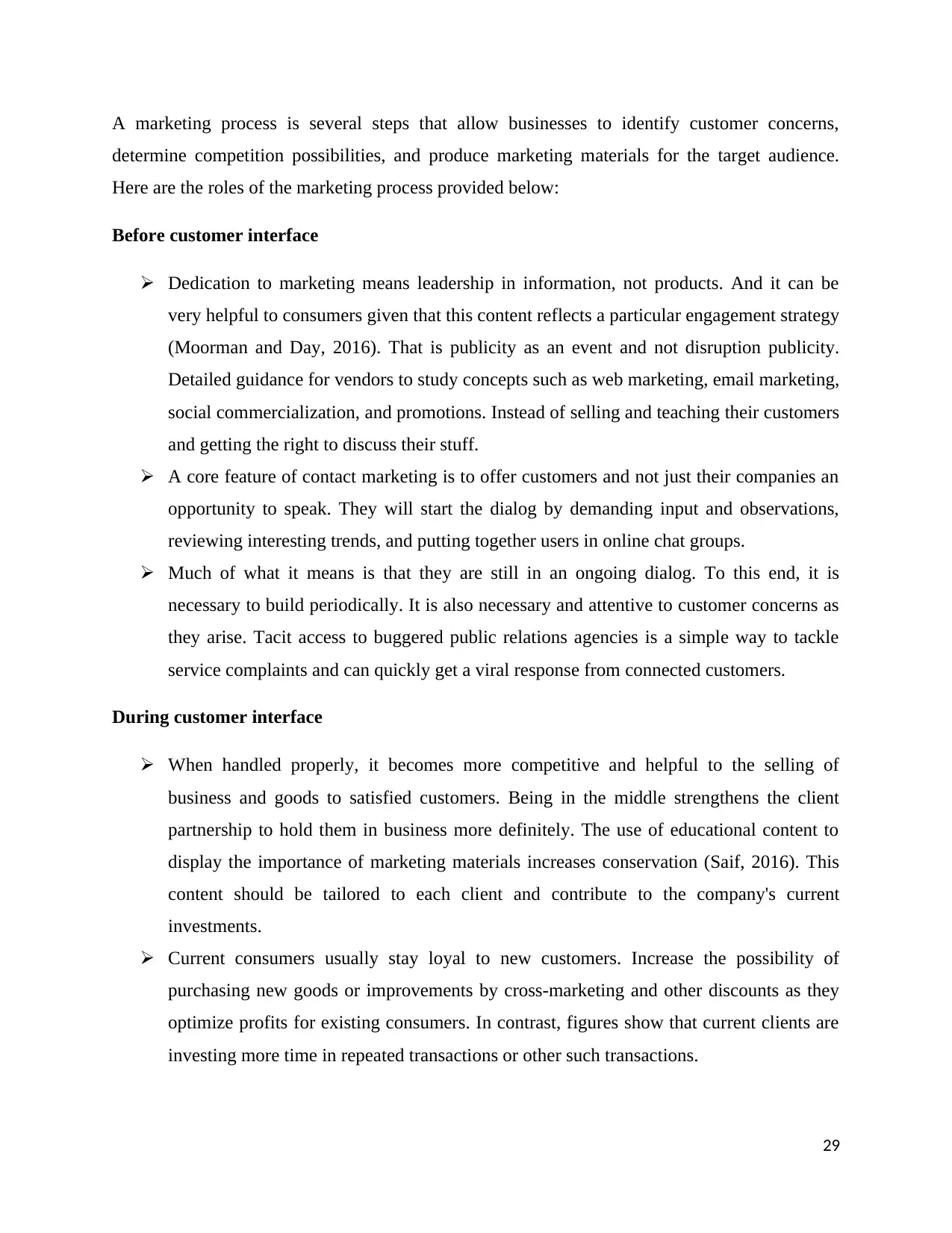
A marketing process is several steps that allow businesses to identify customer concerns,
determine competition possibilities, and produce marketing materials for the target audience.
Here are the roles of the marketing process provided below:
Before customer interface
Dedication to marketing means leadership in information, not products. And it can be
very helpful to consumers given that this content reflects a particular engagement strategy
(Moorman and Day, 2016). That is publicity as an event and not disruption publicity.
Detailed guidance for vendors to study concepts such as web marketing, email marketing,
social commercialization, and promotions. Instead of selling and teaching their customers
and getting the right to discuss their stuff.
A core feature of contact marketing is to offer customers and not just their companies an
opportunity to speak. They will start the dialog by demanding input and observations,
reviewing interesting trends, and putting together users in online chat groups.
Much of what it means is that they are still in an ongoing dialog. To this end, it is
necessary to build periodically. It is also necessary and attentive to customer concerns as
they arise. Tacit access to buggered public relations agencies is a simple way to tackle
service complaints and can quickly get a viral response from connected customers.
During customer interface
When handled properly, it becomes more competitive and helpful to the selling of
business and goods to satisfied customers. Being in the middle strengthens the client
partnership to hold them in business more definitely. The use of educational content to
display the importance of marketing materials increases conservation (Saif, 2016). This
content should be tailored to each client and contribute to the company's current
investments.
Current consumers usually stay loyal to new customers. Increase the possibility of
purchasing new goods or improvements by cross-marketing and other discounts as they
optimize profits for existing consumers. In contrast, figures show that current clients are
investing more time in repeated transactions or other such transactions.
29
determine competition possibilities, and produce marketing materials for the target audience.
Here are the roles of the marketing process provided below:
Before customer interface
Dedication to marketing means leadership in information, not products. And it can be
very helpful to consumers given that this content reflects a particular engagement strategy
(Moorman and Day, 2016). That is publicity as an event and not disruption publicity.
Detailed guidance for vendors to study concepts such as web marketing, email marketing,
social commercialization, and promotions. Instead of selling and teaching their customers
and getting the right to discuss their stuff.
A core feature of contact marketing is to offer customers and not just their companies an
opportunity to speak. They will start the dialog by demanding input and observations,
reviewing interesting trends, and putting together users in online chat groups.
Much of what it means is that they are still in an ongoing dialog. To this end, it is
necessary to build periodically. It is also necessary and attentive to customer concerns as
they arise. Tacit access to buggered public relations agencies is a simple way to tackle
service complaints and can quickly get a viral response from connected customers.
During customer interface
When handled properly, it becomes more competitive and helpful to the selling of
business and goods to satisfied customers. Being in the middle strengthens the client
partnership to hold them in business more definitely. The use of educational content to
display the importance of marketing materials increases conservation (Saif, 2016). This
content should be tailored to each client and contribute to the company's current
investments.
Current consumers usually stay loyal to new customers. Increase the possibility of
purchasing new goods or improvements by cross-marketing and other discounts as they
optimize profits for existing consumers. In contrast, figures show that current clients are
investing more time in repeated transactions or other such transactions.
29
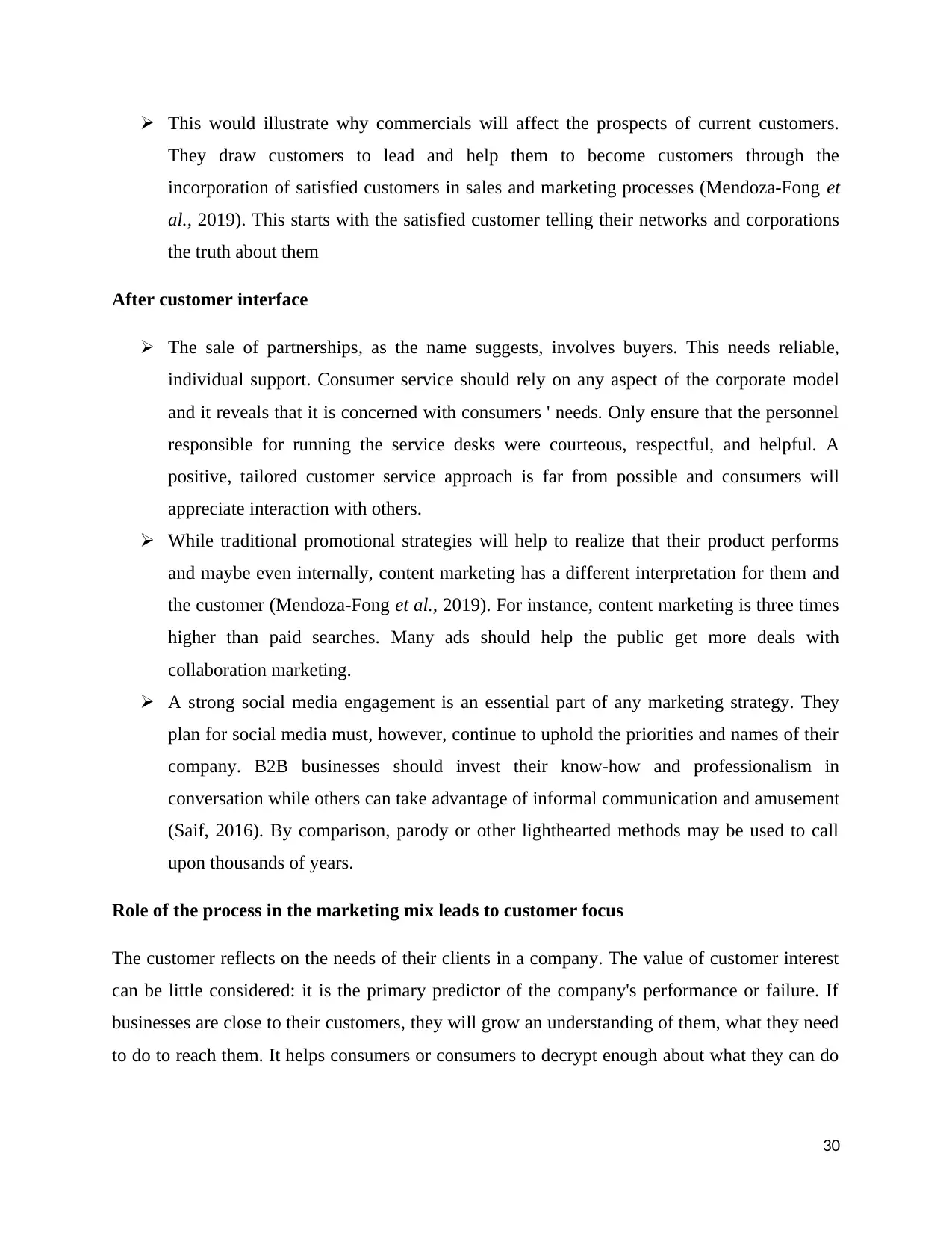
This would illustrate why commercials will affect the prospects of current customers.
They draw customers to lead and help them to become customers through the
incorporation of satisfied customers in sales and marketing processes (Mendoza-Fong et
al., 2019). This starts with the satisfied customer telling their networks and corporations
the truth about them
After customer interface
The sale of partnerships, as the name suggests, involves buyers. This needs reliable,
individual support. Consumer service should rely on any aspect of the corporate model
and it reveals that it is concerned with consumers ' needs. Only ensure that the personnel
responsible for running the service desks were courteous, respectful, and helpful. A
positive, tailored customer service approach is far from possible and consumers will
appreciate interaction with others.
While traditional promotional strategies will help to realize that their product performs
and maybe even internally, content marketing has a different interpretation for them and
the customer (Mendoza-Fong et al., 2019). For instance, content marketing is three times
higher than paid searches. Many ads should help the public get more deals with
collaboration marketing.
A strong social media engagement is an essential part of any marketing strategy. They
plan for social media must, however, continue to uphold the priorities and names of their
company. B2B businesses should invest their know-how and professionalism in
conversation while others can take advantage of informal communication and amusement
(Saif, 2016). By comparison, parody or other lighthearted methods may be used to call
upon thousands of years.
Role of the process in the marketing mix leads to customer focus
The customer reflects on the needs of their clients in a company. The value of customer interest
can be little considered: it is the primary predictor of the company's performance or failure. If
businesses are close to their customers, they will grow an understanding of them, what they need
to do to reach them. It helps consumers or consumers to decrypt enough about what they can do
30
They draw customers to lead and help them to become customers through the
incorporation of satisfied customers in sales and marketing processes (Mendoza-Fong et
al., 2019). This starts with the satisfied customer telling their networks and corporations
the truth about them
After customer interface
The sale of partnerships, as the name suggests, involves buyers. This needs reliable,
individual support. Consumer service should rely on any aspect of the corporate model
and it reveals that it is concerned with consumers ' needs. Only ensure that the personnel
responsible for running the service desks were courteous, respectful, and helpful. A
positive, tailored customer service approach is far from possible and consumers will
appreciate interaction with others.
While traditional promotional strategies will help to realize that their product performs
and maybe even internally, content marketing has a different interpretation for them and
the customer (Mendoza-Fong et al., 2019). For instance, content marketing is three times
higher than paid searches. Many ads should help the public get more deals with
collaboration marketing.
A strong social media engagement is an essential part of any marketing strategy. They
plan for social media must, however, continue to uphold the priorities and names of their
company. B2B businesses should invest their know-how and professionalism in
conversation while others can take advantage of informal communication and amusement
(Saif, 2016). By comparison, parody or other lighthearted methods may be used to call
upon thousands of years.
Role of the process in the marketing mix leads to customer focus
The customer reflects on the needs of their clients in a company. The value of customer interest
can be little considered: it is the primary predictor of the company's performance or failure. If
businesses are close to their customers, they will grow an understanding of them, what they need
to do to reach them. It helps consumers or consumers to decrypt enough about what they can do
30
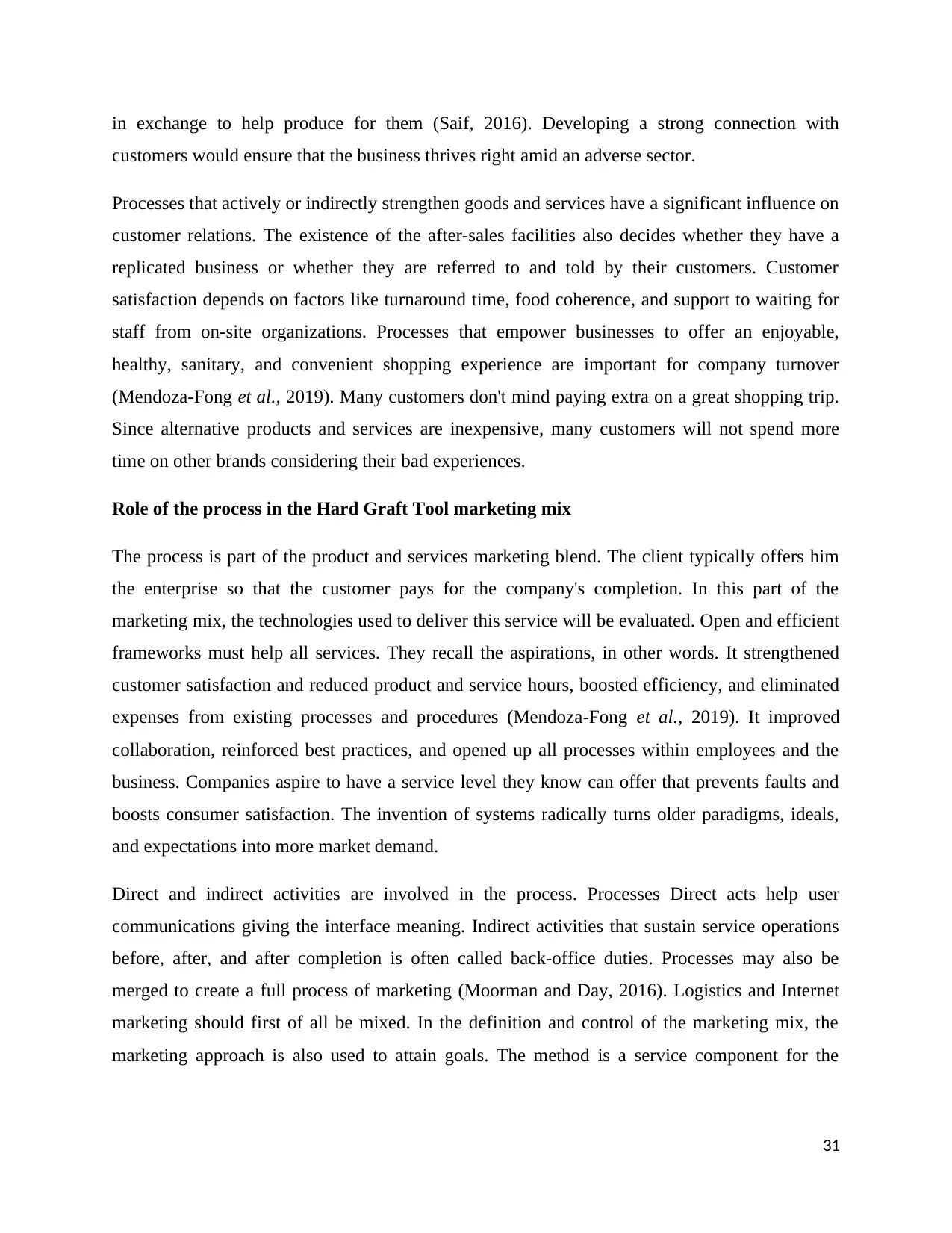
in exchange to help produce for them (Saif, 2016). Developing a strong connection with
customers would ensure that the business thrives right amid an adverse sector.
Processes that actively or indirectly strengthen goods and services have a significant influence on
customer relations. The existence of the after-sales facilities also decides whether they have a
replicated business or whether they are referred to and told by their customers. Customer
satisfaction depends on factors like turnaround time, food coherence, and support to waiting for
staff from on-site organizations. Processes that empower businesses to offer an enjoyable,
healthy, sanitary, and convenient shopping experience are important for company turnover
(Mendoza-Fong et al., 2019). Many customers don't mind paying extra on a great shopping trip.
Since alternative products and services are inexpensive, many customers will not spend more
time on other brands considering their bad experiences.
Role of the process in the Hard Graft Tool marketing mix
The process is part of the product and services marketing blend. The client typically offers him
the enterprise so that the customer pays for the company's completion. In this part of the
marketing mix, the technologies used to deliver this service will be evaluated. Open and efficient
frameworks must help all services. They recall the aspirations, in other words. It strengthened
customer satisfaction and reduced product and service hours, boosted efficiency, and eliminated
expenses from existing processes and procedures (Mendoza-Fong et al., 2019). It improved
collaboration, reinforced best practices, and opened up all processes within employees and the
business. Companies aspire to have a service level they know can offer that prevents faults and
boosts consumer satisfaction. The invention of systems radically turns older paradigms, ideals,
and expectations into more market demand.
Direct and indirect activities are involved in the process. Processes Direct acts help user
communications giving the interface meaning. Indirect activities that sustain service operations
before, after, and after completion is often called back-office duties. Processes may also be
merged to create a full process of marketing (Moorman and Day, 2016). Logistics and Internet
marketing should first of all be mixed. In the definition and control of the marketing mix, the
marketing approach is also used to attain goals. The method is a service component for the
31
customers would ensure that the business thrives right amid an adverse sector.
Processes that actively or indirectly strengthen goods and services have a significant influence on
customer relations. The existence of the after-sales facilities also decides whether they have a
replicated business or whether they are referred to and told by their customers. Customer
satisfaction depends on factors like turnaround time, food coherence, and support to waiting for
staff from on-site organizations. Processes that empower businesses to offer an enjoyable,
healthy, sanitary, and convenient shopping experience are important for company turnover
(Mendoza-Fong et al., 2019). Many customers don't mind paying extra on a great shopping trip.
Since alternative products and services are inexpensive, many customers will not spend more
time on other brands considering their bad experiences.
Role of the process in the Hard Graft Tool marketing mix
The process is part of the product and services marketing blend. The client typically offers him
the enterprise so that the customer pays for the company's completion. In this part of the
marketing mix, the technologies used to deliver this service will be evaluated. Open and efficient
frameworks must help all services. They recall the aspirations, in other words. It strengthened
customer satisfaction and reduced product and service hours, boosted efficiency, and eliminated
expenses from existing processes and procedures (Mendoza-Fong et al., 2019). It improved
collaboration, reinforced best practices, and opened up all processes within employees and the
business. Companies aspire to have a service level they know can offer that prevents faults and
boosts consumer satisfaction. The invention of systems radically turns older paradigms, ideals,
and expectations into more market demand.
Direct and indirect activities are involved in the process. Processes Direct acts help user
communications giving the interface meaning. Indirect activities that sustain service operations
before, after, and after completion is often called back-office duties. Processes may also be
merged to create a full process of marketing (Moorman and Day, 2016). Logistics and Internet
marketing should first of all be mixed. In the definition and control of the marketing mix, the
marketing approach is also used to attain goals. The method is a service component for the
31
Paraphrase This Document
Need a fresh take? Get an instant paraphrase of this document with our AI Paraphraser
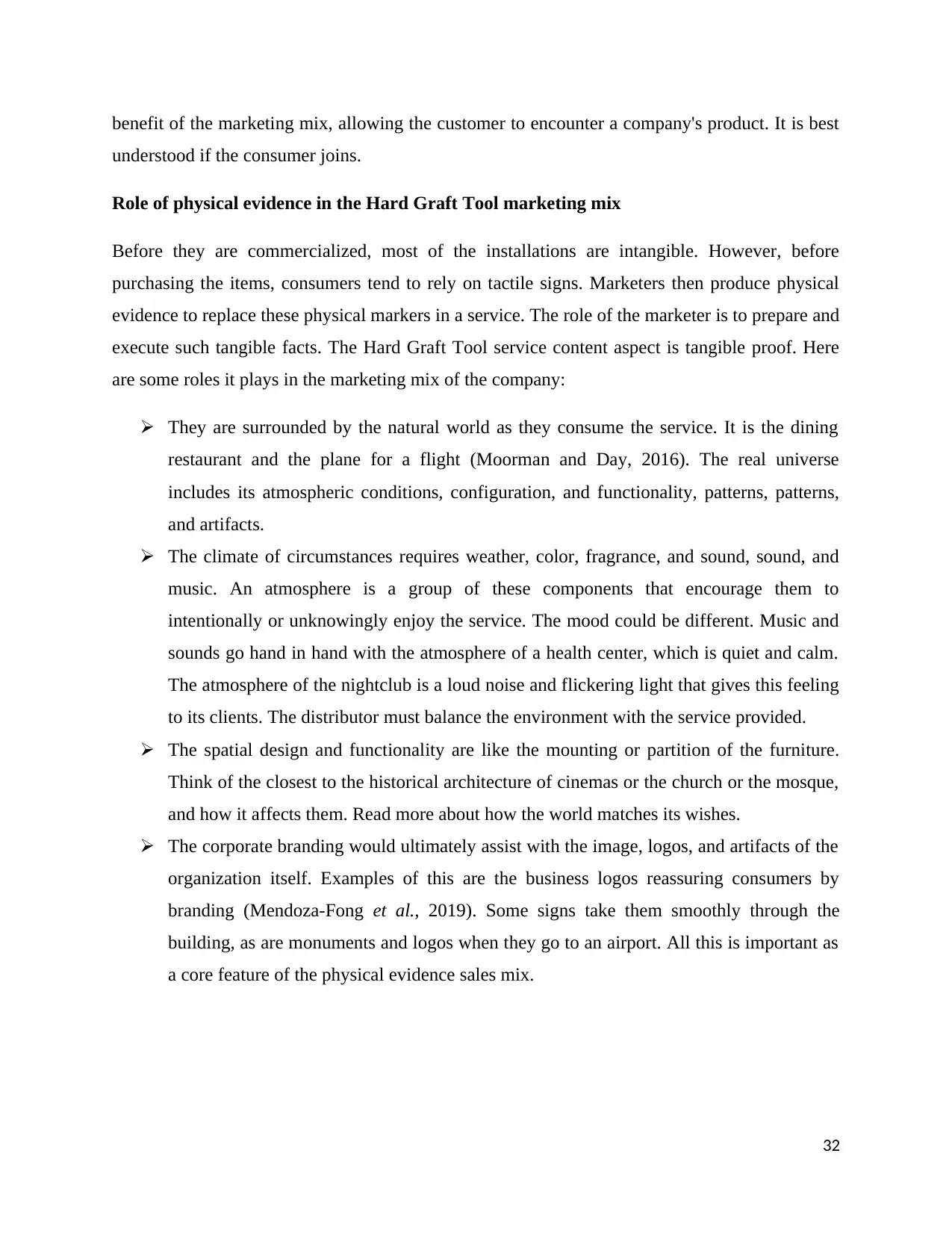
benefit of the marketing mix, allowing the customer to encounter a company's product. It is best
understood if the consumer joins.
Role of physical evidence in the Hard Graft Tool marketing mix
Before they are commercialized, most of the installations are intangible. However, before
purchasing the items, consumers tend to rely on tactile signs. Marketers then produce physical
evidence to replace these physical markers in a service. The role of the marketer is to prepare and
execute such tangible facts. The Hard Graft Tool service content aspect is tangible proof. Here
are some roles it plays in the marketing mix of the company:
They are surrounded by the natural world as they consume the service. It is the dining
restaurant and the plane for a flight (Moorman and Day, 2016). The real universe
includes its atmospheric conditions, configuration, and functionality, patterns, patterns,
and artifacts.
The climate of circumstances requires weather, color, fragrance, and sound, sound, and
music. An atmosphere is a group of these components that encourage them to
intentionally or unknowingly enjoy the service. The mood could be different. Music and
sounds go hand in hand with the atmosphere of a health center, which is quiet and calm.
The atmosphere of the nightclub is a loud noise and flickering light that gives this feeling
to its clients. The distributor must balance the environment with the service provided.
The spatial design and functionality are like the mounting or partition of the furniture.
Think of the closest to the historical architecture of cinemas or the church or the mosque,
and how it affects them. Read more about how the world matches its wishes.
The corporate branding would ultimately assist with the image, logos, and artifacts of the
organization itself. Examples of this are the business logos reassuring consumers by
branding (Mendoza-Fong et al., 2019). Some signs take them smoothly through the
building, as are monuments and logos when they go to an airport. All this is important as
a core feature of the physical evidence sales mix.
32
understood if the consumer joins.
Role of physical evidence in the Hard Graft Tool marketing mix
Before they are commercialized, most of the installations are intangible. However, before
purchasing the items, consumers tend to rely on tactile signs. Marketers then produce physical
evidence to replace these physical markers in a service. The role of the marketer is to prepare and
execute such tangible facts. The Hard Graft Tool service content aspect is tangible proof. Here
are some roles it plays in the marketing mix of the company:
They are surrounded by the natural world as they consume the service. It is the dining
restaurant and the plane for a flight (Moorman and Day, 2016). The real universe
includes its atmospheric conditions, configuration, and functionality, patterns, patterns,
and artifacts.
The climate of circumstances requires weather, color, fragrance, and sound, sound, and
music. An atmosphere is a group of these components that encourage them to
intentionally or unknowingly enjoy the service. The mood could be different. Music and
sounds go hand in hand with the atmosphere of a health center, which is quiet and calm.
The atmosphere of the nightclub is a loud noise and flickering light that gives this feeling
to its clients. The distributor must balance the environment with the service provided.
The spatial design and functionality are like the mounting or partition of the furniture.
Think of the closest to the historical architecture of cinemas or the church or the mosque,
and how it affects them. Read more about how the world matches its wishes.
The corporate branding would ultimately assist with the image, logos, and artifacts of the
organization itself. Examples of this are the business logos reassuring consumers by
branding (Mendoza-Fong et al., 2019). Some signs take them smoothly through the
building, as are monuments and logos when they go to an airport. All this is important as
a core feature of the physical evidence sales mix.
32
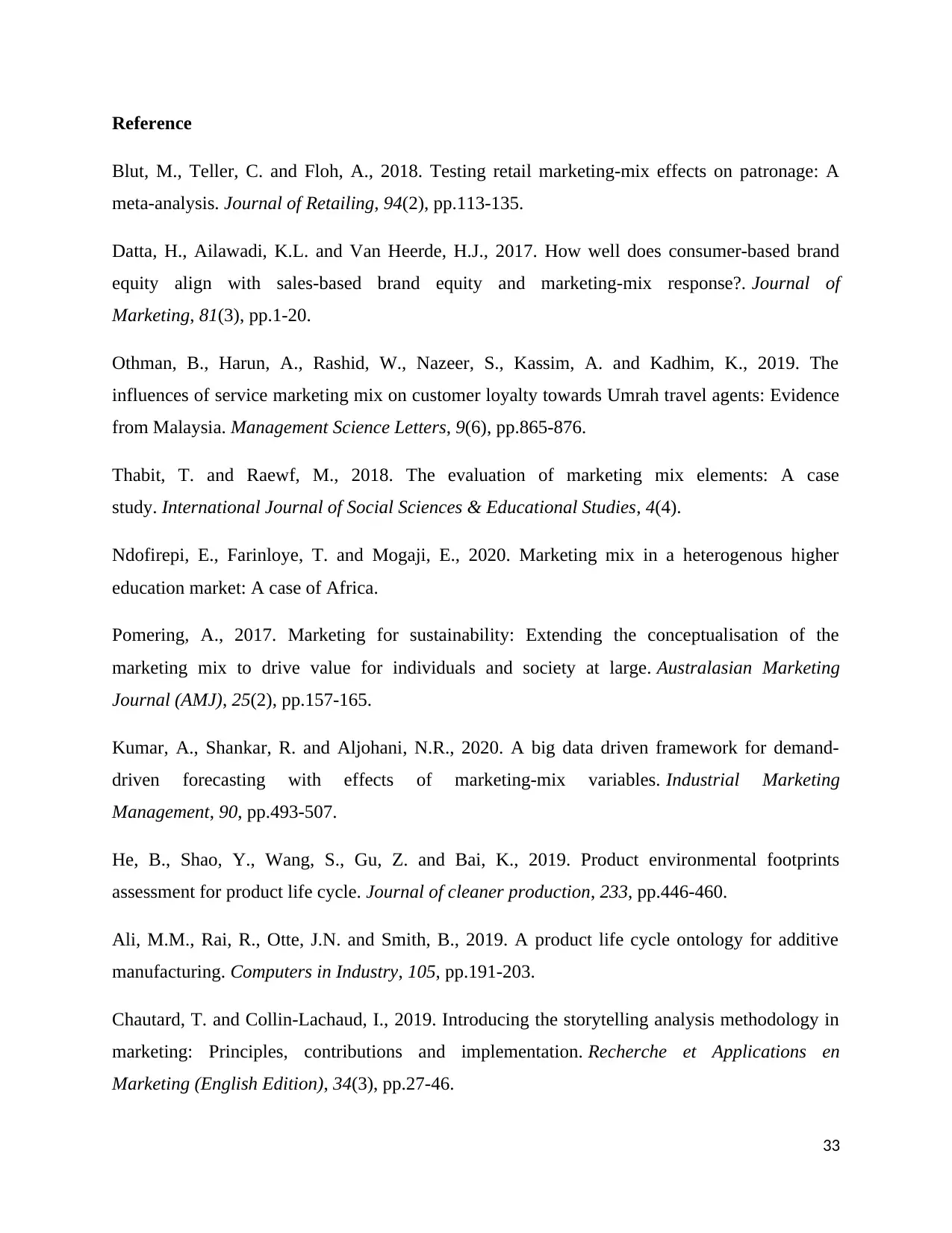
Reference
Blut, M., Teller, C. and Floh, A., 2018. Testing retail marketing-mix effects on patronage: A
meta-analysis. Journal of Retailing, 94(2), pp.113-135.
Datta, H., Ailawadi, K.L. and Van Heerde, H.J., 2017. How well does consumer-based brand
equity align with sales-based brand equity and marketing-mix response?. Journal of
Marketing, 81(3), pp.1-20.
Othman, B., Harun, A., Rashid, W., Nazeer, S., Kassim, A. and Kadhim, K., 2019. The
influences of service marketing mix on customer loyalty towards Umrah travel agents: Evidence
from Malaysia. Management Science Letters, 9(6), pp.865-876.
Thabit, T. and Raewf, M., 2018. The evaluation of marketing mix elements: A case
study. International Journal of Social Sciences & Educational Studies, 4(4).
Ndofirepi, E., Farinloye, T. and Mogaji, E., 2020. Marketing mix in a heterogenous higher
education market: A case of Africa.
Pomering, A., 2017. Marketing for sustainability: Extending the conceptualisation of the
marketing mix to drive value for individuals and society at large. Australasian Marketing
Journal (AMJ), 25(2), pp.157-165.
Kumar, A., Shankar, R. and Aljohani, N.R., 2020. A big data driven framework for demand-
driven forecasting with effects of marketing-mix variables. Industrial Marketing
Management, 90, pp.493-507.
He, B., Shao, Y., Wang, S., Gu, Z. and Bai, K., 2019. Product environmental footprints
assessment for product life cycle. Journal of cleaner production, 233, pp.446-460.
Ali, M.M., Rai, R., Otte, J.N. and Smith, B., 2019. A product life cycle ontology for additive
manufacturing. Computers in Industry, 105, pp.191-203.
Chautard, T. and Collin-Lachaud, I., 2019. Introducing the storytelling analysis methodology in
marketing: Principles, contributions and implementation. Recherche et Applications en
Marketing (English Edition), 34(3), pp.27-46.
33
Blut, M., Teller, C. and Floh, A., 2018. Testing retail marketing-mix effects on patronage: A
meta-analysis. Journal of Retailing, 94(2), pp.113-135.
Datta, H., Ailawadi, K.L. and Van Heerde, H.J., 2017. How well does consumer-based brand
equity align with sales-based brand equity and marketing-mix response?. Journal of
Marketing, 81(3), pp.1-20.
Othman, B., Harun, A., Rashid, W., Nazeer, S., Kassim, A. and Kadhim, K., 2019. The
influences of service marketing mix on customer loyalty towards Umrah travel agents: Evidence
from Malaysia. Management Science Letters, 9(6), pp.865-876.
Thabit, T. and Raewf, M., 2018. The evaluation of marketing mix elements: A case
study. International Journal of Social Sciences & Educational Studies, 4(4).
Ndofirepi, E., Farinloye, T. and Mogaji, E., 2020. Marketing mix in a heterogenous higher
education market: A case of Africa.
Pomering, A., 2017. Marketing for sustainability: Extending the conceptualisation of the
marketing mix to drive value for individuals and society at large. Australasian Marketing
Journal (AMJ), 25(2), pp.157-165.
Kumar, A., Shankar, R. and Aljohani, N.R., 2020. A big data driven framework for demand-
driven forecasting with effects of marketing-mix variables. Industrial Marketing
Management, 90, pp.493-507.
He, B., Shao, Y., Wang, S., Gu, Z. and Bai, K., 2019. Product environmental footprints
assessment for product life cycle. Journal of cleaner production, 233, pp.446-460.
Ali, M.M., Rai, R., Otte, J.N. and Smith, B., 2019. A product life cycle ontology for additive
manufacturing. Computers in Industry, 105, pp.191-203.
Chautard, T. and Collin-Lachaud, I., 2019. Introducing the storytelling analysis methodology in
marketing: Principles, contributions and implementation. Recherche et Applications en
Marketing (English Edition), 34(3), pp.27-46.
33
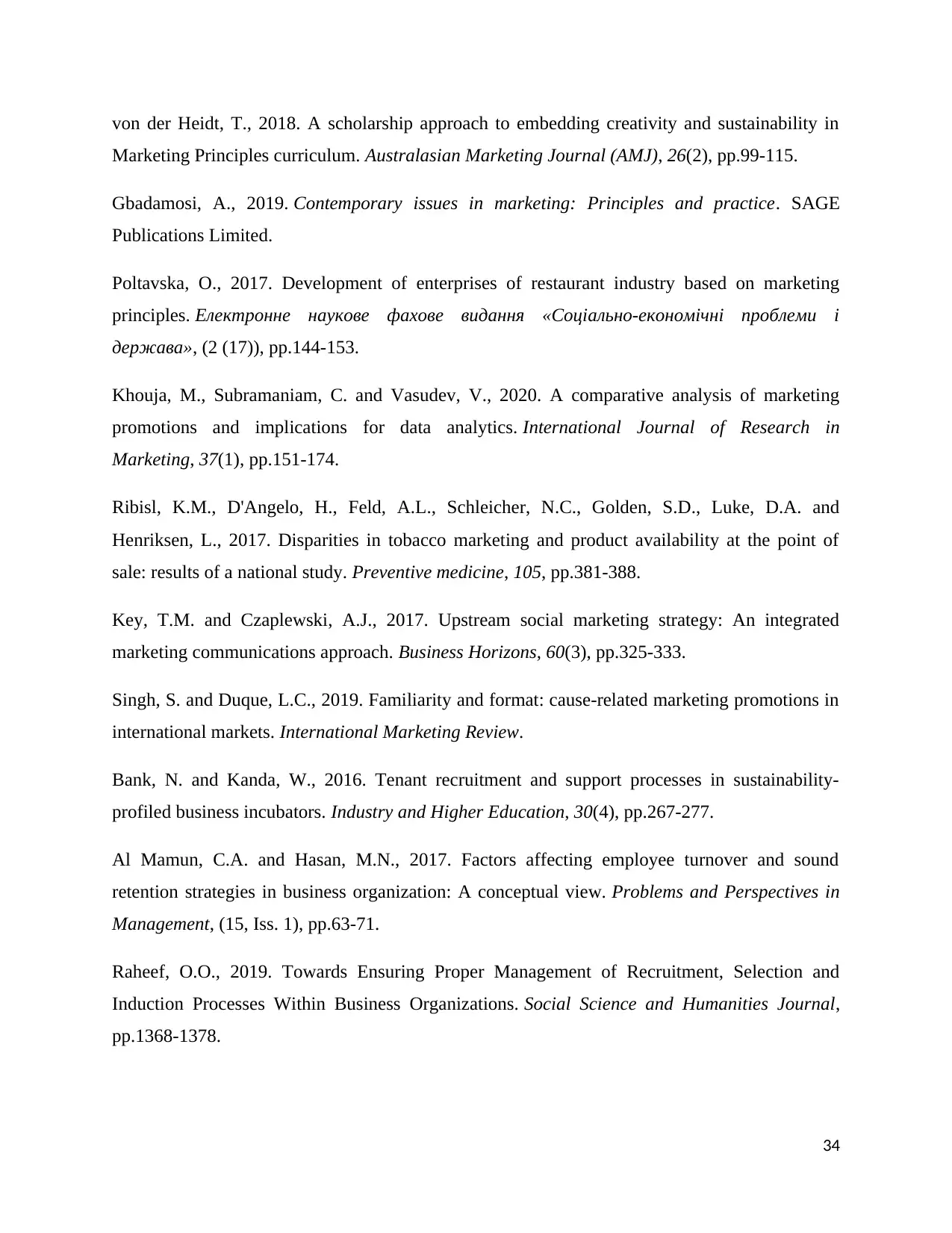
von der Heidt, T., 2018. A scholarship approach to embedding creativity and sustainability in
Marketing Principles curriculum. Australasian Marketing Journal (AMJ), 26(2), pp.99-115.
Gbadamosi, A., 2019. Contemporary issues in marketing: Principles and practice. SAGE
Publications Limited.
Poltavska, O., 2017. Development of enterprises of restaurant industry based on marketing
principles. Електронне наукове фахове видання «Соціально-економічні проблеми і
держава», (2 (17)), pp.144-153.
Khouja, M., Subramaniam, C. and Vasudev, V., 2020. A comparative analysis of marketing
promotions and implications for data analytics. International Journal of Research in
Marketing, 37(1), pp.151-174.
Ribisl, K.M., D'Angelo, H., Feld, A.L., Schleicher, N.C., Golden, S.D., Luke, D.A. and
Henriksen, L., 2017. Disparities in tobacco marketing and product availability at the point of
sale: results of a national study. Preventive medicine, 105, pp.381-388.
Key, T.M. and Czaplewski, A.J., 2017. Upstream social marketing strategy: An integrated
marketing communications approach. Business Horizons, 60(3), pp.325-333.
Singh, S. and Duque, L.C., 2019. Familiarity and format: cause-related marketing promotions in
international markets. International Marketing Review.
Bank, N. and Kanda, W., 2016. Tenant recruitment and support processes in sustainability-
profiled business incubators. Industry and Higher Education, 30(4), pp.267-277.
Al Mamun, C.A. and Hasan, M.N., 2017. Factors affecting employee turnover and sound
retention strategies in business organization: A conceptual view. Problems and Perspectives in
Management, (15, Iss. 1), pp.63-71.
Raheef, O.O., 2019. Towards Ensuring Proper Management of Recruitment, Selection and
Induction Processes Within Business Organizations. Social Science and Humanities Journal,
pp.1368-1378.
34
Marketing Principles curriculum. Australasian Marketing Journal (AMJ), 26(2), pp.99-115.
Gbadamosi, A., 2019. Contemporary issues in marketing: Principles and practice. SAGE
Publications Limited.
Poltavska, O., 2017. Development of enterprises of restaurant industry based on marketing
principles. Електронне наукове фахове видання «Соціально-економічні проблеми і
держава», (2 (17)), pp.144-153.
Khouja, M., Subramaniam, C. and Vasudev, V., 2020. A comparative analysis of marketing
promotions and implications for data analytics. International Journal of Research in
Marketing, 37(1), pp.151-174.
Ribisl, K.M., D'Angelo, H., Feld, A.L., Schleicher, N.C., Golden, S.D., Luke, D.A. and
Henriksen, L., 2017. Disparities in tobacco marketing and product availability at the point of
sale: results of a national study. Preventive medicine, 105, pp.381-388.
Key, T.M. and Czaplewski, A.J., 2017. Upstream social marketing strategy: An integrated
marketing communications approach. Business Horizons, 60(3), pp.325-333.
Singh, S. and Duque, L.C., 2019. Familiarity and format: cause-related marketing promotions in
international markets. International Marketing Review.
Bank, N. and Kanda, W., 2016. Tenant recruitment and support processes in sustainability-
profiled business incubators. Industry and Higher Education, 30(4), pp.267-277.
Al Mamun, C.A. and Hasan, M.N., 2017. Factors affecting employee turnover and sound
retention strategies in business organization: A conceptual view. Problems and Perspectives in
Management, (15, Iss. 1), pp.63-71.
Raheef, O.O., 2019. Towards Ensuring Proper Management of Recruitment, Selection and
Induction Processes Within Business Organizations. Social Science and Humanities Journal,
pp.1368-1378.
34
Secure Best Marks with AI Grader
Need help grading? Try our AI Grader for instant feedback on your assignments.
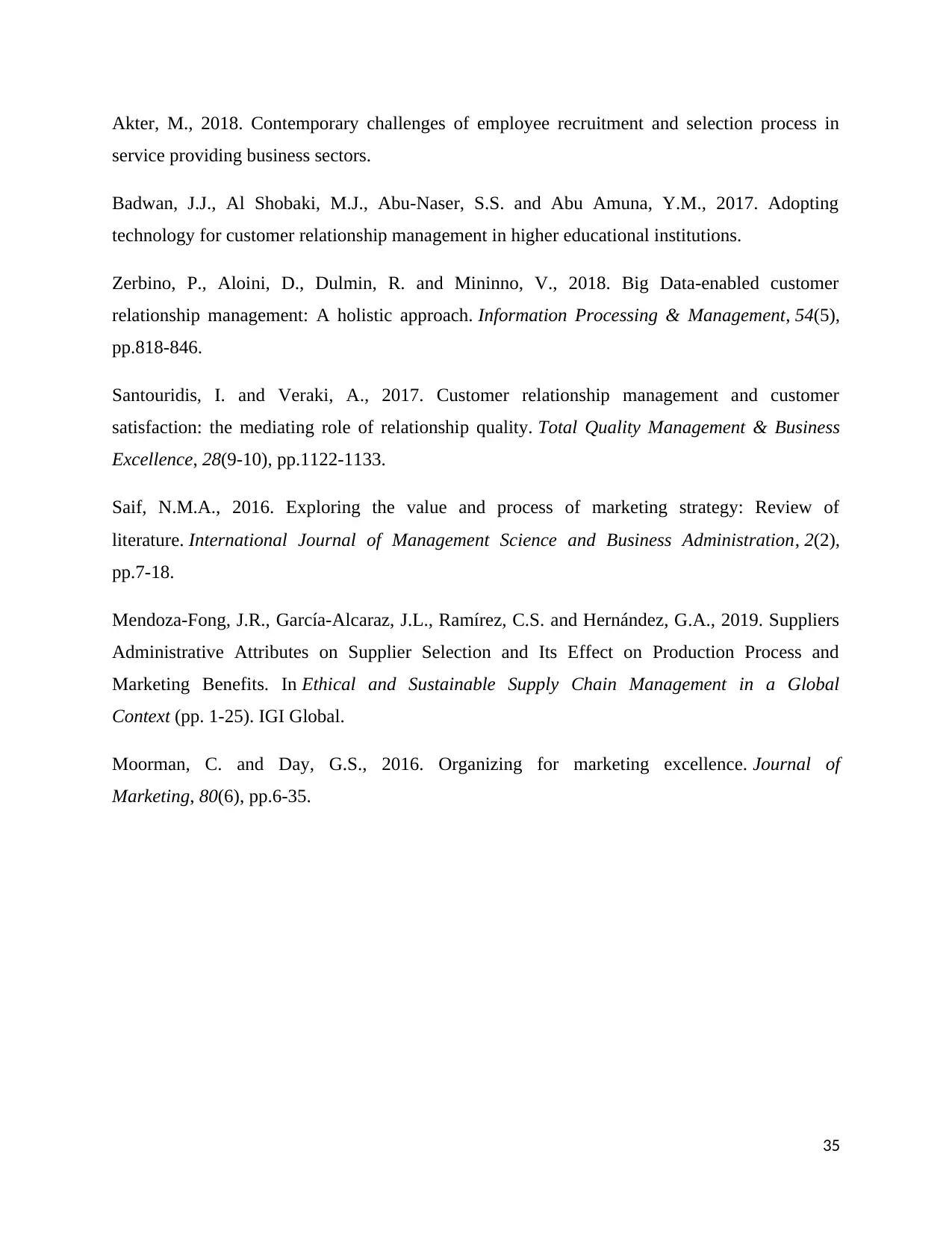
Akter, M., 2018. Contemporary challenges of employee recruitment and selection process in
service providing business sectors.
Badwan, J.J., Al Shobaki, M.J., Abu-Naser, S.S. and Abu Amuna, Y.M., 2017. Adopting
technology for customer relationship management in higher educational institutions.
Zerbino, P., Aloini, D., Dulmin, R. and Mininno, V., 2018. Big Data-enabled customer
relationship management: A holistic approach. Information Processing & Management, 54(5),
pp.818-846.
Santouridis, I. and Veraki, A., 2017. Customer relationship management and customer
satisfaction: the mediating role of relationship quality. Total Quality Management & Business
Excellence, 28(9-10), pp.1122-1133.
Saif, N.M.A., 2016. Exploring the value and process of marketing strategy: Review of
literature. International Journal of Management Science and Business Administration, 2(2),
pp.7-18.
Mendoza-Fong, J.R., García-Alcaraz, J.L., Ramírez, C.S. and Hernández, G.A., 2019. Suppliers
Administrative Attributes on Supplier Selection and Its Effect on Production Process and
Marketing Benefits. In Ethical and Sustainable Supply Chain Management in a Global
Context (pp. 1-25). IGI Global.
Moorman, C. and Day, G.S., 2016. Organizing for marketing excellence. Journal of
Marketing, 80(6), pp.6-35.
35
service providing business sectors.
Badwan, J.J., Al Shobaki, M.J., Abu-Naser, S.S. and Abu Amuna, Y.M., 2017. Adopting
technology for customer relationship management in higher educational institutions.
Zerbino, P., Aloini, D., Dulmin, R. and Mininno, V., 2018. Big Data-enabled customer
relationship management: A holistic approach. Information Processing & Management, 54(5),
pp.818-846.
Santouridis, I. and Veraki, A., 2017. Customer relationship management and customer
satisfaction: the mediating role of relationship quality. Total Quality Management & Business
Excellence, 28(9-10), pp.1122-1133.
Saif, N.M.A., 2016. Exploring the value and process of marketing strategy: Review of
literature. International Journal of Management Science and Business Administration, 2(2),
pp.7-18.
Mendoza-Fong, J.R., García-Alcaraz, J.L., Ramírez, C.S. and Hernández, G.A., 2019. Suppliers
Administrative Attributes on Supplier Selection and Its Effect on Production Process and
Marketing Benefits. In Ethical and Sustainable Supply Chain Management in a Global
Context (pp. 1-25). IGI Global.
Moorman, C. and Day, G.S., 2016. Organizing for marketing excellence. Journal of
Marketing, 80(6), pp.6-35.
35
1 out of 35
Related Documents
Your All-in-One AI-Powered Toolkit for Academic Success.
+13062052269
info@desklib.com
Available 24*7 on WhatsApp / Email
![[object Object]](/_next/static/media/star-bottom.7253800d.svg)
Unlock your academic potential
© 2024 | Zucol Services PVT LTD | All rights reserved.





